Paul van Yperen's Blog, page 252
November 30, 2018
Photo by Columbia
Columbia Pictures or Columbia is one of the 'Big Six' major American film studios, and was one of the 'Little Three' among the eight major film studios of Hollywood's Golden Age. Studio Mogul was the notoriously hard-driving and vulgar Harry Cohn. Initially Columbia had the worst reputation and smallest budgets, but in the late 1920s the studio began to grow, spurred by a successful association with director Frank Capra. In the 1930s, Columbia became one of the primary homes of the screwball comedy, and contract stars were Jean Arthur and Cary Grant. In the 1940s, Rita Hayworth became Columbia's premier star and Rosalind Russell, Glenn Ford, and William Holden also became major stars at the studio. Today, it has become the world's fifth largest major film studio and is a member of the Sony Pictures Motion Picture Group.
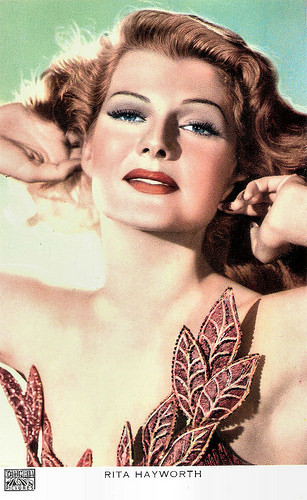
Rita Hayworth . Belgian postcard by Victoria, Brussels, no. 639. Photo: Columbia Pictures.
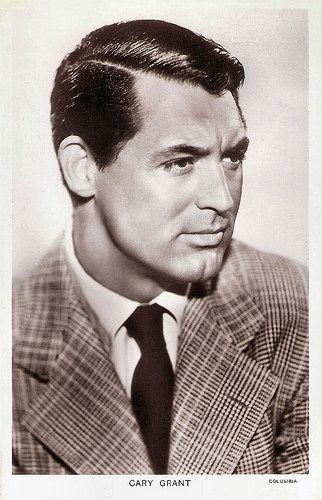
Cary Grant. British postcard in the Picturegoer Series, London, no. 735c. Photo: Columbia.
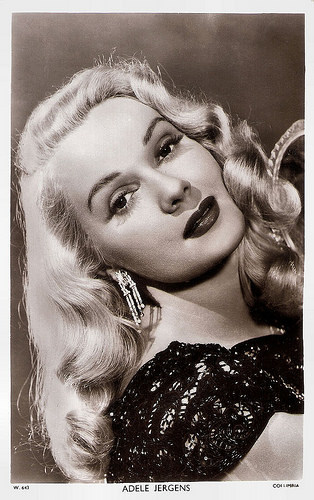
Adele Jergens. British postcard in Picturegoer Series, London, no. W 643. Photo: Columbia.
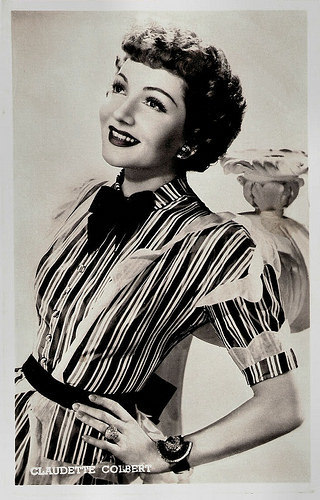
Claudette Colbert . Dutch postcard by J.S.A.. Photo: Columbia. Publicity still for Tomorrow is Forever (Irving Pichel, 1946).
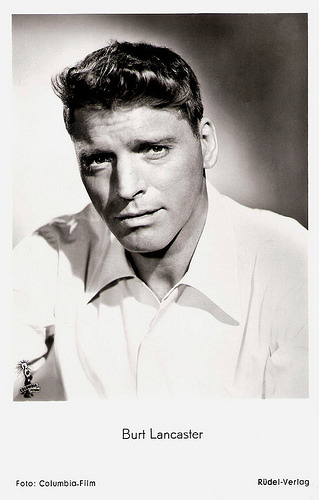
Burt Lancaster . German postcard by Franz Josef Rüdel, Filmpostkartenverlag, Hamburg-Bergedorf, no. 858. Photo: Columbia-Film. Publicity still for From Here to Eternity (Fred Zinnemann, 1953).
The Corned Beef and Cabbage Studio
Columbia was founded in June 1918 as Cohn-Brandt-Cohn (CBC) Film Sales by brothers Jack and Harry Cohn and Jack's best friend Joe Brandt. Jack had worked for Carl Laemmle at Universal, Joe had been Laemmle’s executive secretary and Jack’s younger brother Harry, had also worked at Universal.They released their first feature film in August 1922. Brandt was president of CBC Film Sales, handling sales, marketing and distribution from New York along with Jack Cohn, while Harry Cohn ran production in Hollywood.
The studio's early productions were low-budget short subjects: 'Screen Snapshots', the 'Hall Room Boys' (the vaudeville duo of Edward Flanagan and Neely Edwards), and the Chaplin imitator Billy West. The start-up CBC leased space in a Poverty Row studio on Hollywood's famously low-rent Gower Street. Among Hollywood's elite, the studio's small-time reputation led some to joke that CBC stood for 'Corned Beef and Cabbage'. Brandt eventually tired of dealing with the Cohn brothers, and he sold his one-third stake to Harry Cohn, who took over as president.
In an effort to improve its image, the Cohn brothers renamed the company Columbia Pictures Corporation in 1924. Cohn remained head of production as well, thus concentrating enormous power in his hands. He would run Columbia for the next 34 years, the second-longest tenure of any studio chief, behind only Warner Bros.' Jack L. Warner. Even in an industry rife with nepotism, Columbia was particularly notorious for having a number of Harry and Jack's relatives in high positions. Humorist Robert Benchley called it the Pine Tree Studio, "because it has so many Cohns".
Columbia's product line consisted mostly of moderately budgeted features and short subjects including comedies, sports films, various serials, and cartoons. Columbia gradually moved into the production of higher-budget fare, eventually joining the second tier of Hollywood studios along with United Artists and Universal. Like United Artists and Universal, Columbia was a horizontally integrated company. It controlled production and distribution; it did not own any theatres.
Helping Columbia's climb was the arrival of an ambitious director, Frank Capra. Between 1927 and 1939, Capra constantly pushed Cohn for better material and bigger budgets. A string of hits he directed in the early and mid 1930s solidified Columbia's status as a major studio. In particular, It Happened One Night (Frank Capra, 1934) with Clark Gable and Claudette Colbert put Columbia on the map. It won the Academy Award for Best Film of 1934.
Until then, Columbia's very existence had depended on theatre owners willing to take its films, since as mentioned above it didn't have a theatre network of its own. Other Capra-directed hits followed, including Mr. Deeds Goes to Town (Frank Capra, 1936), the original version of Lost Horizon (Frank Capra, 1937) with Ronald Colman , You Can’t Take it With You (Frank Capra, 1938), which was Capra's highest-grossing picture at Columbia, and Mr. Smith Goes to Washington (Frank Capra, 1939), which made James Stewart a major star.
Capra but also Howard Hawks and others made some of the finest screwball comedies of the 1930s for Columbia: The Awful Truth (Leo McCarey, 1937), Holiday (George Cukor, 1938), and His Girl Friday (Howard Hawks, 1940), all starring Cary Grant. After Capra’s departure in 1939, Columbia languished because leading directors were reluctant to work for the notoriously hard-driving and vulgar Cohn.
In 1938, the addition of B. B. Kahane as Vice President would produce Charles Vidor's Those High Gray Walls (Charles Vidor, 1939), and The Lady in Question (Charles Vidor, 1940), the first joint film of Rita Hayworth and Glenn Ford. Kahane would later become the President of Academy of Motion Picture Arts and Sciences in 1959, until his death a year later.
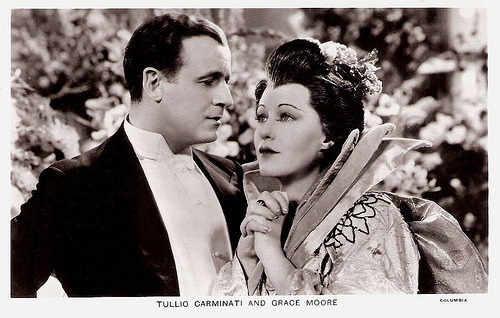
Tullio Carminati and Grace Moore. British postcard in the Film Partners Series, London, no. P 151. Photo: Columbia. Publicity still for One Night of Love (Victor Schertzinger, 1934).
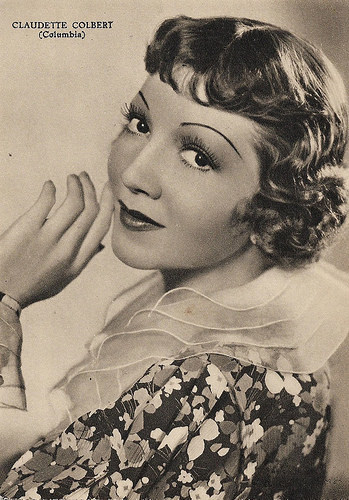
Claudette Colbert . Italian postcard by Rizzoli, Milano, 1937. Photo: Columbia.
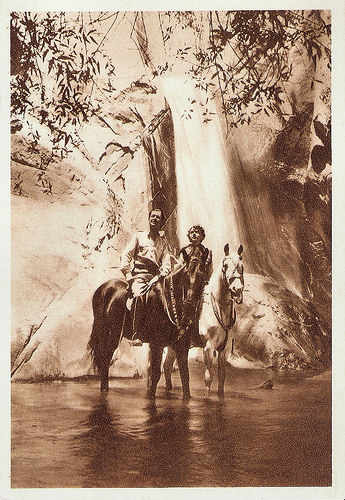
Ronald Colman and Jane Wyatt. Italian postcard by Vecchioni & Guadagno, Roma. Photo: Columbia EIA. Publicity still for Lost Horizon (Frank Capra, 1937).
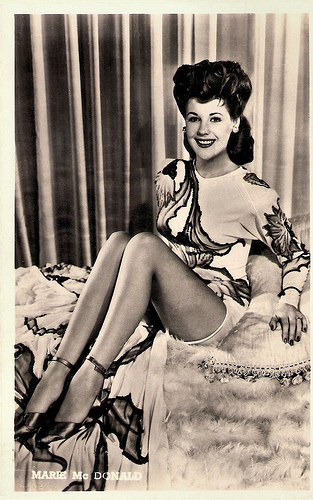
Marie McDonald. Dutch postcard by J.S.A. Photo: Columbia.
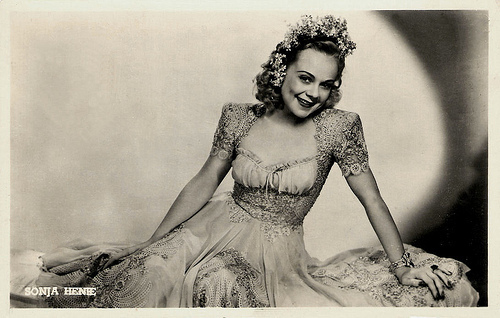
Sonja Henie . Dutch Postcard by J.S.A. Photo: Columbia F.B. / M.P.E.
Hollywood's Siberia for the less obedient stars
Columbia could not afford to keep a huge roster of contract stars, so Cohn usually borrowed them from other studios. At Metro-Goldwyn-Mayer, the industry's most prestigious studio, Columbia was nicknamed 'Siberia, as Louis B. Mayer would use the loan out to Columbia as a way to punish his less-obedient signings. In the 1930s, Columbia signed Jean Arthur to a long-term contract, and after The Whole Town's Talking (John Ford, 1935), Arthur became a major comedy star. Ann Sothern's career was launched when Columbia signed her to a contract in 1936. Cary Grant signed a contract in 1937 and soon after it was altered to a non-exclusive contract shared with RKO.
Many theatres relied on Westerns to attract big weekend audiences, and Columbia always recognised this market. Its first cowboy star was Buck Jones, who signed with Columbia in 1930 for a fraction of his former big-studio salary. Over the next two decades Columbia released scores of outdoor adventures with Jones, Tim McCoy, Ken Maynard, Robert (Tex) Allen, and Gene Autry. Columbia's most popular cowboy was Charles Starrett, who signed with Columbia in 1935 and starred in 131 western features over 17 years.
At Harry Cohn's insistence the studio signed The Three Stooges in 1934. MGM had let the Stooges go but kept straight-man Ted Healy. The Stooges made 190 shorts for Columbia between 1934 and 1957. Columbia's short-subject department employed many famous comedians, including Buster Keaton , Charley Chase, Harry Langdon, and Hugh Herbert. Almost 400 of Columbia's 529 two-reel comedies were released to television between 1958 and 1961; and have since been released to home video.
In the early 1930s, Columbia distributed Walt Disney's famous Mickey Mouse cartoons. In 1933, the studio established its own animation house, under the Screen Gems brand. Columbia's leading cartoon series were Krazy Kat, Scrappy, The Fox and the Crow, and (very briefly) Li'l Abner. In 1949, Columbia agreed to release animated shorts from United Productions of America. These new shorts were more sophisticated than Columbia's older cartoons, and many won critical praise and industry awards.
According to Bob Thomas' book King Cohn, studio chief Harry Cohn always placed a high priority on serials. Beginning in 1937, Columbia entered the lucrative serial market, and kept making these episodic adventures until 1956, after other studios had discontinued them. The most famous Columbia serials are based on comic-strip or radio characters: Mandrake the Magician, The Shadow, Terry and the Pirates, Batman, and Superman, among many others.
Columbia also produced musical shorts, sports reels (usually narrated by sportscaster Bill Stern), and travelogues. Its 'Screen Snapshots' series, showing behind-the-scenes footage of Hollywood stars, was a Columbia perennial; producer-director Ralph Staub kept this series going through 1958.
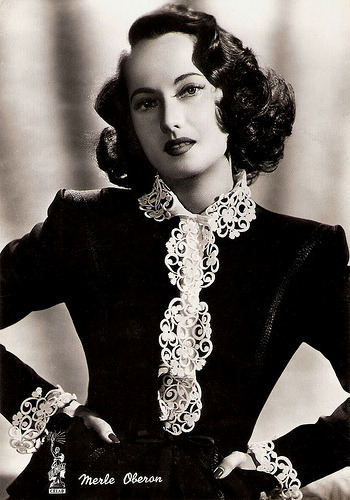
Merle Oberon . Italian postcard by Rotalfoto, Milano, no. 46. Photo: Columbia C.E.I.A.D.
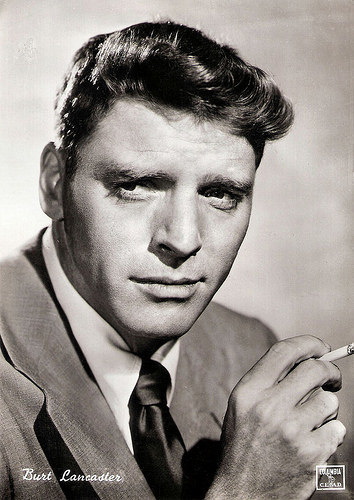
Burt Lancaster . Italian postcard by Bromofoto, no. 957. Photo: Columbia C.E.I.A.D.
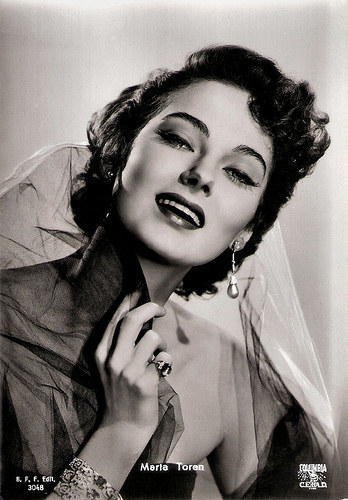
Marta Toren . Italian postcard by B.F.F. Edit., no. 3048. Photo: Columbia C.E.I.A.D.
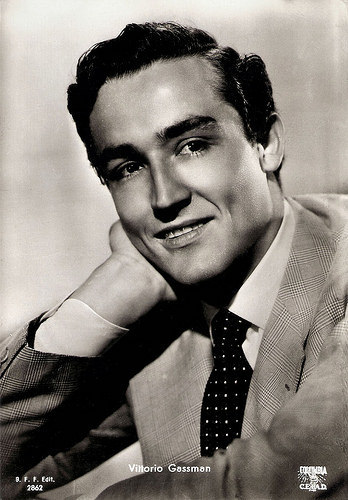
Vittorio Gassman . Italian postcard by Casa Editr. Ballerini & Fratini, Firenze (B.F.F. Edit.), no. 2962. Photo: Columbia C.E.I.A.D.
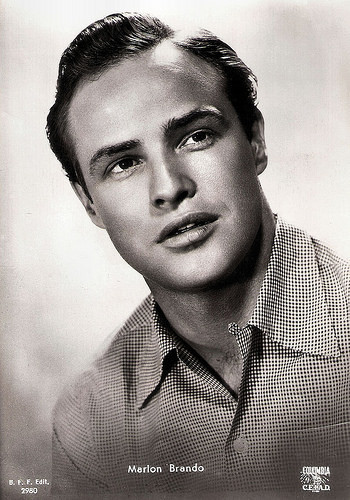
Marlon Brando . Italian postcard by B.F.F. Edit., no. 2980. Photo: Columbia C.E.I.A.D.
Columbia's efficient recycling policy
In the 1940s, Columbia propelled in part by their film's surge in audiences during the war, and also benefited from the popularity of its biggest star, Rita Hayworth . Columbia maintained a long list of contractees well into the 1950s: Glenn Ford, William Holden, Judy Holliday, The Three Stooges, Ann Miller, Jack Lemmon, Adele Jergens, Lucille Ball, Kerwin Mathews, Kim Novak , and others.
Harry Cohn monitored the budgets of his films, and the studio got the maximum use out of costly sets, costumes, and props by reusing them in other films. Many of Columbia's low-budget B-films and short subjects have an expensive look, thanks to Columbia's efficient recycling policy. Cohn was reluctant to spend lavish sums on even his most important pictures, and it was not until 1943 that he agreed to use three-strip Technicolor in a live-action feature.
Columbia's first Technicolor feature was the Western The Desperadoes, starring Randolph Scott and Glenn Ford. Cohn quickly used Technicolor again for Cover Girl (Charles Vidor, 1944), a Hayworth vehicle that instantly was a smash hit, and for the fanciful biography of Frédéric Chopin, A Song to Remember (Charles Vidor, 1945), with Cornel Wilde and Merle Oberon . Another biopic, The Jolson Story (Alfred E. Green, 1946) with Larry Parks, was started in black-and-white, but when Cohn saw how well the project was proceeding, he scrapped the footage and insisted on filming in Technicolor.
In 1948, the United States v. Paramount Pictures, Inc. anti-trust decision forced Hollywood motion picture companies to divest themselves of the theatre chains that they owned. Since Columbia did not own any theatres, it was now on equal terms with the largest studios, and soon replaced RKO on the list of the Big Five studios.
By 1950, Columbia had discontinued most of its popular series films like Boston Blackie, Blondie, The Lone Wolf, etc. Only Jungle Jim featuring Johnny Weissmuller , launched by producer Sam Katzman in 1949, kept going through 1955. Katzman contributed greatly to Columbia's success by producing dozens of topical feature films, including crime dramas, Science-Fiction stories, and Rock-'n'-Roll musicals. Columbia kept making serials until 1956 and two-reel comedies until 1957, after other studios had abandoned them.
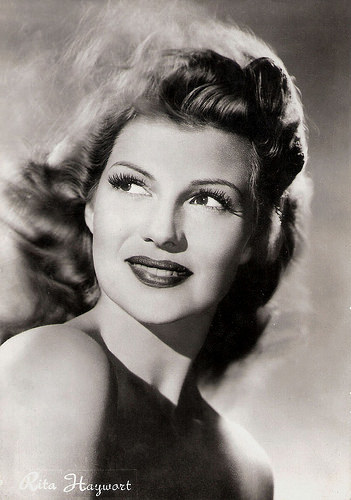
Rita Hayworth . Italian postcard by Bromofoto, no. 284.
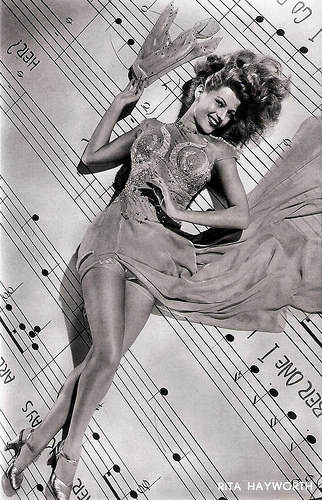
Rita Hayworth . Dutch postcard, Col. Int., no. 286. Photo: Columbia. Publicity still for Cover Girl (Charles Vidor, 1944).
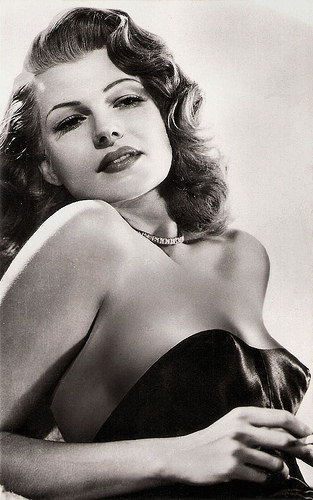
Rita Hayworth . Spanish postcard, no. 4026. Photo: Robert Coburn / Columbia Pictures. Publicity still for Gilda (Charles Vidor, 1946).
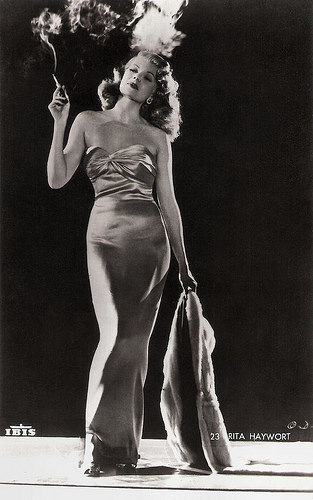
Rita Hayworth . Vintage card by IBIS, no. 23. Photo: Robert Coburn / Columbia Pictures. Publicity still for Gilda (Charles Vidor, 1946). Costume by Jean Louis.
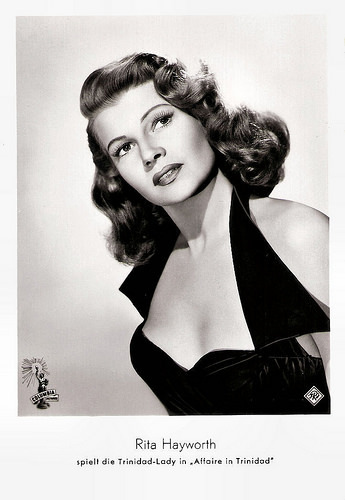
Rita Hayworth . German postcard by F.J. Rüdel Filmpostkartenverlag, Hamburg-Bergedorf, no. 423. Photo: Columbia. Publicity still for Affair in Trinidad (Vincent Sherman, 1952).
Backing independent producers and directors
As the larger studios declined in the 1950s, Columbia's position improved. This was largely because it did not suffer from the massive loss of income that the other major studios suffered from losing their theatres. Columbia backed various independent producers and directors, among them Elia Kazan, Fred Zinnemann, David Lean, Robert Rossen, Otto Preminger, and Joseph Losey.
The studio continued to produce 40-plus pictures a year, offering productions that often broke ground and kept audiences coming to cinemas such as its adaptation of the controversial James Jones novel, From Here to Eternity (Fred Zinnemann, 1953) with Burt Lancaster , On the Waterfront (Elia Kazan, 1954) with Marlon Brando , and The Bridge on the River Kwai (David Lean, 1957) with William Holden, Jack Hawkins and Alec Guinness . All three films won the Best Picture Oscar.
Columbia president Harry Cohn died of a heart attack in February 1958. By 1966, the studio was suffering from box-office failures, and takeover rumours began surfacing. After turning down releasing Albert R. Broccoli's Eon Productions James Bond films, Columbia had hired Broccoli's former partner Irving Allen to produce the Matt Helm series with Dean Martin. Columbia also produced a James Bond spoof, Casino Royale (Val Guest, a.o., 1967), in conjunction with Charles K. Feldman, which held the adaptation rights for that novel. The studio also offered old-fashioned fare like A Man for All Seasons (Fred Zinnemann, 1966) and Oliver! (Carol Reed, 1968).
Columbia came back with the more contemporary Easy Rider (Dennis Hopper, 1969) with Peter Fonda, Five Easy Pieces (Bob Rafelson, 1970) starring Jack Nicholson, and The Last Picture Show (Peter Bogdanovich, 1971). During the 1970s, the studio re-emerged with hits like Close Encounters of the Third Kind (Steven Spielberg, 1977), Tootsie (Sydney Pollack, 1982), and Gandhi (Richard Attenborough, 1982). Columbia was purchased by The Coca-Cola Company in 1982. That same year, Columbia helped launch a new motion-picture studio, Tri-Star Pictures, which was merged with Columbia in 1987 to form Columbia Pictures Entertainment, Inc. In 1989 Columbia was acquired by the Sony Corporation of Japan.
The Columbia Pictures logo, featuring a woman carrying a torch and wearing a drape (representing Columbia, a personification of the United States), has gone through five major revisions. Originally in 1924, Columbia Pictures used a logo featuring a female Roman soldier holding a shield in her left hand and a stick of wheat in her right hand. The logo changed in 1928 with the woman wearing a draped flag and torch. The woman wore the stole and carried the palla of ancient Rome, and above her were the words A Columbia Production. The current logo was created in 1992, when Scott Mednick was hired by Peter Guber to create logos for all the entertainment properties then owned by Sony Pictures. Mednick hired New Orleans artist Michael Deas, to digitally repaint the logo and return the woman to her a classic look.
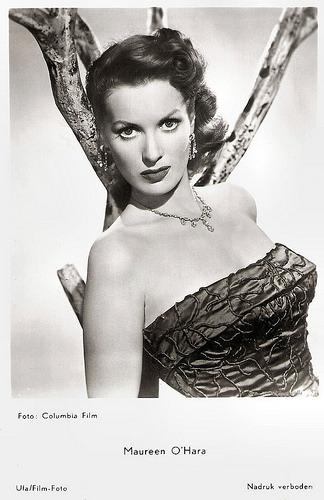
Maureen O'Hara . Dutch postcard by Gebr. Spanjersberg N.V., Rotterdam, no. 2028. Photo: Columbia Film / Ufa.
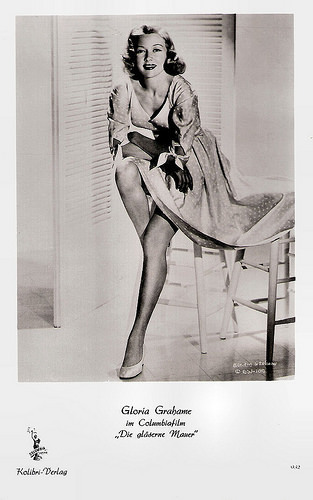
Gloria Grahame . German postcard by Kolibri-Verlag, no. 032. Photo: Columbia. Publicity still for The Glass Wall (Maxwell Shane, 1953).
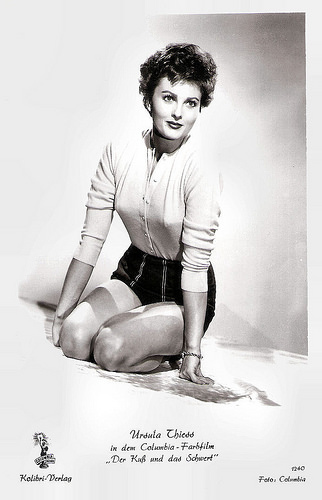
Ursula Thiess . German postcard by Kolibri-Verlag, no. 1240. Photo: Columbia. Publicity still for The Iron Glove (William Castle, 1954).
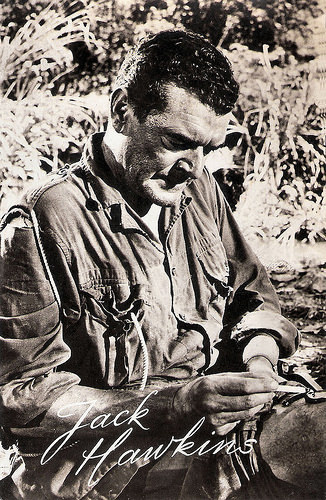
Jack Hawkins . Dutch postcard by Uitg. Takken, Utrecht, no. 8304. Photo: Columbia. Publicity still for The Bridge on the River Kwai (David Lean, 1957).

Jean Seberg . German postcard by WS-Druck, Wanne-Eickel, no. 334. Photo: Columbia / Filmpress Zürich.
Sources: Aurora (Once upon a screen), Encyclopaedia Britannica, Wikipedia and IMDb.

Rita Hayworth . Belgian postcard by Victoria, Brussels, no. 639. Photo: Columbia Pictures.

Cary Grant. British postcard in the Picturegoer Series, London, no. 735c. Photo: Columbia.

Adele Jergens. British postcard in Picturegoer Series, London, no. W 643. Photo: Columbia.

Claudette Colbert . Dutch postcard by J.S.A.. Photo: Columbia. Publicity still for Tomorrow is Forever (Irving Pichel, 1946).

Burt Lancaster . German postcard by Franz Josef Rüdel, Filmpostkartenverlag, Hamburg-Bergedorf, no. 858. Photo: Columbia-Film. Publicity still for From Here to Eternity (Fred Zinnemann, 1953).
The Corned Beef and Cabbage Studio
Columbia was founded in June 1918 as Cohn-Brandt-Cohn (CBC) Film Sales by brothers Jack and Harry Cohn and Jack's best friend Joe Brandt. Jack had worked for Carl Laemmle at Universal, Joe had been Laemmle’s executive secretary and Jack’s younger brother Harry, had also worked at Universal.They released their first feature film in August 1922. Brandt was president of CBC Film Sales, handling sales, marketing and distribution from New York along with Jack Cohn, while Harry Cohn ran production in Hollywood.
The studio's early productions were low-budget short subjects: 'Screen Snapshots', the 'Hall Room Boys' (the vaudeville duo of Edward Flanagan and Neely Edwards), and the Chaplin imitator Billy West. The start-up CBC leased space in a Poverty Row studio on Hollywood's famously low-rent Gower Street. Among Hollywood's elite, the studio's small-time reputation led some to joke that CBC stood for 'Corned Beef and Cabbage'. Brandt eventually tired of dealing with the Cohn brothers, and he sold his one-third stake to Harry Cohn, who took over as president.
In an effort to improve its image, the Cohn brothers renamed the company Columbia Pictures Corporation in 1924. Cohn remained head of production as well, thus concentrating enormous power in his hands. He would run Columbia for the next 34 years, the second-longest tenure of any studio chief, behind only Warner Bros.' Jack L. Warner. Even in an industry rife with nepotism, Columbia was particularly notorious for having a number of Harry and Jack's relatives in high positions. Humorist Robert Benchley called it the Pine Tree Studio, "because it has so many Cohns".
Columbia's product line consisted mostly of moderately budgeted features and short subjects including comedies, sports films, various serials, and cartoons. Columbia gradually moved into the production of higher-budget fare, eventually joining the second tier of Hollywood studios along with United Artists and Universal. Like United Artists and Universal, Columbia was a horizontally integrated company. It controlled production and distribution; it did not own any theatres.
Helping Columbia's climb was the arrival of an ambitious director, Frank Capra. Between 1927 and 1939, Capra constantly pushed Cohn for better material and bigger budgets. A string of hits he directed in the early and mid 1930s solidified Columbia's status as a major studio. In particular, It Happened One Night (Frank Capra, 1934) with Clark Gable and Claudette Colbert put Columbia on the map. It won the Academy Award for Best Film of 1934.
Until then, Columbia's very existence had depended on theatre owners willing to take its films, since as mentioned above it didn't have a theatre network of its own. Other Capra-directed hits followed, including Mr. Deeds Goes to Town (Frank Capra, 1936), the original version of Lost Horizon (Frank Capra, 1937) with Ronald Colman , You Can’t Take it With You (Frank Capra, 1938), which was Capra's highest-grossing picture at Columbia, and Mr. Smith Goes to Washington (Frank Capra, 1939), which made James Stewart a major star.
Capra but also Howard Hawks and others made some of the finest screwball comedies of the 1930s for Columbia: The Awful Truth (Leo McCarey, 1937), Holiday (George Cukor, 1938), and His Girl Friday (Howard Hawks, 1940), all starring Cary Grant. After Capra’s departure in 1939, Columbia languished because leading directors were reluctant to work for the notoriously hard-driving and vulgar Cohn.
In 1938, the addition of B. B. Kahane as Vice President would produce Charles Vidor's Those High Gray Walls (Charles Vidor, 1939), and The Lady in Question (Charles Vidor, 1940), the first joint film of Rita Hayworth and Glenn Ford. Kahane would later become the President of Academy of Motion Picture Arts and Sciences in 1959, until his death a year later.

Tullio Carminati and Grace Moore. British postcard in the Film Partners Series, London, no. P 151. Photo: Columbia. Publicity still for One Night of Love (Victor Schertzinger, 1934).

Claudette Colbert . Italian postcard by Rizzoli, Milano, 1937. Photo: Columbia.

Ronald Colman and Jane Wyatt. Italian postcard by Vecchioni & Guadagno, Roma. Photo: Columbia EIA. Publicity still for Lost Horizon (Frank Capra, 1937).

Marie McDonald. Dutch postcard by J.S.A. Photo: Columbia.

Sonja Henie . Dutch Postcard by J.S.A. Photo: Columbia F.B. / M.P.E.
Hollywood's Siberia for the less obedient stars
Columbia could not afford to keep a huge roster of contract stars, so Cohn usually borrowed them from other studios. At Metro-Goldwyn-Mayer, the industry's most prestigious studio, Columbia was nicknamed 'Siberia, as Louis B. Mayer would use the loan out to Columbia as a way to punish his less-obedient signings. In the 1930s, Columbia signed Jean Arthur to a long-term contract, and after The Whole Town's Talking (John Ford, 1935), Arthur became a major comedy star. Ann Sothern's career was launched when Columbia signed her to a contract in 1936. Cary Grant signed a contract in 1937 and soon after it was altered to a non-exclusive contract shared with RKO.
Many theatres relied on Westerns to attract big weekend audiences, and Columbia always recognised this market. Its first cowboy star was Buck Jones, who signed with Columbia in 1930 for a fraction of his former big-studio salary. Over the next two decades Columbia released scores of outdoor adventures with Jones, Tim McCoy, Ken Maynard, Robert (Tex) Allen, and Gene Autry. Columbia's most popular cowboy was Charles Starrett, who signed with Columbia in 1935 and starred in 131 western features over 17 years.
At Harry Cohn's insistence the studio signed The Three Stooges in 1934. MGM had let the Stooges go but kept straight-man Ted Healy. The Stooges made 190 shorts for Columbia between 1934 and 1957. Columbia's short-subject department employed many famous comedians, including Buster Keaton , Charley Chase, Harry Langdon, and Hugh Herbert. Almost 400 of Columbia's 529 two-reel comedies were released to television between 1958 and 1961; and have since been released to home video.
In the early 1930s, Columbia distributed Walt Disney's famous Mickey Mouse cartoons. In 1933, the studio established its own animation house, under the Screen Gems brand. Columbia's leading cartoon series were Krazy Kat, Scrappy, The Fox and the Crow, and (very briefly) Li'l Abner. In 1949, Columbia agreed to release animated shorts from United Productions of America. These new shorts were more sophisticated than Columbia's older cartoons, and many won critical praise and industry awards.
According to Bob Thomas' book King Cohn, studio chief Harry Cohn always placed a high priority on serials. Beginning in 1937, Columbia entered the lucrative serial market, and kept making these episodic adventures until 1956, after other studios had discontinued them. The most famous Columbia serials are based on comic-strip or radio characters: Mandrake the Magician, The Shadow, Terry and the Pirates, Batman, and Superman, among many others.
Columbia also produced musical shorts, sports reels (usually narrated by sportscaster Bill Stern), and travelogues. Its 'Screen Snapshots' series, showing behind-the-scenes footage of Hollywood stars, was a Columbia perennial; producer-director Ralph Staub kept this series going through 1958.

Merle Oberon . Italian postcard by Rotalfoto, Milano, no. 46. Photo: Columbia C.E.I.A.D.

Burt Lancaster . Italian postcard by Bromofoto, no. 957. Photo: Columbia C.E.I.A.D.

Marta Toren . Italian postcard by B.F.F. Edit., no. 3048. Photo: Columbia C.E.I.A.D.

Vittorio Gassman . Italian postcard by Casa Editr. Ballerini & Fratini, Firenze (B.F.F. Edit.), no. 2962. Photo: Columbia C.E.I.A.D.

Marlon Brando . Italian postcard by B.F.F. Edit., no. 2980. Photo: Columbia C.E.I.A.D.
Columbia's efficient recycling policy
In the 1940s, Columbia propelled in part by their film's surge in audiences during the war, and also benefited from the popularity of its biggest star, Rita Hayworth . Columbia maintained a long list of contractees well into the 1950s: Glenn Ford, William Holden, Judy Holliday, The Three Stooges, Ann Miller, Jack Lemmon, Adele Jergens, Lucille Ball, Kerwin Mathews, Kim Novak , and others.
Harry Cohn monitored the budgets of his films, and the studio got the maximum use out of costly sets, costumes, and props by reusing them in other films. Many of Columbia's low-budget B-films and short subjects have an expensive look, thanks to Columbia's efficient recycling policy. Cohn was reluctant to spend lavish sums on even his most important pictures, and it was not until 1943 that he agreed to use three-strip Technicolor in a live-action feature.
Columbia's first Technicolor feature was the Western The Desperadoes, starring Randolph Scott and Glenn Ford. Cohn quickly used Technicolor again for Cover Girl (Charles Vidor, 1944), a Hayworth vehicle that instantly was a smash hit, and for the fanciful biography of Frédéric Chopin, A Song to Remember (Charles Vidor, 1945), with Cornel Wilde and Merle Oberon . Another biopic, The Jolson Story (Alfred E. Green, 1946) with Larry Parks, was started in black-and-white, but when Cohn saw how well the project was proceeding, he scrapped the footage and insisted on filming in Technicolor.
In 1948, the United States v. Paramount Pictures, Inc. anti-trust decision forced Hollywood motion picture companies to divest themselves of the theatre chains that they owned. Since Columbia did not own any theatres, it was now on equal terms with the largest studios, and soon replaced RKO on the list of the Big Five studios.
By 1950, Columbia had discontinued most of its popular series films like Boston Blackie, Blondie, The Lone Wolf, etc. Only Jungle Jim featuring Johnny Weissmuller , launched by producer Sam Katzman in 1949, kept going through 1955. Katzman contributed greatly to Columbia's success by producing dozens of topical feature films, including crime dramas, Science-Fiction stories, and Rock-'n'-Roll musicals. Columbia kept making serials until 1956 and two-reel comedies until 1957, after other studios had abandoned them.

Rita Hayworth . Italian postcard by Bromofoto, no. 284.

Rita Hayworth . Dutch postcard, Col. Int., no. 286. Photo: Columbia. Publicity still for Cover Girl (Charles Vidor, 1944).

Rita Hayworth . Spanish postcard, no. 4026. Photo: Robert Coburn / Columbia Pictures. Publicity still for Gilda (Charles Vidor, 1946).

Rita Hayworth . Vintage card by IBIS, no. 23. Photo: Robert Coburn / Columbia Pictures. Publicity still for Gilda (Charles Vidor, 1946). Costume by Jean Louis.

Rita Hayworth . German postcard by F.J. Rüdel Filmpostkartenverlag, Hamburg-Bergedorf, no. 423. Photo: Columbia. Publicity still for Affair in Trinidad (Vincent Sherman, 1952).
Backing independent producers and directors
As the larger studios declined in the 1950s, Columbia's position improved. This was largely because it did not suffer from the massive loss of income that the other major studios suffered from losing their theatres. Columbia backed various independent producers and directors, among them Elia Kazan, Fred Zinnemann, David Lean, Robert Rossen, Otto Preminger, and Joseph Losey.
The studio continued to produce 40-plus pictures a year, offering productions that often broke ground and kept audiences coming to cinemas such as its adaptation of the controversial James Jones novel, From Here to Eternity (Fred Zinnemann, 1953) with Burt Lancaster , On the Waterfront (Elia Kazan, 1954) with Marlon Brando , and The Bridge on the River Kwai (David Lean, 1957) with William Holden, Jack Hawkins and Alec Guinness . All three films won the Best Picture Oscar.
Columbia president Harry Cohn died of a heart attack in February 1958. By 1966, the studio was suffering from box-office failures, and takeover rumours began surfacing. After turning down releasing Albert R. Broccoli's Eon Productions James Bond films, Columbia had hired Broccoli's former partner Irving Allen to produce the Matt Helm series with Dean Martin. Columbia also produced a James Bond spoof, Casino Royale (Val Guest, a.o., 1967), in conjunction with Charles K. Feldman, which held the adaptation rights for that novel. The studio also offered old-fashioned fare like A Man for All Seasons (Fred Zinnemann, 1966) and Oliver! (Carol Reed, 1968).
Columbia came back with the more contemporary Easy Rider (Dennis Hopper, 1969) with Peter Fonda, Five Easy Pieces (Bob Rafelson, 1970) starring Jack Nicholson, and The Last Picture Show (Peter Bogdanovich, 1971). During the 1970s, the studio re-emerged with hits like Close Encounters of the Third Kind (Steven Spielberg, 1977), Tootsie (Sydney Pollack, 1982), and Gandhi (Richard Attenborough, 1982). Columbia was purchased by The Coca-Cola Company in 1982. That same year, Columbia helped launch a new motion-picture studio, Tri-Star Pictures, which was merged with Columbia in 1987 to form Columbia Pictures Entertainment, Inc. In 1989 Columbia was acquired by the Sony Corporation of Japan.
The Columbia Pictures logo, featuring a woman carrying a torch and wearing a drape (representing Columbia, a personification of the United States), has gone through five major revisions. Originally in 1924, Columbia Pictures used a logo featuring a female Roman soldier holding a shield in her left hand and a stick of wheat in her right hand. The logo changed in 1928 with the woman wearing a draped flag and torch. The woman wore the stole and carried the palla of ancient Rome, and above her were the words A Columbia Production. The current logo was created in 1992, when Scott Mednick was hired by Peter Guber to create logos for all the entertainment properties then owned by Sony Pictures. Mednick hired New Orleans artist Michael Deas, to digitally repaint the logo and return the woman to her a classic look.

Maureen O'Hara . Dutch postcard by Gebr. Spanjersberg N.V., Rotterdam, no. 2028. Photo: Columbia Film / Ufa.

Gloria Grahame . German postcard by Kolibri-Verlag, no. 032. Photo: Columbia. Publicity still for The Glass Wall (Maxwell Shane, 1953).

Ursula Thiess . German postcard by Kolibri-Verlag, no. 1240. Photo: Columbia. Publicity still for The Iron Glove (William Castle, 1954).

Jack Hawkins . Dutch postcard by Uitg. Takken, Utrecht, no. 8304. Photo: Columbia. Publicity still for The Bridge on the River Kwai (David Lean, 1957).

Jean Seberg . German postcard by WS-Druck, Wanne-Eickel, no. 334. Photo: Columbia / Filmpress Zürich.
Sources: Aurora (Once upon a screen), Encyclopaedia Britannica, Wikipedia and IMDb.
Published on November 30, 2018 22:00
November 29, 2018
Judy Garland
American singer, actress, and vaudevillian Judy Garland (1922-1969) was one of the brightest, most tragic film stars of Hollywood's Golden Era. During a career that spanned 45 of her 47 years, Garland attained international stardom as an actress in musicals and dramas, with her records, and on the concert stage. She was nominated for the Oscar for Best Actress for A Star is Born (1954) and received a nomination for Best Supporting Actress for Judgment at Nuremberg (1961). With her warmth, spirit, and her rich and exuberant voice, Garland entertained devoted theatregoers with an array of musicals.
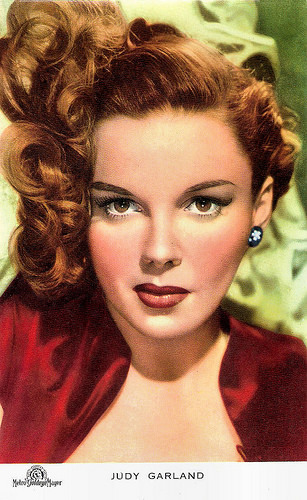
Belgian postcard by S.A. Victoria, Brussels, no. 639. Photo: Metro-Goldwyn-Mayer.
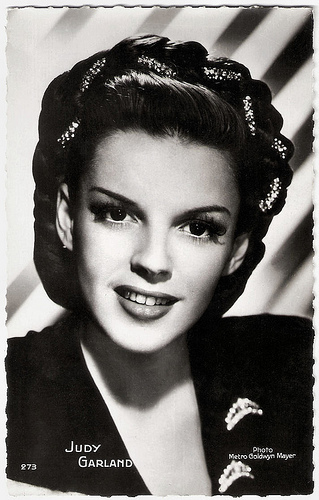
French postcard by Editions P.I., Paris, no. 273. Photo: Metro-Goldwyn-Mayer, 1950.
An orphaned girl on a farm in the dry plains of Kansas
Judy Garland was born Frances Ethel Gumm in 1922 in Grand Rapids, Minnesota, U.S. She was the youngest daughter of vaudevillians Ethel Marion (Milne) and Francis Avent Gumm. Only two, Garland began performing in vaudeville with her two older sisters Mary Jane Gumm and Virginia Gumm as 'The Gumm Sisters'.
Her family life was not a happy one, largely because of her mother's drive for her to succeed as a performer and also her father's closeted homosexuality. The Gumm family would regularly be forced to leave town owing to her father's illicit affairs with other men, and from time to time they would be reduced to living out of their automobile.
Her mother took Frances out of the The Gumm Sisters act and together they travelled across America where she would perform in nightclubs, cabarets, hotels and theatres solo. In 1935, Frances was signed by Louis B. Mayer, mogul of leading film studio MGM, after hearing her sing. It was then that her name was changed from Frances Gumm to Judy Garland, after a popular 1930s song 'Judy' and film critic Robert Garland. Tragedy followed two months later, when her father died of meningitis in November 1935.
Having been given no assignments with the exception of singing on radio, Judy faced the threat of losing her job following the arrival of Deanna Durbin. Knowing that they couldn't keep both of the teenage singers, MGM devised a short entitled Every Sunday (Felix E. Feist, 1936) which would be the girls' screen test. Judy was the outright winner and MGM kept her. Durbin moved to Universal.
Judy's film debut was in Pigskin Parade (David Butler, 1936), in which she played a teenage hillbilly. Her career did officially kick off when she sang one of her most famous songs, 'You Made Me Love You', at Clark Gable's birthday party in February 1937. Louis B. Mayer finally paid attention to the talented songstress, and MGM set to work preparing various musicals with her.
All the work on these musicals took its toll on the young teenager, and she was given numerous pills by the studio doctors in order to combat her tiredness on set. Another problem was her weight fluctuation, but she was soon given amphetamines in order to give her the desired streamlined figure. This would produce the downward spiral that resulted in her lifelong drug addiction.
In 1939, Judy shot to stardom with The Wizard of Oz (Victor Fleming, 1939), in which she portrayed Dorothy, an orphaned girl living on a farm in the dry plains of Kansas who gets whisked off into the magical world of Oz on the other end of the rainbow. Her poignant performance and sweet delivery of her signature song, 'Over The Rainbow', earned Judy a special juvenile Oscar statuette in 1940 for Best Performance by a Juvenile Actor.

British postcard in the Picturegoer Series, London,, no. 1281. Photo: Metro-Goldwyn-Mayer. Publicity still for Love Finds Andy Hardy (George B. Seitz, 1938) with Mickey Rooney, Ann Rutherford, Judy Garland and Lana Turner.
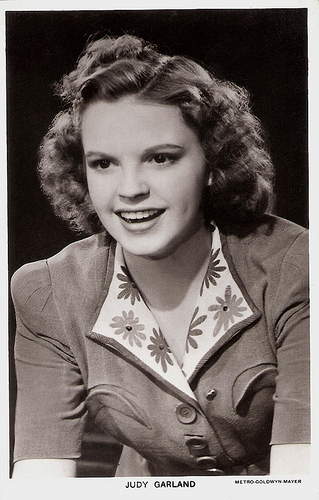
British postcard in the Picturegoer Series, London, no. 1178b. Photo: Metro-Goldwyn-Mayer.
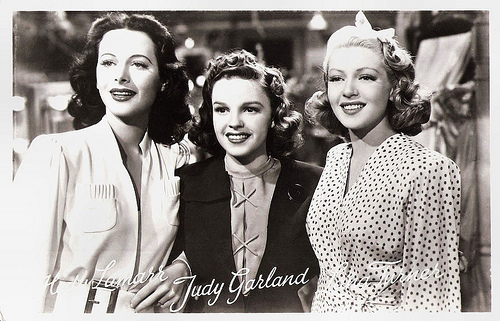
Dutch postcard, no. 3114. Photo: MGM. Publicity still for Ziegfeld Girl (Robert Z. Leonard, Busby Berkeley, 1941) with Hedy Lamarr and Lana Turner.
A love affair between director and actress
Judy Garland was now taking an interest in men. After starring in her final juvenile performance in Ziegfeld Girl (Robert Z. Leonard, Busby Berkeley, 1941) alongside glamorous beauties Lana Turner and Hedy Lamarr , Judy got engaged to bandleader David Rose in May 1941, just two months after his divorce from Martha Raye. Despite planning a big wedding, the couple eloped to Las Vegas and married with just her mother Ethel and her stepfather Will Gilmore present. However, their marriage went downhill as, after discovering that she was pregnant in November 1942, David and MGM persuaded her to abort the baby in order to keep her good-girl image up. She did so and, as a result, was haunted for the rest of her life by her 'inhumane actions'. The couple separated in January 1943.
Garland made more than two dozen films with MGM, nine of which with Mickey Rooney. She played a vaudevillian during WWI in For Me and My Gal (Busby Berkeley, 1942). A big success was Meet Me in St. Louis (Vincente Minnelli, 1944), Director Vincente Minnelli highlighted Judy's beauty for the first time on screen, having made the period musical in colour. He showed off her large brandy-brown eyes and her full, thick lips and after filming ended in April 1944, a love affair resulted between director and actress and they were soon living together.
Vincente began to mold Judy and her career, making her more beautiful and more popular with audiences worldwide. He directed her in The Clock (Vincente Minnelli, 1945), and during the filming the couple announced their engagement. On 15 June 1945 Judy and Vincente married at her mother's home with her boss Louis B. Mayer giving her away and her best friend Betty Asher serving as bridesmaid. After their honeymoon in New York, Judy discovered that she was pregnant. Her first film after marrying Vincente Minnelli was The Harvey Girls (Vincente Minnelli, 1946). Then Judy gave birth to their daughter, Liza Minnelli.
After a postnatal depression, she spent much of her time recuperating in bed. She returned to work, to film The Pirate (Vincente Minnelli, 1948) with Gene Kelly. Judy's mental health was deteriorating and she began hallucinating things and making false accusations toward people, especially her husband, making the filming a nightmare. She then teamed up with Fred Astaire for the musical Easter Parade (Charles Walters, 1948), which resulted in a successful comeback despite having Vincente fired from directing the musical.
Afterwards, Judy's health deteriorated and she began the first of several suicide attempts. In May 1949, she was checked into a rehabilitation center, which caused her much distress. After being replaced by Betty Hutton on Annie Get Your Gun (George Sidney, 1950), Judy was suspended before making her final film for MGM, Summer Stock (Charles Walters, 1950). Then Judy received her third suspension and was fired by MGM, and her second marriage was also soon dissolved.
Having taken up with ruggedly handsome and streetwise entrepreneur Sidney Luft, Judy travelled to London to star at the legendary Palladium. She was an instant success and after her divorce to Vincente Minnelli was finalised on 29 March 1951 after almost six years of marriage, Judy travelled with Sid to New York to make an appearance on Broadway. With her new found fame on stage, Judy was stopped in her tracks in February 1952 when she became pregnant by Sid Luft. At the age of 30, she made him her third husband.
Her relationship with her mother had long since been dissolved by this point, and after the birth of her second daughter, Lorna Luft, on 21 November 1952, she refused to allow her mother to see her granddaughter. Ethel then died in January 1953 of a heart attack, leaving Judy devastated and feeling guilty about not reconciling with her mother before her untimely demise.
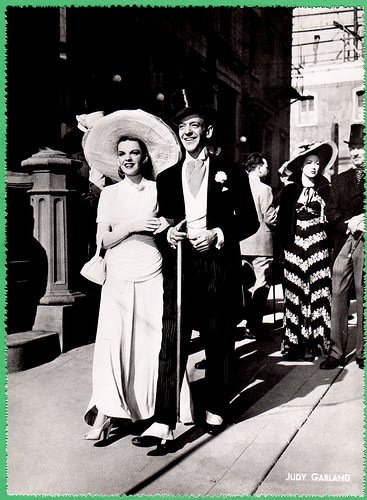
Belgian collectors card by Chocolaterie Clovis, Pepinster. Photo: Metro Goldwyn Mayer. Publicity still for Easter Parade (Charles Walters, 1948) with Fred Astaire. Collection: Amit Benyovits.
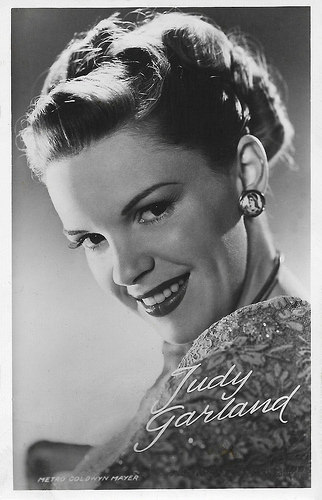
Dutch postcard, no. 3371. Photo: Metro-Goldwyn-Mayer.
A volatile, on-off relationship resulting in numerous divorce filings
Judy Garland was released from MGM in 1950, amid a series of personal struggles and erratic behaviour that had prevented her from fulfilling the terms of her contract. She signed a new film contract with Warner Bros. to star in the musical remake of A Star is Born (William A. Wellman, 1937), which had starred Janet Gaynor . After filming was complete Judy was yet again lauded as a great film star. She won a Golden Globe for her brilliant and outstanding performance as nightclub singer Esther Blodgett who turns into film star Vicki Lester. But she lost out on the Best Actress Oscar to Grace Kelly for her portrayal of the wife of an alcoholic star in The Country Girl (George Seaton, 1954).
Continuing her work on stage, Judy gave birth to son Joey Luft in 1955. She soon began to lose her millions of dollars as a result of her husband's strong gambling addiction. With hundreds of debts to pay, Judy and Sid began a volatile, on-off relationship resulting in numerous divorce filings. In 1961, at the age of 39, Judy returned to her ailing film career, this time to star in Judgment at Nuremberg (Stanley Kramer, 1961). She received an Oscar nomination for Best Supporting Actress, but this time she lost out to Rita Moreno for her role in West Side Story (Robert Wise, 1961).
Her battles with alcoholism and drugs led to Judy's making headlines in newspapers, but she soldiered on. She made record-breaking concert appearances, released eight studio albums, and hosted her own Emmy-nominated television series, The Judy Garland Show (1963–1964). In 1965, Judy and Sid finally divorced after almost 13 years of marriage. By this time, Judy, now 41, had made her final film performance alongside Dirk Bogarde in I Could Go on Singing (Ronald Neame, 1963).
She married her fourth husband, Mark Herron, in 1965 in Las Vegas. The couple separated in April 1966 after five months of marriage, owing to his homosexuality. She then settled down in London, and she began dating disk jockey Mickey Deans in December 1968. They became engaged once her divorce from Mark Herron was finalised on 9 January 1969 after three years of marriage. She married Mickey, her fifth and final husband, in Chelsea, London.
Judy Garland continued working on stage, appearing several times with her daughter Liza. It was during a concert in Chelsea, London, that Judy stumbled into her bathroom late one night and died of an accidental overdose of barbiturates, on the 22nd of June 1969 at the age of 47. The day she died, there was a tornado in Kansas.
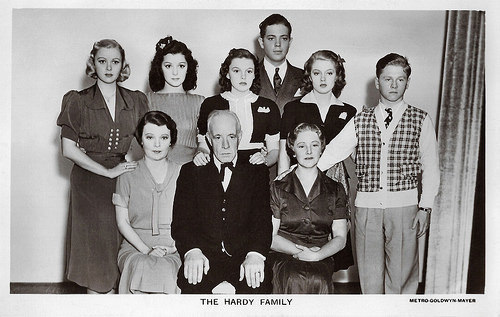
British postcard in the Picturegoer Series, London, no. 1280. Photo: Metro-Goldwyn-Mayer. Publicity still for Love Finds Andy Hardy (George B. Seitz, 1938) with (back row) Cecilia Parker, Ann Rutherford, Judy Garland, Gene Reynolds, Lana Turner and (front row) Mary Howard, Lewis Stone, Fay Holden and Mickey Rooney.
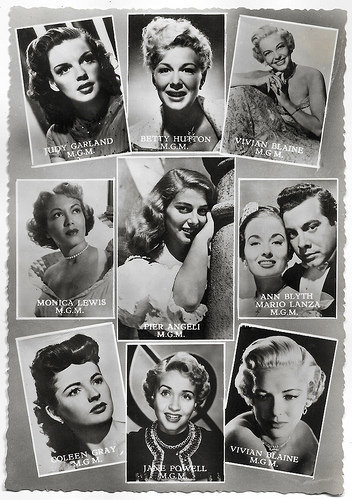
Dutch postcard by Sparo (Gebr. Spanjersberg N.V., Rotterdam). Photos: Metro-Goldwyn-Mayer. The pictures stars are Judy Garland, Betty Hutton, Vivian Blaine (twice), Monica Lewis, Pier Angeli , Ann Blyth and Mario Lanza, Coleen Gray, and Jane Powell. The postcard must date from ca. 1951, when Blyth and Lanza starred together in The Great Caruso (Richard Thorpe, 1951).
Sources: Wikipedia and .

Belgian postcard by S.A. Victoria, Brussels, no. 639. Photo: Metro-Goldwyn-Mayer.

French postcard by Editions P.I., Paris, no. 273. Photo: Metro-Goldwyn-Mayer, 1950.
An orphaned girl on a farm in the dry plains of Kansas
Judy Garland was born Frances Ethel Gumm in 1922 in Grand Rapids, Minnesota, U.S. She was the youngest daughter of vaudevillians Ethel Marion (Milne) and Francis Avent Gumm. Only two, Garland began performing in vaudeville with her two older sisters Mary Jane Gumm and Virginia Gumm as 'The Gumm Sisters'.
Her family life was not a happy one, largely because of her mother's drive for her to succeed as a performer and also her father's closeted homosexuality. The Gumm family would regularly be forced to leave town owing to her father's illicit affairs with other men, and from time to time they would be reduced to living out of their automobile.
Her mother took Frances out of the The Gumm Sisters act and together they travelled across America where she would perform in nightclubs, cabarets, hotels and theatres solo. In 1935, Frances was signed by Louis B. Mayer, mogul of leading film studio MGM, after hearing her sing. It was then that her name was changed from Frances Gumm to Judy Garland, after a popular 1930s song 'Judy' and film critic Robert Garland. Tragedy followed two months later, when her father died of meningitis in November 1935.
Having been given no assignments with the exception of singing on radio, Judy faced the threat of losing her job following the arrival of Deanna Durbin. Knowing that they couldn't keep both of the teenage singers, MGM devised a short entitled Every Sunday (Felix E. Feist, 1936) which would be the girls' screen test. Judy was the outright winner and MGM kept her. Durbin moved to Universal.
Judy's film debut was in Pigskin Parade (David Butler, 1936), in which she played a teenage hillbilly. Her career did officially kick off when she sang one of her most famous songs, 'You Made Me Love You', at Clark Gable's birthday party in February 1937. Louis B. Mayer finally paid attention to the talented songstress, and MGM set to work preparing various musicals with her.
All the work on these musicals took its toll on the young teenager, and she was given numerous pills by the studio doctors in order to combat her tiredness on set. Another problem was her weight fluctuation, but she was soon given amphetamines in order to give her the desired streamlined figure. This would produce the downward spiral that resulted in her lifelong drug addiction.
In 1939, Judy shot to stardom with The Wizard of Oz (Victor Fleming, 1939), in which she portrayed Dorothy, an orphaned girl living on a farm in the dry plains of Kansas who gets whisked off into the magical world of Oz on the other end of the rainbow. Her poignant performance and sweet delivery of her signature song, 'Over The Rainbow', earned Judy a special juvenile Oscar statuette in 1940 for Best Performance by a Juvenile Actor.

British postcard in the Picturegoer Series, London,, no. 1281. Photo: Metro-Goldwyn-Mayer. Publicity still for Love Finds Andy Hardy (George B. Seitz, 1938) with Mickey Rooney, Ann Rutherford, Judy Garland and Lana Turner.

British postcard in the Picturegoer Series, London, no. 1178b. Photo: Metro-Goldwyn-Mayer.

Dutch postcard, no. 3114. Photo: MGM. Publicity still for Ziegfeld Girl (Robert Z. Leonard, Busby Berkeley, 1941) with Hedy Lamarr and Lana Turner.
A love affair between director and actress
Judy Garland was now taking an interest in men. After starring in her final juvenile performance in Ziegfeld Girl (Robert Z. Leonard, Busby Berkeley, 1941) alongside glamorous beauties Lana Turner and Hedy Lamarr , Judy got engaged to bandleader David Rose in May 1941, just two months after his divorce from Martha Raye. Despite planning a big wedding, the couple eloped to Las Vegas and married with just her mother Ethel and her stepfather Will Gilmore present. However, their marriage went downhill as, after discovering that she was pregnant in November 1942, David and MGM persuaded her to abort the baby in order to keep her good-girl image up. She did so and, as a result, was haunted for the rest of her life by her 'inhumane actions'. The couple separated in January 1943.
Garland made more than two dozen films with MGM, nine of which with Mickey Rooney. She played a vaudevillian during WWI in For Me and My Gal (Busby Berkeley, 1942). A big success was Meet Me in St. Louis (Vincente Minnelli, 1944), Director Vincente Minnelli highlighted Judy's beauty for the first time on screen, having made the period musical in colour. He showed off her large brandy-brown eyes and her full, thick lips and after filming ended in April 1944, a love affair resulted between director and actress and they were soon living together.
Vincente began to mold Judy and her career, making her more beautiful and more popular with audiences worldwide. He directed her in The Clock (Vincente Minnelli, 1945), and during the filming the couple announced their engagement. On 15 June 1945 Judy and Vincente married at her mother's home with her boss Louis B. Mayer giving her away and her best friend Betty Asher serving as bridesmaid. After their honeymoon in New York, Judy discovered that she was pregnant. Her first film after marrying Vincente Minnelli was The Harvey Girls (Vincente Minnelli, 1946). Then Judy gave birth to their daughter, Liza Minnelli.
After a postnatal depression, she spent much of her time recuperating in bed. She returned to work, to film The Pirate (Vincente Minnelli, 1948) with Gene Kelly. Judy's mental health was deteriorating and she began hallucinating things and making false accusations toward people, especially her husband, making the filming a nightmare. She then teamed up with Fred Astaire for the musical Easter Parade (Charles Walters, 1948), which resulted in a successful comeback despite having Vincente fired from directing the musical.
Afterwards, Judy's health deteriorated and she began the first of several suicide attempts. In May 1949, she was checked into a rehabilitation center, which caused her much distress. After being replaced by Betty Hutton on Annie Get Your Gun (George Sidney, 1950), Judy was suspended before making her final film for MGM, Summer Stock (Charles Walters, 1950). Then Judy received her third suspension and was fired by MGM, and her second marriage was also soon dissolved.
Having taken up with ruggedly handsome and streetwise entrepreneur Sidney Luft, Judy travelled to London to star at the legendary Palladium. She was an instant success and after her divorce to Vincente Minnelli was finalised on 29 March 1951 after almost six years of marriage, Judy travelled with Sid to New York to make an appearance on Broadway. With her new found fame on stage, Judy was stopped in her tracks in February 1952 when she became pregnant by Sid Luft. At the age of 30, she made him her third husband.
Her relationship with her mother had long since been dissolved by this point, and after the birth of her second daughter, Lorna Luft, on 21 November 1952, she refused to allow her mother to see her granddaughter. Ethel then died in January 1953 of a heart attack, leaving Judy devastated and feeling guilty about not reconciling with her mother before her untimely demise.

Belgian collectors card by Chocolaterie Clovis, Pepinster. Photo: Metro Goldwyn Mayer. Publicity still for Easter Parade (Charles Walters, 1948) with Fred Astaire. Collection: Amit Benyovits.

Dutch postcard, no. 3371. Photo: Metro-Goldwyn-Mayer.
A volatile, on-off relationship resulting in numerous divorce filings
Judy Garland was released from MGM in 1950, amid a series of personal struggles and erratic behaviour that had prevented her from fulfilling the terms of her contract. She signed a new film contract with Warner Bros. to star in the musical remake of A Star is Born (William A. Wellman, 1937), which had starred Janet Gaynor . After filming was complete Judy was yet again lauded as a great film star. She won a Golden Globe for her brilliant and outstanding performance as nightclub singer Esther Blodgett who turns into film star Vicki Lester. But she lost out on the Best Actress Oscar to Grace Kelly for her portrayal of the wife of an alcoholic star in The Country Girl (George Seaton, 1954).
Continuing her work on stage, Judy gave birth to son Joey Luft in 1955. She soon began to lose her millions of dollars as a result of her husband's strong gambling addiction. With hundreds of debts to pay, Judy and Sid began a volatile, on-off relationship resulting in numerous divorce filings. In 1961, at the age of 39, Judy returned to her ailing film career, this time to star in Judgment at Nuremberg (Stanley Kramer, 1961). She received an Oscar nomination for Best Supporting Actress, but this time she lost out to Rita Moreno for her role in West Side Story (Robert Wise, 1961).
Her battles with alcoholism and drugs led to Judy's making headlines in newspapers, but she soldiered on. She made record-breaking concert appearances, released eight studio albums, and hosted her own Emmy-nominated television series, The Judy Garland Show (1963–1964). In 1965, Judy and Sid finally divorced after almost 13 years of marriage. By this time, Judy, now 41, had made her final film performance alongside Dirk Bogarde in I Could Go on Singing (Ronald Neame, 1963).
She married her fourth husband, Mark Herron, in 1965 in Las Vegas. The couple separated in April 1966 after five months of marriage, owing to his homosexuality. She then settled down in London, and she began dating disk jockey Mickey Deans in December 1968. They became engaged once her divorce from Mark Herron was finalised on 9 January 1969 after three years of marriage. She married Mickey, her fifth and final husband, in Chelsea, London.
Judy Garland continued working on stage, appearing several times with her daughter Liza. It was during a concert in Chelsea, London, that Judy stumbled into her bathroom late one night and died of an accidental overdose of barbiturates, on the 22nd of June 1969 at the age of 47. The day she died, there was a tornado in Kansas.

British postcard in the Picturegoer Series, London, no. 1280. Photo: Metro-Goldwyn-Mayer. Publicity still for Love Finds Andy Hardy (George B. Seitz, 1938) with (back row) Cecilia Parker, Ann Rutherford, Judy Garland, Gene Reynolds, Lana Turner and (front row) Mary Howard, Lewis Stone, Fay Holden and Mickey Rooney.

Dutch postcard by Sparo (Gebr. Spanjersberg N.V., Rotterdam). Photos: Metro-Goldwyn-Mayer. The pictures stars are Judy Garland, Betty Hutton, Vivian Blaine (twice), Monica Lewis, Pier Angeli , Ann Blyth and Mario Lanza, Coleen Gray, and Jane Powell. The postcard must date from ca. 1951, when Blyth and Lanza starred together in The Great Caruso (Richard Thorpe, 1951).
Sources: Wikipedia and .
Published on November 29, 2018 22:00
November 28, 2018
Cleopatra (1934)
After his historical epic Sign of the Cross (1932), Cecil B. DeMille directed another ancient spectacle, Cleopatra (1934). His new star Claudette Colbert, fresh from her donkey milk bath in Sign of The Cross, played the politically shrewd, man-hungry queen of Egypt. In 48 BC, Cleopatra, facing palace revolt, welcomes the arrival of Julius Caesar (Warren William) as a way of solidifying her power under Rome. When Caesar, whom she has led astray, is killed, she transfers her affections to Marc Antony (Henry Wilcoxon) and dazzles him on a lavish barge. The film got five Oscar nominations, including one for Best Picture, and Victor Milner won the award for Best Cinematography.
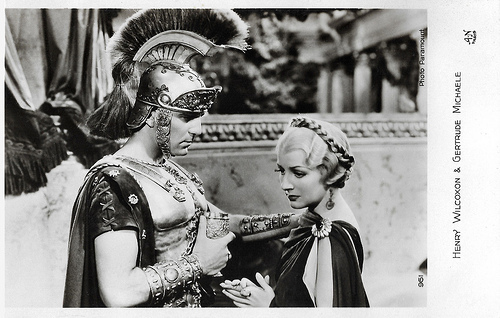
Henry Wilcoxon as Marc Anthony and Gertrude Michael as Caesar's wife Calpurnia. French postcard by A.N., Paris, no. 961. Photo: Paramount. Publicity still for Cleopatra (Cecil B. deMille, 1934).
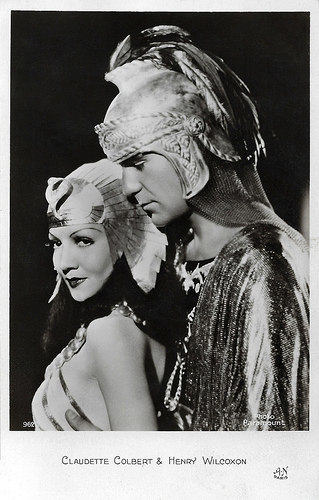
Claudette Colbert as Cleopatra and Henry Wilcoxon as Marc Anthony. French postcard by A.N., Paris, no. 962. Photo: Paramount. Publicity still for Cleopatra (Cecil B. DeMille, 1934).
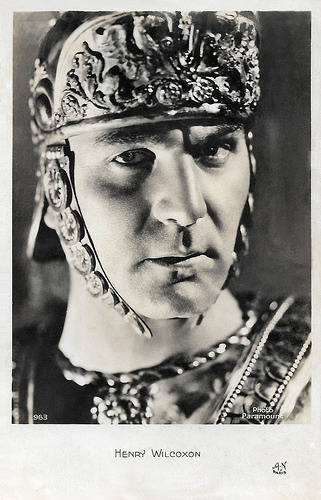
Henri Wilcoxon as Marc Anthony. French postcard by A.N., Paris, no. 963. Photo: Paramount. Publicity still for Cleopatra (Cecil B. DeMille, 1934).
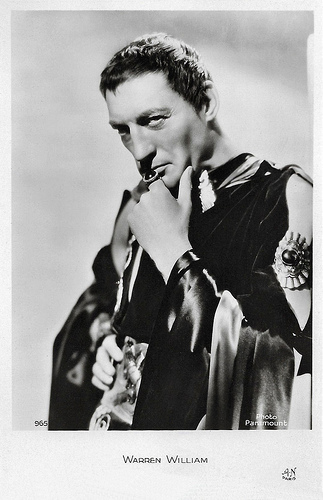
Warren William as Julius Caesar. French postcard by A.N., Paris, no. 965. Photo: Paramount. Publicity still for Cleopatra (Cecil B. DeMille, 1934).
Deadly and fascinating
Wikipedia : "On July 1, 1934, the Motion Picture Production Code began to be rigidly enforced and expanded by Joseph Breen had just taken effect. Talkie films made before that date are generally referred to as Pre-Code films. However, DeMille was able to get away with using more risque imagery than he would be able to do in his later productions. He opens the film with an apparently naked, but strategically lit slave girl holding up an incense burner in each hand as the title appears on screen."
Ron Oliver at IMDb : "Claudette Colbert is perfectly cast in the title role - deadly & fascinating, it's almost like watching a desert viper act. Exhibiting mega star wattage in arguably her best role, Colbert is one of the legendary actresses who could hold her own without being swallowed by the lavish costumes & sets which fill her every scene."
John O'Grady at IMDb : "Colbert is admittedly somewhat miscast (her face is altogether Parisienne), but she handles the part with considerable charm. Warren William, usually a very limited actor, is as good a Caesar as I have seen on film, commanding and uncomfortable by turns; while Henry Wilcoxon is the definitive Mark Antony, laughing, brawling, swaggering, crude and brooding. C. Aubrey Smith as Enobarbus, the last of the hardcore Roman republicans, is perfect. Victor Milner's cinematography is superb, if old-fashioned. There is one magnificent pullback shot aboard Cleopatra's barge, with more and more stuff entering the frame, which as pure cinema is worth more than all four hours of the Liz Taylor version for my money."
Tim Dirks at AMC Filmsite : "Unarguably, the Paramount Studios film is campy, grandiose and unreal and ludicrous historically - filled with DeMille's usual mixture of sin and sex. Sexually-suggestive costumes adorn most of the female characters."
Hal Erickson at AllMovie : "To emphasize the "contemporary" nature of the film, DeMille adds little modernistic touches throughout: The architecture of Egypt and Rome has a distinctly art-deco look; a matron at a social gathering clucks "Poor Calpurnia...well, the wife is always the last to know"; and, after Caesar's funeral, Mark Anthony is chided by an associate for "all that 'Friends, Romans, Countrymen' business!" Cleopatra's barge scene and her suicide from the bite of a snake marked two of the most memorable sequences in DeMille's career. Remarkably, for all the enormous sets and elaborate costumes, Cleopatra came in at a budget of $750,000 -- almost $40 million less than the 1963 Elizabeth Taylor remake."
Mario Gauci at IMDb : "The film features a number of great scenes: Caesar's murder (partly filmed in a POV (point of view) shot), following which is a delicious jibe at Antony's famous oratory during Caesar's funeral as envisioned by Shakespeare; the long - and justly celebrated - barge sequence, in which Antony (intent on teaching Cleopatra, whom he blames for Caesar's death, a lesson) ends up being completely won over by her wiles; Cleopatra's own death scene is simply but most effectively filmed."
Wikipedia : "The film is also memorable for the sumptuous art deco look of its sets (by Hans Dreier) and costumes (by Travis Banton), the atmospheric music composed and conducted by Rudolph George Kopp, and for DeMille's legendary set piece of Cleopatra's seduction of Antony, which takes place on Cleopatra's barge."
Robert Reynolds at IMDb : "This movie is a typical DeMille PRODUCTION, with all the strengths-gorgeous sets, costumes and a sort of grandeur to all the proceedings-as well as the weaknesses-the lavishness often comes at the expense of things like the story, acting and plot. There's no question that it's beautiful (although, interestingly enough, none of it's five nominations for Academy Awards was for Interior Decoration.)"
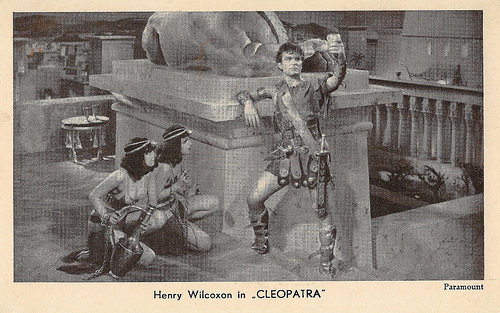
Henry Wilcoxon as Marc Anthony. Dutch postcard, promoting a visit to the American epic Cleopatra (Cecil B. DeMille, 1934). Photo: Paramount.
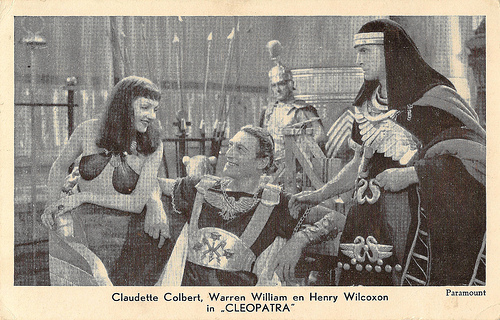
Dutch postcard, promoting a visit to the American epic Cleopatra (Cecil B. DeMille, 1934). Photo: Paramount. Credited on the card are Claudette Colbert (Cleopatra), Henry Wilcoxon (Marc Anthony) and Warren William (Julius Caesar). However, the guy on the right on this card is not Wilcoxon but Cleopatra's rival Pothinos (Leonard Mudie).
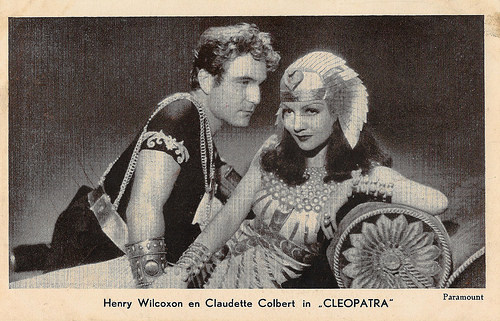
Dutch postcard. Photo: Paramount. Claudette Colbert as Cleopatra and Henry Wilcoxon as Marc Anthony in Cleopatra (Cecil B. DeMille, 1934).
Sources: Hal Erickson (AllMovie), Tim Dirks (AMC Filmsite), Wikipedia and IMDb.

Henry Wilcoxon as Marc Anthony and Gertrude Michael as Caesar's wife Calpurnia. French postcard by A.N., Paris, no. 961. Photo: Paramount. Publicity still for Cleopatra (Cecil B. deMille, 1934).

Claudette Colbert as Cleopatra and Henry Wilcoxon as Marc Anthony. French postcard by A.N., Paris, no. 962. Photo: Paramount. Publicity still for Cleopatra (Cecil B. DeMille, 1934).

Henri Wilcoxon as Marc Anthony. French postcard by A.N., Paris, no. 963. Photo: Paramount. Publicity still for Cleopatra (Cecil B. DeMille, 1934).

Warren William as Julius Caesar. French postcard by A.N., Paris, no. 965. Photo: Paramount. Publicity still for Cleopatra (Cecil B. DeMille, 1934).
Deadly and fascinating
Wikipedia : "On July 1, 1934, the Motion Picture Production Code began to be rigidly enforced and expanded by Joseph Breen had just taken effect. Talkie films made before that date are generally referred to as Pre-Code films. However, DeMille was able to get away with using more risque imagery than he would be able to do in his later productions. He opens the film with an apparently naked, but strategically lit slave girl holding up an incense burner in each hand as the title appears on screen."
Ron Oliver at IMDb : "Claudette Colbert is perfectly cast in the title role - deadly & fascinating, it's almost like watching a desert viper act. Exhibiting mega star wattage in arguably her best role, Colbert is one of the legendary actresses who could hold her own without being swallowed by the lavish costumes & sets which fill her every scene."
John O'Grady at IMDb : "Colbert is admittedly somewhat miscast (her face is altogether Parisienne), but she handles the part with considerable charm. Warren William, usually a very limited actor, is as good a Caesar as I have seen on film, commanding and uncomfortable by turns; while Henry Wilcoxon is the definitive Mark Antony, laughing, brawling, swaggering, crude and brooding. C. Aubrey Smith as Enobarbus, the last of the hardcore Roman republicans, is perfect. Victor Milner's cinematography is superb, if old-fashioned. There is one magnificent pullback shot aboard Cleopatra's barge, with more and more stuff entering the frame, which as pure cinema is worth more than all four hours of the Liz Taylor version for my money."
Tim Dirks at AMC Filmsite : "Unarguably, the Paramount Studios film is campy, grandiose and unreal and ludicrous historically - filled with DeMille's usual mixture of sin and sex. Sexually-suggestive costumes adorn most of the female characters."
Hal Erickson at AllMovie : "To emphasize the "contemporary" nature of the film, DeMille adds little modernistic touches throughout: The architecture of Egypt and Rome has a distinctly art-deco look; a matron at a social gathering clucks "Poor Calpurnia...well, the wife is always the last to know"; and, after Caesar's funeral, Mark Anthony is chided by an associate for "all that 'Friends, Romans, Countrymen' business!" Cleopatra's barge scene and her suicide from the bite of a snake marked two of the most memorable sequences in DeMille's career. Remarkably, for all the enormous sets and elaborate costumes, Cleopatra came in at a budget of $750,000 -- almost $40 million less than the 1963 Elizabeth Taylor remake."
Mario Gauci at IMDb : "The film features a number of great scenes: Caesar's murder (partly filmed in a POV (point of view) shot), following which is a delicious jibe at Antony's famous oratory during Caesar's funeral as envisioned by Shakespeare; the long - and justly celebrated - barge sequence, in which Antony (intent on teaching Cleopatra, whom he blames for Caesar's death, a lesson) ends up being completely won over by her wiles; Cleopatra's own death scene is simply but most effectively filmed."
Wikipedia : "The film is also memorable for the sumptuous art deco look of its sets (by Hans Dreier) and costumes (by Travis Banton), the atmospheric music composed and conducted by Rudolph George Kopp, and for DeMille's legendary set piece of Cleopatra's seduction of Antony, which takes place on Cleopatra's barge."
Robert Reynolds at IMDb : "This movie is a typical DeMille PRODUCTION, with all the strengths-gorgeous sets, costumes and a sort of grandeur to all the proceedings-as well as the weaknesses-the lavishness often comes at the expense of things like the story, acting and plot. There's no question that it's beautiful (although, interestingly enough, none of it's five nominations for Academy Awards was for Interior Decoration.)"

Henry Wilcoxon as Marc Anthony. Dutch postcard, promoting a visit to the American epic Cleopatra (Cecil B. DeMille, 1934). Photo: Paramount.

Dutch postcard, promoting a visit to the American epic Cleopatra (Cecil B. DeMille, 1934). Photo: Paramount. Credited on the card are Claudette Colbert (Cleopatra), Henry Wilcoxon (Marc Anthony) and Warren William (Julius Caesar). However, the guy on the right on this card is not Wilcoxon but Cleopatra's rival Pothinos (Leonard Mudie).

Dutch postcard. Photo: Paramount. Claudette Colbert as Cleopatra and Henry Wilcoxon as Marc Anthony in Cleopatra (Cecil B. DeMille, 1934).
Sources: Hal Erickson (AllMovie), Tim Dirks (AMC Filmsite), Wikipedia and IMDb.
Published on November 28, 2018 22:00
November 27, 2018
Louis Armstrong
Louis Armstrong (1901-1971) was The King of the Jazz Trumpet. Armstrong, nicknamed Satchmo, is renowned for his charismatic stage presence and voice almost as much as for his trumpet playing. He recorded hit songs for five decades and composed dozens of songs that have become jazz standards. Armstrong was one of the most important creative forces in the early development and perpetuation of Jazz. With his superb comic timing and unabashed joy of life, Louis Armstrong also appeared in more than thirty films.
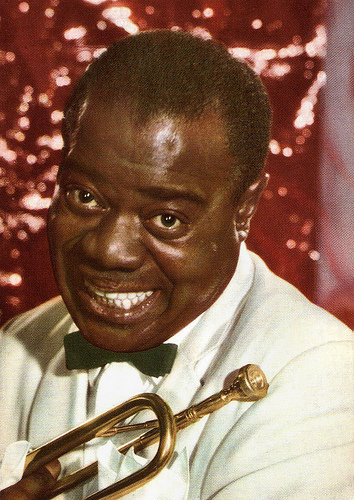
French postcard by Editions P.I., Paris, no. CK-289. Photo: Arthur Grimm / Ufa.
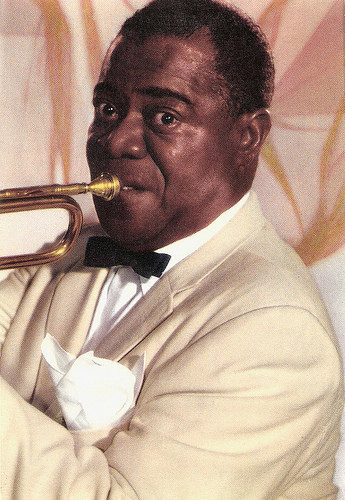
German postcard by ISV, no. H 37.
Born in the Battlefield
Louis Daniel Armstrong was born in New Orleans, Louisiana, in the Storyville District known as 'the Battlefield' in 1901. His parents were Mary Albert and William Armstrong. William abandoned the family shortly after, and Louis grew up poor in a single-parent household. He left school at the 5th grade to help support his family. He sang on street corners, sold newspapers and delivered coal.
Louis was 13 when he celebrated New Year's Eve on 31 December 1912 by running out on the street and firing a blank from a pistol that belonged to the current man in his mother's life. He was arrested and placed in the Colored Waif's Home for boys. There, he learned to play the bugle cornet and the clarinet and joined the home's brass band. Armstrong's first teacher Peter Davis taught him there to read music. After 18 months, Louis left the Home determined to become a musician.
The young Armstrong played in brass bands and riverboats in New Orleans, first on an excursion boat in September 1918. At 18, he got a job in the Kid Ory Band in New Orleans. Armstrong married Daisy Parker as his career as a musician developed. In 1922, he followed his mentor, Joe 'King' Oliver, to Chicago to play in the Creole Jazz Band. He made his first recordings with that band in 1923. While in Chicago, Armstrong networked with other jazz musicians, reconnecting with his friend, Bix Biederbecke, and made new contacts, which included Hoagy Carmichael and Lil Hardin.
Lil was a graduate of Fisk University and an excellent pianist who could read, write and arrange music. She encouraged and enhanced Louis' career, and they married in 1924. Armstrong became very popular and one of the genre's most sought after trumpeters. He travelled a great deal and spent considerable time in Chicago and New York. He first moved to the Big Apple in 1924 to join Fletcher Henderson's Orchestra. He stayed in New York for a while but moved back to Chicago in October of 1925.
Armstrong later went back to New York in 1929. Armstrong appeared on Broadway in Hot Chocolates, in which he introduced Fats Waller's Ain't Misbehavin', his first popular song hit. During that time, some of his most important and successful work was accomplished with his Hot Fives and Hot Sevens Bands. Armstrong's interpretation of Hoagy Carmichael's Stardust became one of the most successful versions of this song ever recorded, showcasing Armstrong's unique vocal sound and style and his innovative approach to singing songs that had already become standards. In 1931, Armstrong appeared in his first film, Ex-Flame. That year, Armstrong and Lil Hardin separated and later divorced in 1938.
Dale O'Connor at IMDb : "He made a tour of Europe in 1932. During a command performance for King George V, he forgot he had been told that performers were not to refer to members of the royal family while playing for them. Just before picking up his trumpet for a really hot number, he announced: 'This one's for you, Rex.'" After this Grand Tour of Europe, Satchmo became Armstrong's nickname. A London music magazine editor had written erroneously 'Satchmo' in an article (Armstrong's nickname was 'Satchelmouth') and the name stuck.
In 1937, Armstrong substituted for Rudy Vallee on the CBS radio network and became the first African American to host a sponsored, national broadcast. After his divorce, Louis married Alpha Smith in 1938. While maintaining a vigorous work schedule, as well as living and travelling back and forth to Chicago and California, Armstrong moved back to New York in the late 1930s and later married Lucille Wilson in 1942.
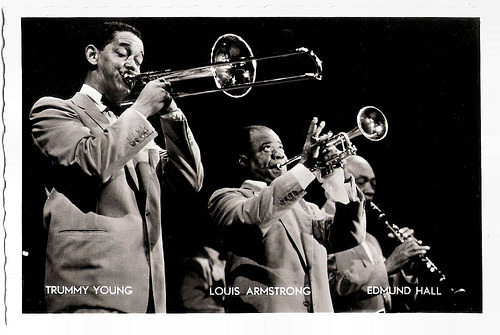
Dutch postcard by N.V. Int. Filmpers (I.F.P.), Amsterdam, no. 1035. Photo: Joel Elkins. Louis Armstrong in the 1955 version of the All Stars, with Trummy Young on trombone and vocals, and Edmond Hall on clarinet and vocals.
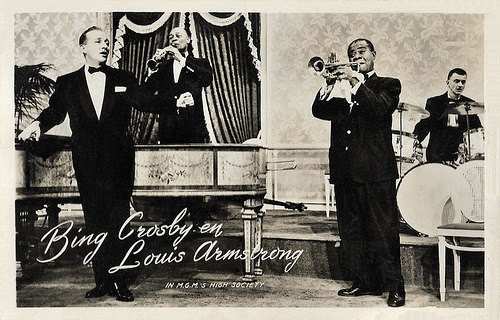
Dutch postcard by Uitg. Takken, Utrecht, no. 3024. Photo: MGM. Publicity still for High Society (Charles Walters, 1956) with Bing Crosby.
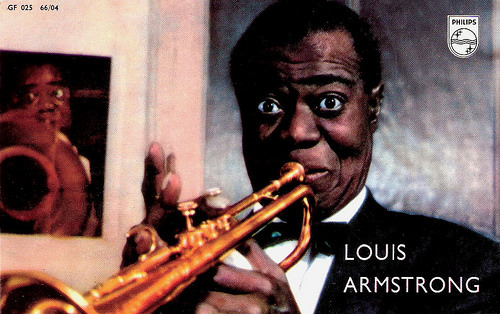
Dutch promotion card by Philips, no. GF 025 66/04.
One of the first truly popular African-American entertainers to 'cross over'
Louis Armstrong was also an influential singer, with his instantly recognisable gravelly voice. He demonstrated great mastery as an improviser, bending the lyrics and melody of a song for expressive purposes. He was also very skilled at scat singing.
Although his career as a recording artist dates back to the 1920s, when he made now-classic recordings with Joe 'King' Oliver, Bessie Smith and Jimmie Rodgers, as well as his own Hot Five and Hot Seven groups, his biggest hits as a recording artist came comparatively late in his life. Armstrong had nineteen Top Ten hits including When The Saints Go Marching In (1938), Mack the Knife (1955), Stompin' at the Savoy (1956) with Ella Fitzgerald, and What a Wonderful World (1967).
Armstrong's influence extends well beyond jazz, and by the end of his career in the 1960s, he was widely regarded as a profound influence on popular music in general. In 1964, Armstrong knocked The Beatles off the top of the Billboard Hot 100 chart with Hello, Dolly!, which gave the 63-year-old performer a U.S. record as the oldest artist to have a number one song.
Armstrong appeared in more than a dozen Hollywood films, usually playing a bandleader or musician. He appeared with Bing Crosby in the musical Pennies from Heaven (Norman Z. MacLeod, 1936), and with Mae West in Every Day's a Holiday (A. Edward Sutherland, 1937).
In the innovating musical Cabin in the Sky (Vincente Minnelli, Busby Berkeley, 1943) featuring an All Star, All Black cast, Louis played 'The Trumpeter' opposite Ethel Waters and Lena Horne. In 1947, he played himself opposite Billie Holiday in New Orleans (Arthur Lubin, 1947), which chronicled the demise of the Storyville district and the ensuing exodus of musicians from New Orleans to Chicago.
Armstrong also joined Danny Kaye and Virginia Mayo in the comedy A Song Is Born (Howard Hawks, 1948). The best parts of the film are the music scenes with Armstrong, Tommy Dorsey, Charlie Barnett, Lionel Hampton, and Benny Goodman, playing kick-arse Jazz. In The Glenn Miller Story (Anthony Mann, 1954), Armstrong jammed with Miller (James Stewart) and a few other noted musicians of the time.
His most familiar role was as the bandleader in the musical High Society (Charles Walters, 1956). He functions as a very partisan Greek Chorus , who tells you right up front who he's pulling for to win Grace Kelly and he helps musically along the way, performing a duet with Bing Crosby.
In The Five Pennies (Melville Shavelson, 1959), the story of the cornetist Red Nichols, Armstrong played himself as well as singing and playing several classic numbers. With leading actor Danny Kaye, Armstrong performed a duet of When the Saints Go Marching In, during which Kaye impersonated Armstrong.
He also appeared in several European films, including the Italian-French musical Saluti e baci/The Road to Happiness (Maurice Labro, Giorgio Simonelli, 1953) with Georges Guétary , the German musical Die Nacht vor der Premiere/The Night before the Premiere (Georg Jacoby, 1959) with Marika Rökk , and the Danish musical Kærlighedens melodi/The melody of love (Bent Christensen, 1959) with Nina and Frederik .
Armstrong was one of the first truly popular African-American entertainers to 'cross over', whose skin colour was secondary to his music in an America that was extremely racially divided at the time. He rarely publicly politicised his race, often to the dismay of fellow African Americans, but Armstrong was the only Black Jazz musician to publicly speak out against school segregation in 1957 during the Little Rock crisis. His artistry and personality allowed him access to the upper echelons of American society, then highly restricted for black men. Despite his fame, he remained a humble man and lived a simple life in a working-class neighbourhood.
Louis Armstrong remained married to Lucille Wilson until his death in 1971, a month away from what would have been his 70th birthday on 4 August. Embittered by the treatment of blacks in his hometown of New Orleans, he chose to be buried in New York City at the Flushing Cemetery, not too far from his home in Corona, Queens. He left his entire estate to his beloved wife, who died in 1983. Armstrong wrote two autobiographies. His house in Corona, where Armstrong lived for almost 28 years, was declared a National Historic Landmark in 1977. Today, it is a museum where fans can check out his residence and its belongings as a citizen of New York City.
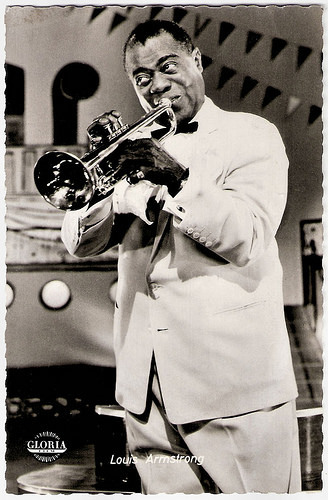
German postcard by Kolibri-Verlag, Minden/Westf., no. 765. no. CK-289. Photo: Alfa / Gloria / Kiebig. Publicity still for La Paloma (Paul Martin, 1959).
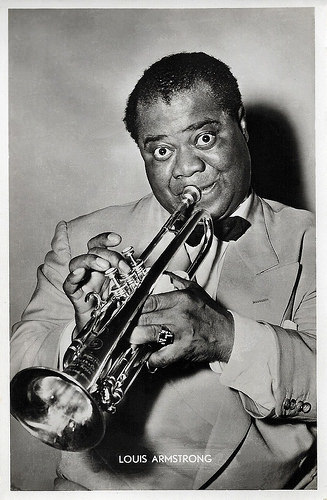
Vintage postcard, no. 111.
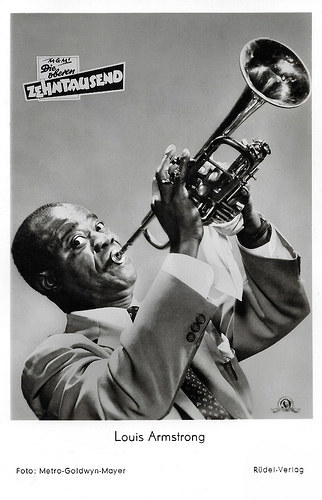
German postcard by Rüdel-Verlag, Hamburg-Bergedorf, no. 1988. Photo: MGM. Publicity still for High Society (Charles Walters, 1956). The German title of the film is Die oberen Zehntausend (The top ten thousand).
Sources: (IMDb), Louis Armstrong Educational Foundation, Wikipedia and .

French postcard by Editions P.I., Paris, no. CK-289. Photo: Arthur Grimm / Ufa.

German postcard by ISV, no. H 37.
Born in the Battlefield
Louis Daniel Armstrong was born in New Orleans, Louisiana, in the Storyville District known as 'the Battlefield' in 1901. His parents were Mary Albert and William Armstrong. William abandoned the family shortly after, and Louis grew up poor in a single-parent household. He left school at the 5th grade to help support his family. He sang on street corners, sold newspapers and delivered coal.
Louis was 13 when he celebrated New Year's Eve on 31 December 1912 by running out on the street and firing a blank from a pistol that belonged to the current man in his mother's life. He was arrested and placed in the Colored Waif's Home for boys. There, he learned to play the bugle cornet and the clarinet and joined the home's brass band. Armstrong's first teacher Peter Davis taught him there to read music. After 18 months, Louis left the Home determined to become a musician.
The young Armstrong played in brass bands and riverboats in New Orleans, first on an excursion boat in September 1918. At 18, he got a job in the Kid Ory Band in New Orleans. Armstrong married Daisy Parker as his career as a musician developed. In 1922, he followed his mentor, Joe 'King' Oliver, to Chicago to play in the Creole Jazz Band. He made his first recordings with that band in 1923. While in Chicago, Armstrong networked with other jazz musicians, reconnecting with his friend, Bix Biederbecke, and made new contacts, which included Hoagy Carmichael and Lil Hardin.
Lil was a graduate of Fisk University and an excellent pianist who could read, write and arrange music. She encouraged and enhanced Louis' career, and they married in 1924. Armstrong became very popular and one of the genre's most sought after trumpeters. He travelled a great deal and spent considerable time in Chicago and New York. He first moved to the Big Apple in 1924 to join Fletcher Henderson's Orchestra. He stayed in New York for a while but moved back to Chicago in October of 1925.
Armstrong later went back to New York in 1929. Armstrong appeared on Broadway in Hot Chocolates, in which he introduced Fats Waller's Ain't Misbehavin', his first popular song hit. During that time, some of his most important and successful work was accomplished with his Hot Fives and Hot Sevens Bands. Armstrong's interpretation of Hoagy Carmichael's Stardust became one of the most successful versions of this song ever recorded, showcasing Armstrong's unique vocal sound and style and his innovative approach to singing songs that had already become standards. In 1931, Armstrong appeared in his first film, Ex-Flame. That year, Armstrong and Lil Hardin separated and later divorced in 1938.
Dale O'Connor at IMDb : "He made a tour of Europe in 1932. During a command performance for King George V, he forgot he had been told that performers were not to refer to members of the royal family while playing for them. Just before picking up his trumpet for a really hot number, he announced: 'This one's for you, Rex.'" After this Grand Tour of Europe, Satchmo became Armstrong's nickname. A London music magazine editor had written erroneously 'Satchmo' in an article (Armstrong's nickname was 'Satchelmouth') and the name stuck.
In 1937, Armstrong substituted for Rudy Vallee on the CBS radio network and became the first African American to host a sponsored, national broadcast. After his divorce, Louis married Alpha Smith in 1938. While maintaining a vigorous work schedule, as well as living and travelling back and forth to Chicago and California, Armstrong moved back to New York in the late 1930s and later married Lucille Wilson in 1942.

Dutch postcard by N.V. Int. Filmpers (I.F.P.), Amsterdam, no. 1035. Photo: Joel Elkins. Louis Armstrong in the 1955 version of the All Stars, with Trummy Young on trombone and vocals, and Edmond Hall on clarinet and vocals.

Dutch postcard by Uitg. Takken, Utrecht, no. 3024. Photo: MGM. Publicity still for High Society (Charles Walters, 1956) with Bing Crosby.

Dutch promotion card by Philips, no. GF 025 66/04.
One of the first truly popular African-American entertainers to 'cross over'
Louis Armstrong was also an influential singer, with his instantly recognisable gravelly voice. He demonstrated great mastery as an improviser, bending the lyrics and melody of a song for expressive purposes. He was also very skilled at scat singing.
Although his career as a recording artist dates back to the 1920s, when he made now-classic recordings with Joe 'King' Oliver, Bessie Smith and Jimmie Rodgers, as well as his own Hot Five and Hot Seven groups, his biggest hits as a recording artist came comparatively late in his life. Armstrong had nineteen Top Ten hits including When The Saints Go Marching In (1938), Mack the Knife (1955), Stompin' at the Savoy (1956) with Ella Fitzgerald, and What a Wonderful World (1967).
Armstrong's influence extends well beyond jazz, and by the end of his career in the 1960s, he was widely regarded as a profound influence on popular music in general. In 1964, Armstrong knocked The Beatles off the top of the Billboard Hot 100 chart with Hello, Dolly!, which gave the 63-year-old performer a U.S. record as the oldest artist to have a number one song.
Armstrong appeared in more than a dozen Hollywood films, usually playing a bandleader or musician. He appeared with Bing Crosby in the musical Pennies from Heaven (Norman Z. MacLeod, 1936), and with Mae West in Every Day's a Holiday (A. Edward Sutherland, 1937).
In the innovating musical Cabin in the Sky (Vincente Minnelli, Busby Berkeley, 1943) featuring an All Star, All Black cast, Louis played 'The Trumpeter' opposite Ethel Waters and Lena Horne. In 1947, he played himself opposite Billie Holiday in New Orleans (Arthur Lubin, 1947), which chronicled the demise of the Storyville district and the ensuing exodus of musicians from New Orleans to Chicago.
Armstrong also joined Danny Kaye and Virginia Mayo in the comedy A Song Is Born (Howard Hawks, 1948). The best parts of the film are the music scenes with Armstrong, Tommy Dorsey, Charlie Barnett, Lionel Hampton, and Benny Goodman, playing kick-arse Jazz. In The Glenn Miller Story (Anthony Mann, 1954), Armstrong jammed with Miller (James Stewart) and a few other noted musicians of the time.
His most familiar role was as the bandleader in the musical High Society (Charles Walters, 1956). He functions as a very partisan Greek Chorus , who tells you right up front who he's pulling for to win Grace Kelly and he helps musically along the way, performing a duet with Bing Crosby.
In The Five Pennies (Melville Shavelson, 1959), the story of the cornetist Red Nichols, Armstrong played himself as well as singing and playing several classic numbers. With leading actor Danny Kaye, Armstrong performed a duet of When the Saints Go Marching In, during which Kaye impersonated Armstrong.
He also appeared in several European films, including the Italian-French musical Saluti e baci/The Road to Happiness (Maurice Labro, Giorgio Simonelli, 1953) with Georges Guétary , the German musical Die Nacht vor der Premiere/The Night before the Premiere (Georg Jacoby, 1959) with Marika Rökk , and the Danish musical Kærlighedens melodi/The melody of love (Bent Christensen, 1959) with Nina and Frederik .
Armstrong was one of the first truly popular African-American entertainers to 'cross over', whose skin colour was secondary to his music in an America that was extremely racially divided at the time. He rarely publicly politicised his race, often to the dismay of fellow African Americans, but Armstrong was the only Black Jazz musician to publicly speak out against school segregation in 1957 during the Little Rock crisis. His artistry and personality allowed him access to the upper echelons of American society, then highly restricted for black men. Despite his fame, he remained a humble man and lived a simple life in a working-class neighbourhood.
Louis Armstrong remained married to Lucille Wilson until his death in 1971, a month away from what would have been his 70th birthday on 4 August. Embittered by the treatment of blacks in his hometown of New Orleans, he chose to be buried in New York City at the Flushing Cemetery, not too far from his home in Corona, Queens. He left his entire estate to his beloved wife, who died in 1983. Armstrong wrote two autobiographies. His house in Corona, where Armstrong lived for almost 28 years, was declared a National Historic Landmark in 1977. Today, it is a museum where fans can check out his residence and its belongings as a citizen of New York City.

German postcard by Kolibri-Verlag, Minden/Westf., no. 765. no. CK-289. Photo: Alfa / Gloria / Kiebig. Publicity still for La Paloma (Paul Martin, 1959).

Vintage postcard, no. 111.

German postcard by Rüdel-Verlag, Hamburg-Bergedorf, no. 1988. Photo: MGM. Publicity still for High Society (Charles Walters, 1956). The German title of the film is Die oberen Zehntausend (The top ten thousand).
Sources: (IMDb), Louis Armstrong Educational Foundation, Wikipedia and .
Published on November 27, 2018 22:00
November 26, 2018
Mari Blanchard
Beautiful blonde American actress Mari Blanchard (1927–1970) was known for playing alluring harem girls and saloon dancers in American adventure films and Westerns of the 1950s and early 1960s. Blanchard was a B-movie queen who excelled at playing tarts, home wreckers, and other assorted villainesses.

Italian postcard by Bromofoto, no. 552. Photo: Universal International.
Running away from home to join the Circus
Mari (sometimes written as Mary) Blanchard was born in 1923, in Long Beach, California. Her father was an oil and mining tycoon; her mother, Dr. Mary Sennott, a psychotherapist.
Blanchard trained from childhood for a dancing career, but at the age of nine, she suffered from severe polio. She fought back against her illness and was walking again by age eleven. To exercise her once-paralysed limbs, she swam daily for several years afterwards.
At 17, she ran away from home to join the Cole Brothers Circus and learned how to ride elephants, perform bareback on horses and fly on the trapeze bar. Her mother found her and took her back home. She attended Santa Barbara State College, UCLA, and USC to study international law and graduated with a Bachelors Degree in International Law.
In the late 1940s, Mari joined the Conover Agency as an advertising model and was a successful model and film extra. In 1948, her beautiful blue-eyed brunette (later blonde) looks and 36-25-36 figure became the inspiration for cartoonist and writer Al Capp in creating the voluptuous Stupefyin' Jones character for his L'il Abner comics.
After she was seen by a Paramount producer in a bubble bath commercial ad for Kodak that appeared on the back of The Hollywood Reporter, she was offered a film contract. From 1951 to 1952, she took roles in a number of films at MGM, RKO, and Paramount, but was relegated to walk-ons and bit parts. I.S. Mowis at IMDb : "Ten Tall Men (1951), for example, limited her to a token stroll down a street, twirling a parasol and smiling seductively at members of the Foreign Legion."
In 1952, she was signed by Universal-International. There her fortunes improved somewhat. Her first film at the studio was Back at the Front (George Sherman, 1952) with Tom Ewell. In the romantic adventure The Veils of Bagdad (George Sherman, 1953) she co-starred with Victor Mature. One of her more memorable tongue-in-cheek exotic roles was the Venusian queen, Allura, in the comedy Abbott and Costello Go to Mars (Charles Lamont, 1953).
She starred with Audie Murphy in the Western Destry (George Marshall, 1954). I.S. Mowis at IMDb : "A remake of the classic Destry Rides Again (1939), she was cast in the Marlene Dietrich part and took great pains to affect a totally different look, darkening her hair, so as not to be compared to the great star. Even the name of her character was changed from 'Frenchy' to 'Brandy'. Destry was not all smooth sailing. There was tension between her and director George Marshall (who had also directed the original version) and Mari suffered a facial injury as the result of a fight scene. The film was critically well received." However, her contract was not renewed by Universal.
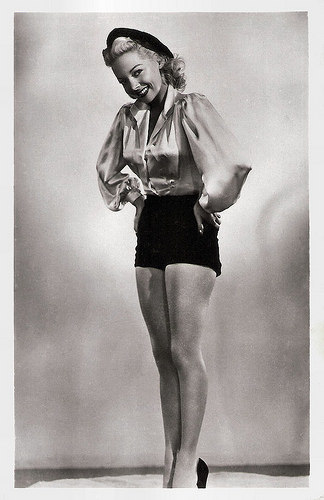
French postcard by Editions P.I., Paris, no. 609. Photo: Paramount Pictures, 1950.
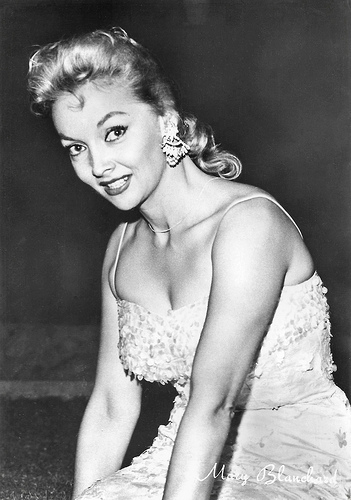
Italian postcard by Rotalfoto, Milano, no. 733.
Playing bad girls and ladies of ill-repute
Mari Blanchard worked for television and for minor studios. She continued to excel at playing bad girls and ladies of ill-repute. In Son of Sinbad (Ted Tetzlaff, 1955), she was one of the 127 women in ancient Baghdad who dazzled Dale Robertson as Sinbad - and of course the audiences.
On TV, she starred in episodes of such series as Climax! (1955) and Casablanca (1956). In the cinema, she starred as a female monster in the B-movie She Devil (Kurt Neumann, 1957). She played a TB victim injected with a serum turning her into a Mr. Hyde-like killer.
Then she was the love interest of Lex Barker in Jungle Heat (Howard W. Koch, 1957), shot on Kauai, Hawaii. A curiosity was her appearance in the Turkish film Karasu (Turgut Demirag, 1958). Following her work on these films, Blanchard began to focus increasingly on performing on television.
In the 1960–1961 television season, she starred as hotel-owner Kate O'Hara in the short lived Western series Klondike with James Coburn. She also guest-starred in episodes of Rawhide (1959-1961), 77 Sunset Strip (1961) and Perry Mason (1962).
Among her later films were the musical Don't Knock the Twist (Oscar Rudolph, 1962) with Chubby Checker and the horror film Twice-Told Tales (Sidney Salkow, 1963) starring Vincent Price. In 1963 she had a small but flamboyant role as the cheerful and likeable town madam Camille in the John Wayne Western McLintock! (Andrew V. McLaglen, 1963). It was her final film appearance.
Mari Blanchard was diagnosed with cancer. She retired, and acted only in a few TV programs when her cancer temporarily went into remission. Her last credited performance was in 1968, playing the part of Madame Gamar on the series It Takes a Thief. Following a struggle of seven years, Mari Blanchard died in 1970. She was only 43. In accordance with her wishes, her remains were cremated and scattered at sea.
Blanchard was married three times: to attorney Reese Hale Taylor, Jr. (1960-1961); George Shepard (1965-1966); and to photographer Vincent J. Conti (1967-1970). In the early to mid 1950s, she dated a string of men, including Greg Bautzer, once Joan Crawford's paramour. She dated Mel Torme before marrying photographer Vince Conti.
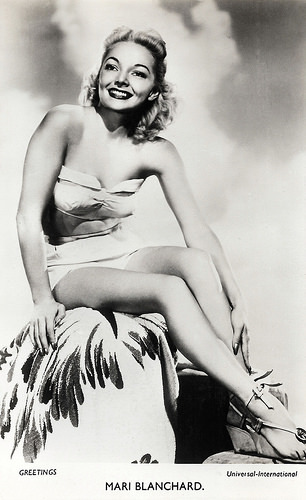
British card in the Greetings series. Photo: Universal-International.
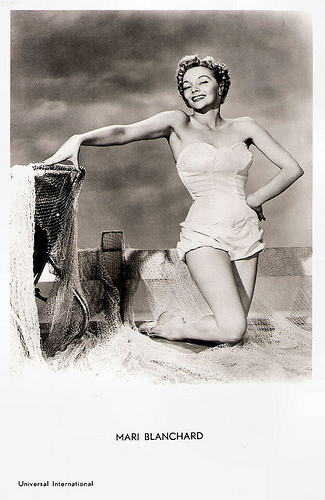
French postcard offered by Les Carbones Korès Carboplane, no. 308. Photo: Universal International.
Sources: (IMDb), Hal Erickson (AllMovie), Brian J. Walker (Brian's Drive-in Theater), William Bjornstad (Find A Grave), Glamour Girls of the Silver Screen, Wikipedia and IMDb.

Italian postcard by Bromofoto, no. 552. Photo: Universal International.
Running away from home to join the Circus
Mari (sometimes written as Mary) Blanchard was born in 1923, in Long Beach, California. Her father was an oil and mining tycoon; her mother, Dr. Mary Sennott, a psychotherapist.
Blanchard trained from childhood for a dancing career, but at the age of nine, she suffered from severe polio. She fought back against her illness and was walking again by age eleven. To exercise her once-paralysed limbs, she swam daily for several years afterwards.
At 17, she ran away from home to join the Cole Brothers Circus and learned how to ride elephants, perform bareback on horses and fly on the trapeze bar. Her mother found her and took her back home. She attended Santa Barbara State College, UCLA, and USC to study international law and graduated with a Bachelors Degree in International Law.
In the late 1940s, Mari joined the Conover Agency as an advertising model and was a successful model and film extra. In 1948, her beautiful blue-eyed brunette (later blonde) looks and 36-25-36 figure became the inspiration for cartoonist and writer Al Capp in creating the voluptuous Stupefyin' Jones character for his L'il Abner comics.
After she was seen by a Paramount producer in a bubble bath commercial ad for Kodak that appeared on the back of The Hollywood Reporter, she was offered a film contract. From 1951 to 1952, she took roles in a number of films at MGM, RKO, and Paramount, but was relegated to walk-ons and bit parts. I.S. Mowis at IMDb : "Ten Tall Men (1951), for example, limited her to a token stroll down a street, twirling a parasol and smiling seductively at members of the Foreign Legion."
In 1952, she was signed by Universal-International. There her fortunes improved somewhat. Her first film at the studio was Back at the Front (George Sherman, 1952) with Tom Ewell. In the romantic adventure The Veils of Bagdad (George Sherman, 1953) she co-starred with Victor Mature. One of her more memorable tongue-in-cheek exotic roles was the Venusian queen, Allura, in the comedy Abbott and Costello Go to Mars (Charles Lamont, 1953).
She starred with Audie Murphy in the Western Destry (George Marshall, 1954). I.S. Mowis at IMDb : "A remake of the classic Destry Rides Again (1939), she was cast in the Marlene Dietrich part and took great pains to affect a totally different look, darkening her hair, so as not to be compared to the great star. Even the name of her character was changed from 'Frenchy' to 'Brandy'. Destry was not all smooth sailing. There was tension between her and director George Marshall (who had also directed the original version) and Mari suffered a facial injury as the result of a fight scene. The film was critically well received." However, her contract was not renewed by Universal.

French postcard by Editions P.I., Paris, no. 609. Photo: Paramount Pictures, 1950.

Italian postcard by Rotalfoto, Milano, no. 733.
Playing bad girls and ladies of ill-repute
Mari Blanchard worked for television and for minor studios. She continued to excel at playing bad girls and ladies of ill-repute. In Son of Sinbad (Ted Tetzlaff, 1955), she was one of the 127 women in ancient Baghdad who dazzled Dale Robertson as Sinbad - and of course the audiences.
On TV, she starred in episodes of such series as Climax! (1955) and Casablanca (1956). In the cinema, she starred as a female monster in the B-movie She Devil (Kurt Neumann, 1957). She played a TB victim injected with a serum turning her into a Mr. Hyde-like killer.
Then she was the love interest of Lex Barker in Jungle Heat (Howard W. Koch, 1957), shot on Kauai, Hawaii. A curiosity was her appearance in the Turkish film Karasu (Turgut Demirag, 1958). Following her work on these films, Blanchard began to focus increasingly on performing on television.
In the 1960–1961 television season, she starred as hotel-owner Kate O'Hara in the short lived Western series Klondike with James Coburn. She also guest-starred in episodes of Rawhide (1959-1961), 77 Sunset Strip (1961) and Perry Mason (1962).
Among her later films were the musical Don't Knock the Twist (Oscar Rudolph, 1962) with Chubby Checker and the horror film Twice-Told Tales (Sidney Salkow, 1963) starring Vincent Price. In 1963 she had a small but flamboyant role as the cheerful and likeable town madam Camille in the John Wayne Western McLintock! (Andrew V. McLaglen, 1963). It was her final film appearance.
Mari Blanchard was diagnosed with cancer. She retired, and acted only in a few TV programs when her cancer temporarily went into remission. Her last credited performance was in 1968, playing the part of Madame Gamar on the series It Takes a Thief. Following a struggle of seven years, Mari Blanchard died in 1970. She was only 43. In accordance with her wishes, her remains were cremated and scattered at sea.
Blanchard was married three times: to attorney Reese Hale Taylor, Jr. (1960-1961); George Shepard (1965-1966); and to photographer Vincent J. Conti (1967-1970). In the early to mid 1950s, she dated a string of men, including Greg Bautzer, once Joan Crawford's paramour. She dated Mel Torme before marrying photographer Vince Conti.

British card in the Greetings series. Photo: Universal-International.

French postcard offered by Les Carbones Korès Carboplane, no. 308. Photo: Universal International.
Sources: (IMDb), Hal Erickson (AllMovie), Brian J. Walker (Brian's Drive-in Theater), William Bjornstad (Find A Grave), Glamour Girls of the Silver Screen, Wikipedia and IMDb.
Published on November 26, 2018 22:00
November 25, 2018
Jack Palance
Jack Palance (1919-2006) was an American actor and singer, who portrayed some of the most intensely despised villains witnessed in Westerns and melodramas of the 1950s. In the late 1950s, he became an international star, who often played in Spaghetti Westerns and in the Nouvelle Vague classic Le Mépris (1963) with Brigitte Bardot. He was nominated for three Academy Awards for Best Actor in a Supporting Role, winning an Oscar for his grizzled, eccentric role in City Slickers (1991).

Spanish postcard by Postalcolor, Hospitalet (Barcelona), no. 107. Photo: Warner Bros.
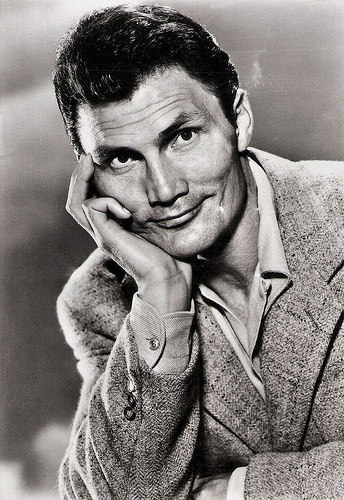
Spanish postcard by ANMAVI, no. 29.
Alan Ladd's biggest nightmare
Jack Palance was born Vladimir Ivanovich Palahniuk in Lattimer Mines, Pennsylvania, in 1919. He was one of the six children of Ukrainian immigrants, Anna (née Gramiak) and Ivan Palahniuk, an anthracite coal miner. After his father had died of black lung disease, the sensitive, artistic lad worked in coal mines before becoming a professional boxer in the late 1930s. Fighting under the name Jack Brazzo, Palance reportedly compiled a record of 15 consecutive victories with 12 knockouts before losing a close decision to future heavyweight contender Joe Baksi in a Pier-6 brawl.
With the outbreak of World War II, Palance's athletic career ended, and his military career began as a member of the United States Army Air Forces. He was honorably discharged from the United States Army Air Forces in 1944. After the war, he attended Stanford University, leaving one credit shy of graduating to pursue a career in the theatre. During his university years, he worked as a short order cook, waiter, soda jerk, lifeguard at Jones Beach State Park, and photographer's model. His new last name, Palance, was a derivative of his original name. No one could pronounce his last name and it was suggested that he be called Palanski. From that he decided just to use Palance instead.
In 1947, Palance made his Broadway debut in The Big, playing a Russian soldier, directed by Robert Montgomery. His acting break came as Marlon Brando 's understudy in A Streetcar Named Desire, and he eventually replaced Brando on stage as Stanley Kowalski. He debuted on television in 1949 and made his screen debut as a gangster in the Film Noir Panic in the Streets (Eliz Kazan, 1950). As a plague carrying fugitive, he stood out among a powerhouse cast including Richard Widmark and Paul Douglas.
The same year he made fine use of his former boxing skills and war experience for the film Halls of Montezuma (Lewis Milestone, 1951) about the United States Marines in World War II. He returned to Broadway for Darkness at Noon (1951), by Sidney Kingsley, which was a minor hit. Palance was second billed in just his third film, playing opposite Joan Crawford in the thriller Sudden Fear (David Miller, 1952). According to Gary Brumburgh at IMDb , Palance found “the right menace and intensity to pretty much steal the proceedings”, and he received an Oscar nomination for Best Supporting Actor.
He was nominated in the same category the following year as well, for his role as the hired gunfighter Jack Wilson in Shane (George Stevens, 1953). Brumburgh again: “arguably his finest villain of the decade, that of creepy, sadistic gunslinger Jack Wilson who becomes Alan Ladd's biggest nightmare (not to mention others) in the classic western Shane (1953). Their climactic showdown alone is text book.“ Shane was a huge hit and Palance was now established as a film name.
He played another villain in Second Chance (Rudolph Maté, 1953) opposite Robert Mitchum and was an Indian in Arrowhead (Charles Marquis Warren, 1953), opposite Charlton Heston. He got a chance to play a heroic role in the thriller Flight to Tangier (Charles Marquis Warren, 1953). Palance played the lead in Man in the Attic (Hugo Freegonese, 1953), a remake of The Lodger (1927), the classic silent film by Alfred Hitchcock. Palance was Attila the Hun in Sign of the Pagan (Douglas Sirk, 1954) with Jeff Chandler, and Simon Magus in the Ancient World epic The Silver Chalice (Victor Saville, 1954) with Paul Newman.
He had the star part in I Died a Thousand Times (Stuart Heisler, 1955), a remake of High Sierra and was cast by Robert Aldrich in two star parts: as a Hollywood star in the Film Noir The Big Knife (1955) based on the play by Clifford Odets; and as a tough WW II soldier in Attack (1956). He was in a Western, The Lonely Man (Henry Levin, 1957), playing the father of Anthony Perkins, and played a double role in House of Numbers (Russell Rouse, 1957). In 1957, Palance won an Emmy Award for best actor for his portrayal of Mountain McClintock in the Playhouse 90 production of Rod Serling's Requiem for a Heavyweight.
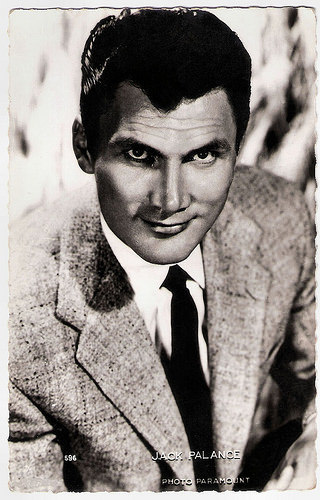
French postcard by P.I., no. 596, 1955. Photo: Paramount.
The Meanest Guy That Ever Lived
In the following years, Jack Palance became an international star. He was hired by British Warwick Films to play the hero in The Man Inside (John Gilling, 1958). He was reunited with Robert Aldrich and Jeff Chandler on Ten Seconds to Hell (1959) playing a bomb disposal expert, filmed in Germany. He made the drama Flor de Mayo/Beyond All Limits (Roberto Gavaldón, 1959), with Maria Felix , in Mexico, and Austerlitz (Abel Gance, 1960) in France.
Then he did a series of adventure films in Italy: Revak the Rebel/The Barbarians (Rudolph Maté, 1961) with Milly Vitale , Rosmunda e Alboino/Sword of the Conqueror (Carlo Campogalliani, 1961) with Eleonora Rossi-Drago , and I mongoli/The Mongols (Andre DeToth, Leopoldo Savona, 1961) opposite Anita Ekberg .
Next he appeared in the Commedia all'italiana Il giudizio universale/The Last Judgment (Vittorio De Sica, 1961) with Alberto Sordi , and the religious epic Barabbas (Richard Fleischer, 1961), starring Anthony Quinn . Jean-Luc Godard persuaded Palance to take on the role of Hollywood producer Jeremy Prokosch in the nouvelle vague movie Le Mépris/Contempt (1963) with Brigitte Bardot . Although the main dialogue was in French, Palance spoke mostly English.
Palance returned to the US to star in the TV series The Greatest Show on Earth (1963–1964). He played a gangster in Once a Thief (Ralph Thomas, 1965) with Alain Delon . He had a featured role opposite Lee Marvin and Burt Lancaster in the Western adventure The Professionals (Richard Brooks, 1966). He guest starred on The Man from UNCLE and the episodes were released as a film, The Spy in the Green Hat (1967). Palance went to England to do Torture Garden (Freddie Francis, 1967) and did Kill a Dragon (Michael D. Moore, 1968) in Hong Kong.
In 1969, Palance recorded a country music album in Nashville, released on Warner Bros. Records. It featured Palance's self-penned song The Meanest Guy That Ever Lived. His films continued to be international co-productions: They Came to Rob Las Vegas (Antonio Isasi-Isasmendi, 1968), the Zapata Western Il mercenario/The Mercenary (Sergio Corbucci, 1968) with Franco Nero , The Desperados (Henry Levin, 1969), and Justine ovvero le disavventure della virtù/Marquis de Sade: Justine (Jésus Franco, 1969), starring Klaus Kinski .
Palance had an excellent part in the Hollywood blockbuster Che! (Richard Fleischer, 1969) playing Fidel Castro opposite Omar Sharif in the title role but the film flopped. Palance went back to action films and Westerns like the Macaroni-War film La legione dei dannati/Battle of the Commandos (Umberto Lenzi, 1970), with Curd Jürgens , and the Zapata Western Companeros (Sergio Corbucci, 1970) with Franco Nero and Tomás Milián.
He had another good role in Monte Walsh (William A. Fraker, 1970), from the author of Shane, opposite Lee Marvin, but the film was a box office disappointment. So too was The Horsemen (John Frankenheimer, 1971) with Omar Sharif. Palance supported Bud Spencer in Si può fare... amigo/It Can Be Done Amigo (Maurizio Lucidi, 1972) and Charles Bronson in Chato's Land (Michael Winner, 1972) and had the lead in the Spaghetti Western Tedeum/Sting of the West (Enzo G. Castellari, 1972).
He returned to Hollywood for Oklahoma Crude (Stanley Kramer, 1973) with Faye Dunaway , and then went to England to star in Craze (Freddie Francis, 1974) opposite Diana Dors .
In the late 1970s Palance was mostly based in Italy. He supported Ursula Andress and Giuliano Gemma in Africa Express (Michele Lupo, 1976), Lee Van Cleef in Diamante Lobo/God's Gun (Gianfranco Parolini, 1976), and Thomas Milian in Squadra antiscippo/The Cop in Blue Jeans (Bruno Corbucci, 1976).
Palance was in the exploitation film Eva Nera/Black Cobra Woman (Joe D’Amato, 1976) with Laura Gemser. He travelled to Canada to make the virtual reality film Welcome to Blood City (Peter Sasdy, 1977) and the US for the slasher film Alone in the Dark (Jack Sholder, 1982).
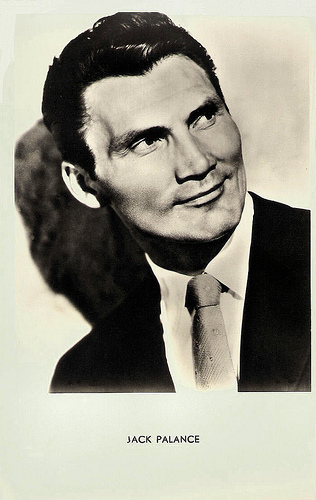
French postcard by Korès 'Carboplane', no. 328.
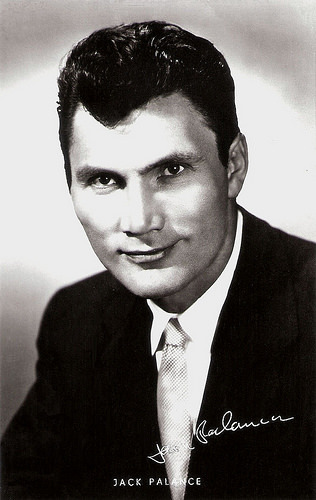
German postcard by Netter's Verlag, Berlin.
Billy Crystal... I crap bigger than him
In 1982, Jack Palance began hosting a television revival of Ripley's Believe It or Not!. The weekly series ran from 1982 to 1986 on the American ABC network. Palance had never been out of work since his career began. But his success on Ripley's Believe It or Not! and the international box-office hit of the German film Bagdad Cafe (Percy Adlon, 1987) resulted in a demand for his services in big budget Hollywood films.
He made memorable appearances as villains in Young Guns (Christopher Cain, 1988), Tango & Cash (Andrei Konchalovsky, 1989) and Batman (Tim Burton, 1989) starring Michael Keaton as Bruce Wayne/Batman and Jack Nicholson as the Joker.
In 1992, four decades after his film debut, Palance won an Academy Award for Best Supporting Actor for his performance as cowboy Curly Washburn in the comedy City Slickers (Ron Underwood, 1991). Stepping onstage to accept the award, the 6' 4" (1.93 m) actor looked down at 5' 7" (1.70 m) Oscar host Billy Crystal (also his co-star in the film), and joked, mimicking one of his lines from the film, "Billy Crystal... I crap bigger than him." He then dropped to the floor and demonstrated his ability, at age 73, to perform one-handed push-ups.
In 1993, during the opening of the Oscars, a spoof of that Oscar highlight featured Palance appearing to drag in an enormous Academy Award statuette with Crystal again hosting, riding on the rear end of it. Halfway across the stage, Palance dropped to the ground as if exhausted, but then performed several one-armed push-ups before regaining his feet and dragging the giant Oscar the rest of the way across the stage.
His later films include Cyborg 2 (Michael Schroeder, 1993) with Angelina Jolie, Cops & Robbersons (Michael Ritchie, 1994) with Chevy Chase, and City Slickers II: The Legend of Curly's Gold (Paul Weiland, 1994).
In 2003, he narrated the documentary Between Hitler and Stalin: Ukraine in World War II (Slavko Nowytski, 2003). In 2004, Palance, at the time chairman of the Hollywood Trident Foundation, walked out of a Russian Film Festival in Hollywood. After being introduced, Palance said, "I feel like I walked into the wrong room by mistake. I think that Russian film is interesting, but I have nothing to do with Russia or Russian film. My parents were born in Ukraine: I'm Ukrainian. I'm not Russian. So, excuse me, but I don't belong here."
Palance was awarded the title of ‘People's Artist’ by Vladimir Putin, president of Russia, but Palance refused the title. His final performance was in the TV film Back When We Were Grownups (Ron Underwood, 2004), opposite Blythe Danner.
Jack Palance was married to his first wife Virginia Baker from 1949 to 1968. They had three children: Holly (1950), Brooke (1952), and Cody (1955–1998). On New Year's Day 2003, Baker was struck and killed by a car in Los Angeles. Palance's daughter Brooke married Michael Wilding, son of Michael Wilding Sr. and Elizabeth Taylor ; they have three children. Cody Palance, an actor himself, appeared alongside his father in the film Young Guns. In 1987, Palance married his second wife Elaine Rogers.
In 2006, Jack Palance died of a sudden stroke at his daughter Holly's home in Montecito, California. He was 87.
Trailer Attack (1956). Source: Movieclips Classic Trailers (YouTube).
Trailer City Slickers (1991). Source: Trailer Chan (YouTube).
Sources: (IMDb), Wikipedia, and .

Spanish postcard by Postalcolor, Hospitalet (Barcelona), no. 107. Photo: Warner Bros.

Spanish postcard by ANMAVI, no. 29.
Alan Ladd's biggest nightmare
Jack Palance was born Vladimir Ivanovich Palahniuk in Lattimer Mines, Pennsylvania, in 1919. He was one of the six children of Ukrainian immigrants, Anna (née Gramiak) and Ivan Palahniuk, an anthracite coal miner. After his father had died of black lung disease, the sensitive, artistic lad worked in coal mines before becoming a professional boxer in the late 1930s. Fighting under the name Jack Brazzo, Palance reportedly compiled a record of 15 consecutive victories with 12 knockouts before losing a close decision to future heavyweight contender Joe Baksi in a Pier-6 brawl.
With the outbreak of World War II, Palance's athletic career ended, and his military career began as a member of the United States Army Air Forces. He was honorably discharged from the United States Army Air Forces in 1944. After the war, he attended Stanford University, leaving one credit shy of graduating to pursue a career in the theatre. During his university years, he worked as a short order cook, waiter, soda jerk, lifeguard at Jones Beach State Park, and photographer's model. His new last name, Palance, was a derivative of his original name. No one could pronounce his last name and it was suggested that he be called Palanski. From that he decided just to use Palance instead.
In 1947, Palance made his Broadway debut in The Big, playing a Russian soldier, directed by Robert Montgomery. His acting break came as Marlon Brando 's understudy in A Streetcar Named Desire, and he eventually replaced Brando on stage as Stanley Kowalski. He debuted on television in 1949 and made his screen debut as a gangster in the Film Noir Panic in the Streets (Eliz Kazan, 1950). As a plague carrying fugitive, he stood out among a powerhouse cast including Richard Widmark and Paul Douglas.
The same year he made fine use of his former boxing skills and war experience for the film Halls of Montezuma (Lewis Milestone, 1951) about the United States Marines in World War II. He returned to Broadway for Darkness at Noon (1951), by Sidney Kingsley, which was a minor hit. Palance was second billed in just his third film, playing opposite Joan Crawford in the thriller Sudden Fear (David Miller, 1952). According to Gary Brumburgh at IMDb , Palance found “the right menace and intensity to pretty much steal the proceedings”, and he received an Oscar nomination for Best Supporting Actor.
He was nominated in the same category the following year as well, for his role as the hired gunfighter Jack Wilson in Shane (George Stevens, 1953). Brumburgh again: “arguably his finest villain of the decade, that of creepy, sadistic gunslinger Jack Wilson who becomes Alan Ladd's biggest nightmare (not to mention others) in the classic western Shane (1953). Their climactic showdown alone is text book.“ Shane was a huge hit and Palance was now established as a film name.
He played another villain in Second Chance (Rudolph Maté, 1953) opposite Robert Mitchum and was an Indian in Arrowhead (Charles Marquis Warren, 1953), opposite Charlton Heston. He got a chance to play a heroic role in the thriller Flight to Tangier (Charles Marquis Warren, 1953). Palance played the lead in Man in the Attic (Hugo Freegonese, 1953), a remake of The Lodger (1927), the classic silent film by Alfred Hitchcock. Palance was Attila the Hun in Sign of the Pagan (Douglas Sirk, 1954) with Jeff Chandler, and Simon Magus in the Ancient World epic The Silver Chalice (Victor Saville, 1954) with Paul Newman.
He had the star part in I Died a Thousand Times (Stuart Heisler, 1955), a remake of High Sierra and was cast by Robert Aldrich in two star parts: as a Hollywood star in the Film Noir The Big Knife (1955) based on the play by Clifford Odets; and as a tough WW II soldier in Attack (1956). He was in a Western, The Lonely Man (Henry Levin, 1957), playing the father of Anthony Perkins, and played a double role in House of Numbers (Russell Rouse, 1957). In 1957, Palance won an Emmy Award for best actor for his portrayal of Mountain McClintock in the Playhouse 90 production of Rod Serling's Requiem for a Heavyweight.

French postcard by P.I., no. 596, 1955. Photo: Paramount.
The Meanest Guy That Ever Lived
In the following years, Jack Palance became an international star. He was hired by British Warwick Films to play the hero in The Man Inside (John Gilling, 1958). He was reunited with Robert Aldrich and Jeff Chandler on Ten Seconds to Hell (1959) playing a bomb disposal expert, filmed in Germany. He made the drama Flor de Mayo/Beyond All Limits (Roberto Gavaldón, 1959), with Maria Felix , in Mexico, and Austerlitz (Abel Gance, 1960) in France.
Then he did a series of adventure films in Italy: Revak the Rebel/The Barbarians (Rudolph Maté, 1961) with Milly Vitale , Rosmunda e Alboino/Sword of the Conqueror (Carlo Campogalliani, 1961) with Eleonora Rossi-Drago , and I mongoli/The Mongols (Andre DeToth, Leopoldo Savona, 1961) opposite Anita Ekberg .
Next he appeared in the Commedia all'italiana Il giudizio universale/The Last Judgment (Vittorio De Sica, 1961) with Alberto Sordi , and the religious epic Barabbas (Richard Fleischer, 1961), starring Anthony Quinn . Jean-Luc Godard persuaded Palance to take on the role of Hollywood producer Jeremy Prokosch in the nouvelle vague movie Le Mépris/Contempt (1963) with Brigitte Bardot . Although the main dialogue was in French, Palance spoke mostly English.
Palance returned to the US to star in the TV series The Greatest Show on Earth (1963–1964). He played a gangster in Once a Thief (Ralph Thomas, 1965) with Alain Delon . He had a featured role opposite Lee Marvin and Burt Lancaster in the Western adventure The Professionals (Richard Brooks, 1966). He guest starred on The Man from UNCLE and the episodes were released as a film, The Spy in the Green Hat (1967). Palance went to England to do Torture Garden (Freddie Francis, 1967) and did Kill a Dragon (Michael D. Moore, 1968) in Hong Kong.
In 1969, Palance recorded a country music album in Nashville, released on Warner Bros. Records. It featured Palance's self-penned song The Meanest Guy That Ever Lived. His films continued to be international co-productions: They Came to Rob Las Vegas (Antonio Isasi-Isasmendi, 1968), the Zapata Western Il mercenario/The Mercenary (Sergio Corbucci, 1968) with Franco Nero , The Desperados (Henry Levin, 1969), and Justine ovvero le disavventure della virtù/Marquis de Sade: Justine (Jésus Franco, 1969), starring Klaus Kinski .
Palance had an excellent part in the Hollywood blockbuster Che! (Richard Fleischer, 1969) playing Fidel Castro opposite Omar Sharif in the title role but the film flopped. Palance went back to action films and Westerns like the Macaroni-War film La legione dei dannati/Battle of the Commandos (Umberto Lenzi, 1970), with Curd Jürgens , and the Zapata Western Companeros (Sergio Corbucci, 1970) with Franco Nero and Tomás Milián.
He had another good role in Monte Walsh (William A. Fraker, 1970), from the author of Shane, opposite Lee Marvin, but the film was a box office disappointment. So too was The Horsemen (John Frankenheimer, 1971) with Omar Sharif. Palance supported Bud Spencer in Si può fare... amigo/It Can Be Done Amigo (Maurizio Lucidi, 1972) and Charles Bronson in Chato's Land (Michael Winner, 1972) and had the lead in the Spaghetti Western Tedeum/Sting of the West (Enzo G. Castellari, 1972).
He returned to Hollywood for Oklahoma Crude (Stanley Kramer, 1973) with Faye Dunaway , and then went to England to star in Craze (Freddie Francis, 1974) opposite Diana Dors .
In the late 1970s Palance was mostly based in Italy. He supported Ursula Andress and Giuliano Gemma in Africa Express (Michele Lupo, 1976), Lee Van Cleef in Diamante Lobo/God's Gun (Gianfranco Parolini, 1976), and Thomas Milian in Squadra antiscippo/The Cop in Blue Jeans (Bruno Corbucci, 1976).
Palance was in the exploitation film Eva Nera/Black Cobra Woman (Joe D’Amato, 1976) with Laura Gemser. He travelled to Canada to make the virtual reality film Welcome to Blood City (Peter Sasdy, 1977) and the US for the slasher film Alone in the Dark (Jack Sholder, 1982).

French postcard by Korès 'Carboplane', no. 328.

German postcard by Netter's Verlag, Berlin.
Billy Crystal... I crap bigger than him
In 1982, Jack Palance began hosting a television revival of Ripley's Believe It or Not!. The weekly series ran from 1982 to 1986 on the American ABC network. Palance had never been out of work since his career began. But his success on Ripley's Believe It or Not! and the international box-office hit of the German film Bagdad Cafe (Percy Adlon, 1987) resulted in a demand for his services in big budget Hollywood films.
He made memorable appearances as villains in Young Guns (Christopher Cain, 1988), Tango & Cash (Andrei Konchalovsky, 1989) and Batman (Tim Burton, 1989) starring Michael Keaton as Bruce Wayne/Batman and Jack Nicholson as the Joker.
In 1992, four decades after his film debut, Palance won an Academy Award for Best Supporting Actor for his performance as cowboy Curly Washburn in the comedy City Slickers (Ron Underwood, 1991). Stepping onstage to accept the award, the 6' 4" (1.93 m) actor looked down at 5' 7" (1.70 m) Oscar host Billy Crystal (also his co-star in the film), and joked, mimicking one of his lines from the film, "Billy Crystal... I crap bigger than him." He then dropped to the floor and demonstrated his ability, at age 73, to perform one-handed push-ups.
In 1993, during the opening of the Oscars, a spoof of that Oscar highlight featured Palance appearing to drag in an enormous Academy Award statuette with Crystal again hosting, riding on the rear end of it. Halfway across the stage, Palance dropped to the ground as if exhausted, but then performed several one-armed push-ups before regaining his feet and dragging the giant Oscar the rest of the way across the stage.
His later films include Cyborg 2 (Michael Schroeder, 1993) with Angelina Jolie, Cops & Robbersons (Michael Ritchie, 1994) with Chevy Chase, and City Slickers II: The Legend of Curly's Gold (Paul Weiland, 1994).
In 2003, he narrated the documentary Between Hitler and Stalin: Ukraine in World War II (Slavko Nowytski, 2003). In 2004, Palance, at the time chairman of the Hollywood Trident Foundation, walked out of a Russian Film Festival in Hollywood. After being introduced, Palance said, "I feel like I walked into the wrong room by mistake. I think that Russian film is interesting, but I have nothing to do with Russia or Russian film. My parents were born in Ukraine: I'm Ukrainian. I'm not Russian. So, excuse me, but I don't belong here."
Palance was awarded the title of ‘People's Artist’ by Vladimir Putin, president of Russia, but Palance refused the title. His final performance was in the TV film Back When We Were Grownups (Ron Underwood, 2004), opposite Blythe Danner.
Jack Palance was married to his first wife Virginia Baker from 1949 to 1968. They had three children: Holly (1950), Brooke (1952), and Cody (1955–1998). On New Year's Day 2003, Baker was struck and killed by a car in Los Angeles. Palance's daughter Brooke married Michael Wilding, son of Michael Wilding Sr. and Elizabeth Taylor ; they have three children. Cody Palance, an actor himself, appeared alongside his father in the film Young Guns. In 1987, Palance married his second wife Elaine Rogers.
In 2006, Jack Palance died of a sudden stroke at his daughter Holly's home in Montecito, California. He was 87.
Trailer Attack (1956). Source: Movieclips Classic Trailers (YouTube).
Trailer City Slickers (1991). Source: Trailer Chan (YouTube).
Sources: (IMDb), Wikipedia, and .
Published on November 25, 2018 22:00
November 24, 2018
Marie Prevost
Beautiful Marie Prevost (1898-1937) was an American silent screen actress. She started out as one of Mack Sennett's bathing beauties, but after signing a contract with Universal she publicly burned her bathing suit. She became a popular star with sophisticated comedies as The Beautiful and the Damned (1922) and Ernst Lubitsch's The Marriage Circle (1924), but her life ended in tragedy.
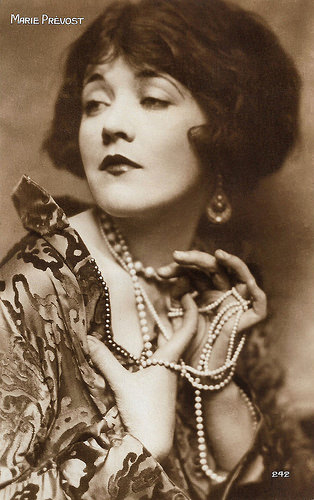
French postcard by Cinémagazine-Edition, no. 242.
A 'French' Bathing Beauty
Marie Prevost was born in 1897 in Sarnia, Ontario, Canada, as Mary Bickford Dunn. She was the daughter of Hughlina Marion (née Bickford) and Arthur 'Teddy' Dunn. Her father worked as a railroad conductor. When Mary was an infant, he was killed when gas seeped into the St. Clair Tunnel. Hughlina later married Frank Prevost. Her sister was the future actress Peggy Prevost. Both were still children when the family moved to the US. First, the family settled in Denver, Colorado, then in Los Angeles.
By 1915, Mary landed a job as a a stenographer at a law firm which represented the Keystone Film Company. While running an office errand at the Keystone Studios, Prevost was asked to appear in a bit part for the short film His Father's Footsteps (1915). Keystone's owner, Mack Sennett, also of Canadian origin, entrusted her with the role of an exotic 'French girl' and inserted her into his Bathing Beauties, with the stage name of Marie Prevost.
In 1919, Marie was secretly married to Sonny Gerke, a young man from high society, but the marriage failed after only six months, because Gerke did not have the courage to tell his mother that he had married an actress. Fearful of the bad publicity resulting from a divorce, Marie remained married until 1923, always keeping everyone unaware of her marriage.
At Keystone, Marie appeared in series of small roles as a young, innocent sexy girl. In 1919, Sennett cast Prevost in her first bigger role in Yankee Doodle in Berlin (Frank Richard Jones, 1919). The film was a hit and helped to solidify Prevost's career. Another successful film was Love, Honor, and Behave (Richard Jones, Erle Kenton, 1920), alongside another Sennett protege, George O'Hara.
In 1921, Marie signed a contract with Universal after getting the attention of Irving Thalberg. Thalberg decided to make her a star and organised a great advertising hype for her. He announced that Marie would star in two films, The Moonlight Follies (King Baggot, 1921) and Kissed (King Baggot, 1922), and sent her to Coney Island. There the actress publicly burned her bathing suit, signifying the end of her 'bathing' days.
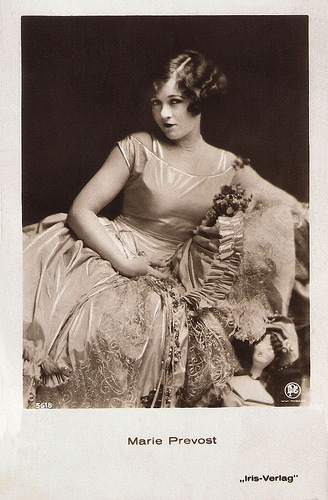
Austrian postcard by Iris-Verlag, no. 5618. Photo: PMC / Verleih Mondial.
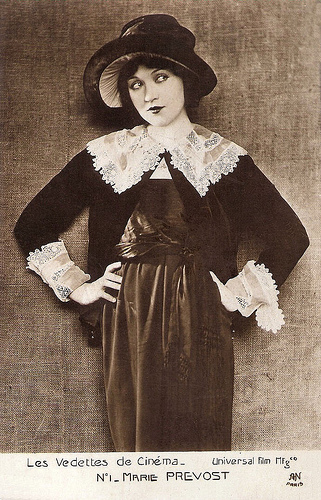
French postcard by A.N., Paris in the Les vedettes de cinéma, series, no. 1. Photo: Universal Film.
The Marriage Circle
At Universal, Marie Prevost only got light comedy roles. When the contract expired, Jack Warner had her signed for Warner Bros, recognising $ 1,500 a week. Alongside actor Kenneth Harlan as Tony, Marie played Gloria in The Beautiful and the Damned (Sidney Franklin, 1922), based on F. Scott Fitzgerald's bestseller on two idle spendthrifts who do not know how to cope with money running out.
To publicise the film, the production company announced that the actors would get married during filming on the set. The advertising launch worked and the studios were flooded with letters and gifts for the spouses. But when in the Los Angeles Mirror the story of Prevost's earlier secret marriage appeared: "Marie Prevost will become bigamist if she marries Harlan", Warner immediately took charge of the annulment of that marriage, so Harlan and Marie could marry.
Despite the bad publicity, The Beautiful and Damned was successful. By consequence, Ernst Lubitsch wanted Marie as the beautiful seductress for his film The Marriage Circle (1924), with Adolphe Menjou . Lubitsch said that Prevost was one of the few actresses in Hollywood who knew how to underplay comedy to achieve the maximum effect. He also cast her in Three Women (Ernst Lubitsch, 1924) with May McAvoy and Pauline Frederick, and Kiss Me Again (Ernst Lubitsch, 1925) with Monte Blue, and Clara Bow.
At Warner's in the mid-1920s, Prevost would star in comedies and dramas with Harrison Ford [the silent actor], Monte Blue, Matt Moore, Douglas Fairbanks jr. , and Harlan. In 1926, Warner decided not to prolong the contracts of Harlan and Marie Prevost.
Marie also lost her mother, who was travelling to Palm Beach, Florida, with actress Vera Steadman and producer Al Christie, when their car overturned. Hughina was crushed by the vehicle and died at the scene. Steadman and Christie both sustained serious injuries, but survived. Devastated by her mother's death and losing her work, Marie's marriage deteriorated, she began to drink and soon slipped into alcoholism.
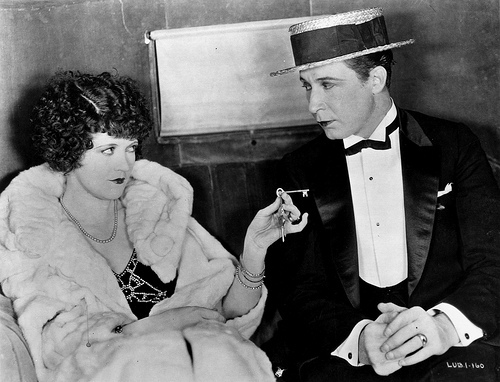
Photo of The Marriage Circle (Ernst Lubitsch, 1924) with Monte Blue. Collection: The Island of Cinema @ Flickr.
She was a winner/Who became her doggie's dinner
In 1927, Marie Prevost separated from her second husband, and despite a reconciliation in between, she divorced him altogether in 1929. To overcome the crisis, Prevost threw herself completely at work. After seeing her in The Beautiful and Damned, in 1928 Howard Hughes wanted her to star in The Racket. The two had a brief relationship but Hughes soon left her and Marie fell into a deepening depression. The Racket (Lewis Milestone, 1928) would be her last leading role in a feature film.
With the advent of sound her thick New England accent didn't lend itself well to the 'demon microphone'. Hal Erickson at AllMovie: "Talking pictures forced Prevost to alter her image; her nasal, high-pitched voice was more suited to wisecracking chorus girls or gum-chewing receptionists than pampered society wives."
In 1929, Cecil B. DeMille offered her a co-starring role in his final silent film The Godless Girl, starring Lina Basquette. Prevost received generally good reviews for her role in the film. In 1930, she appeared in Paid (Sam Wood, 1930), starring Joan Crawford. While Prevost's role was secondary, she still garnered good reviews.
At MGM, Prevost played Academy Award winner Helen Hayes' loyal friend in The Sin of Madelon Claudet (Edgar Selwyn, 1931), and was one of the three leads in the film Three Wise Girls (William Beaudine, 1932), with Jean Harlow. She began to gain weight and could no longer control either food or alcohol.
By 1934, Marie had no work at all and her financial situation deteriorated dramatically. She did a last good supporting part as Carole Lombard's manicurist chum in Hands Across the Table (1936). Her final film appearance was a bit part as a waitress in the action-drama Ten Laps to Go (Elmer Clifton, 1936-1938). To find work again, she faced drastic diets that further weakened her. In 1937, Marie Prevost died of a heart attack due to malnutrition and acute alcoholism. She was only 38.
Her body was found only two days later, due to the continuous and insistent barking of her dachshund dog. A bellhop came into the house and found her lying face down on the bed. Prevost's death was featured in Hollywood Babylon by Kenneth Anger. In the book, Anger falsely claimed Prevost's dachshund consumed her remains to survive. Musician Nick Lowe used details of her life and Anger's account of her death for his song Marie Prevost (1978) including the lyric in the chorus "She was a winner/Who became her doggie's dinner". According to IMDb however, Prevost only had some scratches on her hand where her dog had been pulling at her, probably to try to get her attention.
The funeral at the Memorial Cemetery in Hollywood was paid by Joan Crawford: in addition to Crawford, Clark Gable, Wallace Beery and Barbara Stanwyck participated. Her poor case prompted the Hollywood community to create in the early 1940s the Motion Picture & Television Country House and Hospital to provide medical care for employees of the television and motion picture industry.
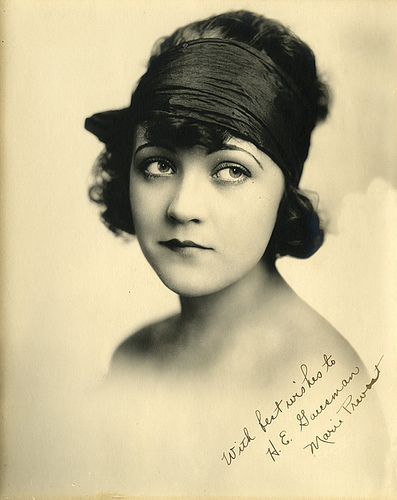
Collection: Grudnick @ Flickr.
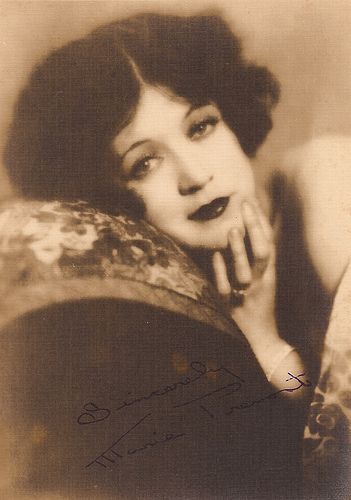
Collection: Charissa @ Flickr.
Sources: Hal Erickson (AllMovie), (IMDb), Wikipedia (Italian and English) and .

French postcard by Cinémagazine-Edition, no. 242.
A 'French' Bathing Beauty
Marie Prevost was born in 1897 in Sarnia, Ontario, Canada, as Mary Bickford Dunn. She was the daughter of Hughlina Marion (née Bickford) and Arthur 'Teddy' Dunn. Her father worked as a railroad conductor. When Mary was an infant, he was killed when gas seeped into the St. Clair Tunnel. Hughlina later married Frank Prevost. Her sister was the future actress Peggy Prevost. Both were still children when the family moved to the US. First, the family settled in Denver, Colorado, then in Los Angeles.
By 1915, Mary landed a job as a a stenographer at a law firm which represented the Keystone Film Company. While running an office errand at the Keystone Studios, Prevost was asked to appear in a bit part for the short film His Father's Footsteps (1915). Keystone's owner, Mack Sennett, also of Canadian origin, entrusted her with the role of an exotic 'French girl' and inserted her into his Bathing Beauties, with the stage name of Marie Prevost.
In 1919, Marie was secretly married to Sonny Gerke, a young man from high society, but the marriage failed after only six months, because Gerke did not have the courage to tell his mother that he had married an actress. Fearful of the bad publicity resulting from a divorce, Marie remained married until 1923, always keeping everyone unaware of her marriage.
At Keystone, Marie appeared in series of small roles as a young, innocent sexy girl. In 1919, Sennett cast Prevost in her first bigger role in Yankee Doodle in Berlin (Frank Richard Jones, 1919). The film was a hit and helped to solidify Prevost's career. Another successful film was Love, Honor, and Behave (Richard Jones, Erle Kenton, 1920), alongside another Sennett protege, George O'Hara.
In 1921, Marie signed a contract with Universal after getting the attention of Irving Thalberg. Thalberg decided to make her a star and organised a great advertising hype for her. He announced that Marie would star in two films, The Moonlight Follies (King Baggot, 1921) and Kissed (King Baggot, 1922), and sent her to Coney Island. There the actress publicly burned her bathing suit, signifying the end of her 'bathing' days.

Austrian postcard by Iris-Verlag, no. 5618. Photo: PMC / Verleih Mondial.

French postcard by A.N., Paris in the Les vedettes de cinéma, series, no. 1. Photo: Universal Film.
The Marriage Circle
At Universal, Marie Prevost only got light comedy roles. When the contract expired, Jack Warner had her signed for Warner Bros, recognising $ 1,500 a week. Alongside actor Kenneth Harlan as Tony, Marie played Gloria in The Beautiful and the Damned (Sidney Franklin, 1922), based on F. Scott Fitzgerald's bestseller on two idle spendthrifts who do not know how to cope with money running out.
To publicise the film, the production company announced that the actors would get married during filming on the set. The advertising launch worked and the studios were flooded with letters and gifts for the spouses. But when in the Los Angeles Mirror the story of Prevost's earlier secret marriage appeared: "Marie Prevost will become bigamist if she marries Harlan", Warner immediately took charge of the annulment of that marriage, so Harlan and Marie could marry.
Despite the bad publicity, The Beautiful and Damned was successful. By consequence, Ernst Lubitsch wanted Marie as the beautiful seductress for his film The Marriage Circle (1924), with Adolphe Menjou . Lubitsch said that Prevost was one of the few actresses in Hollywood who knew how to underplay comedy to achieve the maximum effect. He also cast her in Three Women (Ernst Lubitsch, 1924) with May McAvoy and Pauline Frederick, and Kiss Me Again (Ernst Lubitsch, 1925) with Monte Blue, and Clara Bow.
At Warner's in the mid-1920s, Prevost would star in comedies and dramas with Harrison Ford [the silent actor], Monte Blue, Matt Moore, Douglas Fairbanks jr. , and Harlan. In 1926, Warner decided not to prolong the contracts of Harlan and Marie Prevost.
Marie also lost her mother, who was travelling to Palm Beach, Florida, with actress Vera Steadman and producer Al Christie, when their car overturned. Hughina was crushed by the vehicle and died at the scene. Steadman and Christie both sustained serious injuries, but survived. Devastated by her mother's death and losing her work, Marie's marriage deteriorated, she began to drink and soon slipped into alcoholism.

Photo of The Marriage Circle (Ernst Lubitsch, 1924) with Monte Blue. Collection: The Island of Cinema @ Flickr.
She was a winner/Who became her doggie's dinner
In 1927, Marie Prevost separated from her second husband, and despite a reconciliation in between, she divorced him altogether in 1929. To overcome the crisis, Prevost threw herself completely at work. After seeing her in The Beautiful and Damned, in 1928 Howard Hughes wanted her to star in The Racket. The two had a brief relationship but Hughes soon left her and Marie fell into a deepening depression. The Racket (Lewis Milestone, 1928) would be her last leading role in a feature film.
With the advent of sound her thick New England accent didn't lend itself well to the 'demon microphone'. Hal Erickson at AllMovie: "Talking pictures forced Prevost to alter her image; her nasal, high-pitched voice was more suited to wisecracking chorus girls or gum-chewing receptionists than pampered society wives."
In 1929, Cecil B. DeMille offered her a co-starring role in his final silent film The Godless Girl, starring Lina Basquette. Prevost received generally good reviews for her role in the film. In 1930, she appeared in Paid (Sam Wood, 1930), starring Joan Crawford. While Prevost's role was secondary, she still garnered good reviews.
At MGM, Prevost played Academy Award winner Helen Hayes' loyal friend in The Sin of Madelon Claudet (Edgar Selwyn, 1931), and was one of the three leads in the film Three Wise Girls (William Beaudine, 1932), with Jean Harlow. She began to gain weight and could no longer control either food or alcohol.
By 1934, Marie had no work at all and her financial situation deteriorated dramatically. She did a last good supporting part as Carole Lombard's manicurist chum in Hands Across the Table (1936). Her final film appearance was a bit part as a waitress in the action-drama Ten Laps to Go (Elmer Clifton, 1936-1938). To find work again, she faced drastic diets that further weakened her. In 1937, Marie Prevost died of a heart attack due to malnutrition and acute alcoholism. She was only 38.
Her body was found only two days later, due to the continuous and insistent barking of her dachshund dog. A bellhop came into the house and found her lying face down on the bed. Prevost's death was featured in Hollywood Babylon by Kenneth Anger. In the book, Anger falsely claimed Prevost's dachshund consumed her remains to survive. Musician Nick Lowe used details of her life and Anger's account of her death for his song Marie Prevost (1978) including the lyric in the chorus "She was a winner/Who became her doggie's dinner". According to IMDb however, Prevost only had some scratches on her hand where her dog had been pulling at her, probably to try to get her attention.
The funeral at the Memorial Cemetery in Hollywood was paid by Joan Crawford: in addition to Crawford, Clark Gable, Wallace Beery and Barbara Stanwyck participated. Her poor case prompted the Hollywood community to create in the early 1940s the Motion Picture & Television Country House and Hospital to provide medical care for employees of the television and motion picture industry.

Collection: Grudnick @ Flickr.

Collection: Charissa @ Flickr.
Sources: Hal Erickson (AllMovie), (IMDb), Wikipedia (Italian and English) and .
Published on November 24, 2018 22:00
November 23, 2018
Photo by RKO
RKO Pictures was, in its original incarnation as RKO Radio Pictures Inc., one of the Big Five studios of Hollywood's Golden Age. It was the last of the major studios to be created and the first (and only) studio to expire. Much of its 25 years’ existence, Radio-Keith-Orpheum spent struggling for financial stability, but despite this it produced many classic films including King Kong (1933), Bringing Up Baby (1938), Citizen Kane (1941), and The Best Years of Our Lives (1946). RKO has long been renowned for its cycle of musicals starring Fred Astaire and Ginger Rogers in the mid- to late 1930s. Actors Katharine Hepburn and, later, Robert Mitchum had their first major successes at the studio. Cary Grant was a mainstay for years. The work of producer Val Lewton's low-budget horror unit and RKO's many ventures into Film Noir have been acclaimed by film critics and historians. RKO was also responsible for such co-productions as It's a Wonderful Life and Notorious, and from 1937 to the mid-50s, it distributed many celebrated films by Walt Disney. In 1948, monomaniacal Howard Hughes took over RKO, and after years of chaos and decline under his control, he sold off the studio's assets—both its films and its production facilities—to the burgeoning television industry. The original RKO Pictures ceased production in 1957 and was dissolved two years later.

Bebe Daniels and John Boles. German postcard by Ross Verlag, no. 4812/1, 1929-1930. Photo: Radio Pictures (RKO). Publicity still for Rio Rita (Luther Reed, 1929).
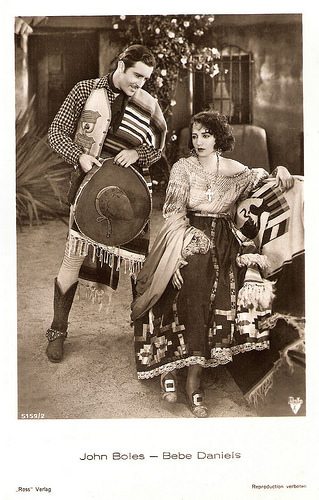
Bebe Daniels and John Boles. German postcard by Ross Verlag, no. 51592, 1930-1931. Photo: Radio Pictures (RKO). Publicity still for Rio Rita (Luther Reed, 1929).
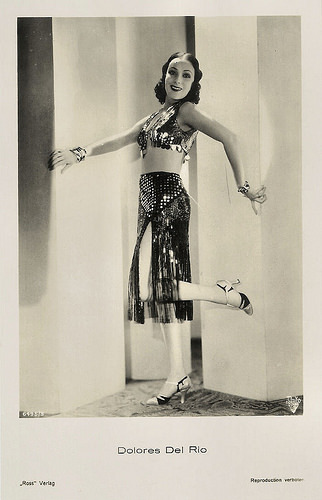
Dolores del Rio . German postcard by Ross Verlag, no. 6495/3, 1931-1932. Photo: Radio Pictures (RKO).

Bert Wheeler and Robert Woolsey. British postcard in the Filmshots series by Film Weekly. Photo: Radio. Publicity still for So This Is Africa (Edward F. Cline, 1933).
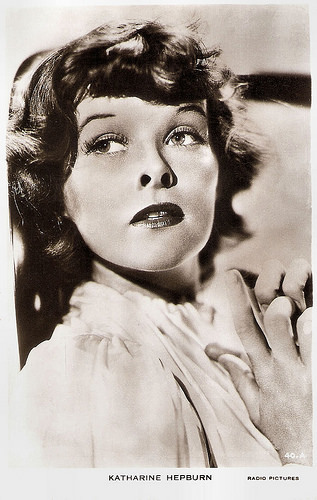
Katharine Hepburn. British Real Photograph postcard, no. 40.A. Photo: Radio Pictures.
The masterful tenure of David O'Selznick
In 1928, RKO Radio Pictures Inc. was formed after the Keith-Albee-Orpheum (KAO) theatre chain and Joseph P. Kennedy's Film Booking Offices of America (FBO) studio were brought together under the control of the Radio Corporation of America (RCA). RCA chief David Sarnoff engineered the merger to create a market for the company's sound-on-film technology, RCA Photophone.
RKO (also written as R.K.O.) began production at the small facility FBO shared with Pathé in New York City while the main FBO studio in Hollywood was technologically refitted. The new company's two initial releases were musicals: Syncopation (Bert Glennon, 1929), which had been produced by FBO, and Street Girl (Wesley Ruggles, 1930), billed as RKO's first ‘official’ production and its first to be shot in Hollywood.
A few non-singing pictures followed, but the studio's first major hit was again a musical. RKO spent heavily on the lavish Rio Rita (Luther Reed, 1930), starring Bebe Daniels and the comedy team of Wheeler & Woolsey and including a number of Technicolor sequences. Opening in September to rave reviews, it was named one of the ten best pictures of the year by Film Daily.
RKO released a limited slate of twelve features in its first year; in 1930, that figure more than doubled to twenty-nine. Encouraged by Rio Rita's success, RKO produced several costly musicals incorporating Technicolor sequences, among them Dixiana (1930) with Bebe Daniels , and Hit the Deck (1930) with Jack Oakie, both again scripted and directed by Luther Reed.
Following the example of the other major studios, RKO had planned to create its own musical revue, Radio Revels. Promoted as the studio's most extravagant production to date, it was to be photographed entirely in Technicolor. The project was abandoned, however, as the public's taste for musicals temporarily subsided. From a total of more than sixty Hollywood musicals in 1929 and over eighty the following year, the number dropped to eleven in 1931.
Even as the U.S. economy foundered, RKO had gone on a spending spree, buying up theatre after theatre to add to its exhibition chain. In October 1930, the company purchased a 50 percent stake in the New York Van Beuren studio, which specialised in cartoons and live shorts. RKO's production schedule soon surpassed forty features a year, released under the names Radio Pictures and, for a short time after the 1931 merger, RKO Pathé. The Western Cimarron (Wesley Ruggles,1931), based on the novel by Edna Ferber and starring Richard Dix, would become the only RKO production to win the Academy Award for Best Picture. Nonetheless, having cost a profligate $1.4 million to make, it was a money-loser on original domestic release.
The most popular RKO star of this pre-Code era was Irene Dunne, who made her debut as the lead in the musical Leathernecking (Edward F. Cline, 1930) and was a headliner at the studio for the entire decade. Other major performers included Joel McCrea, Ricardo Cortez, Dolores del Rio , and Mary Astor. Richard Dix, Oscar-nominated for his lead performance in Cimarron, would serve as RKO's standby B-movie star until the early 1940s.The comedy team of Bert Wheeler and Robert Woolsey, often wrangling over ingenue Dorothy Lee, was a bankable mainstay for years.
RKO's product was largely regarded as mediocre, so in October 1931 the studio hired twenty-nine-year-old David O. Selznick as production chief. In addition to implementing rigorous cost-control measures, Selznick championed the unit production system, which gave the producers of individual films much greater independence than they had under the prevailing central producer system. Wikipedia cites Selznick: "Under the factory system of production you rob the director of his individualism and this being a creative industry that is harmful to the quality of the product made."
To make films under the new system, Selznick recruited prize behind-the-camera personnel, such as director George Cukor and producer/director Merian C. Cooper, and gave 26-years-old producer Pandro S. Berman increasingly important projects. Selznick discovered and signed a young actress who would quickly become one of the studio's biggest stars, Katharine Hepburn. John Barrymore was also enlisted for a few memorable performances.
From September 1932 on, print advertising for the company's features displayed the revised name RKO Radio Pictures. Selznick spent a mere fifteen months as RKO production chief, resigning over a dispute with new corporate president Merlin Aylesworth concerning creative control. One of his last acts at RKO was to approve a screen test for a thirty-three-year-old, balding Broadway song-and-dance man named Fred Astaire.
Selznick's tenure was masterful: In 1931, before he arrived, the studio had produced forty-two features for $16 million in total budgets. In 1932, under Selznick, forty-one features were made for $10.2 million, with clear improvement in quality and popularity. He backed several major successes, including A Bill of Divorcement (George Cukor, 1932), Katharine Hepburn's debut, and the monumental monster adventure King Kong (Merian C. Cooper, Ernest B. Schoedsack, 1933).
Still, the shaky finances and excesses that marked the company's pre-Selznick days had not left RKO in shape to withstand the Depression. The studio sank into receivership in early 1933, from which it did not emerge until 1940. Cooper took over as production head after Selznick's departure and oversaw two hits starring Hepburn: Morning Glory (Lowell Sherman, 1933), for which she won her first Oscar, and Little Women (George Cukor, 1933), one of the studio’s biggest box-office successes of the decade.
Ginger Rogers had already made several minor films for RKO when Cooper signed her to a seven-year contract and cast her in the big-budget musical Flying Down to Rio (Thornton Freeland, 1933). Rogers was paired with Astaire, making his film debut. Billed fourth and fifth respectively, the picture turned them into stars. Hermes Pan, assistant to the film's dance director, would become one of Hollywood's leading choreographers through his subsequent work with Astaire.
Along with Columbia Pictures, RKO became one of the primary homes of the screwball comedy. William A. Seiter directed the studio's first significant contribution to the genre, The Richest Girl in the World (1934). The drama Of Human Bondage (John Cromwell, 1934), was Bette Davis's first great success. George Stevens's Alice Adams (1935) and John Ford's The Informer (1935) were each nominated for the 1935 Best Picture Oscar—the Best Director statuette won by Ford was the only one ever given for an RKO production. The Informer's star, Victor McLaglen , also took home an Academy Award; he would appear in a dozen films for the studio over a span of two decades.
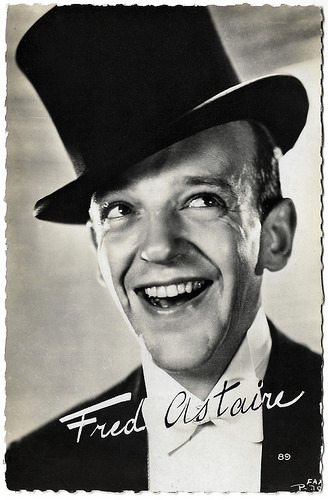
Fred Astaire. French postcard by Editions et Publications Cinematographiques, no. 89.
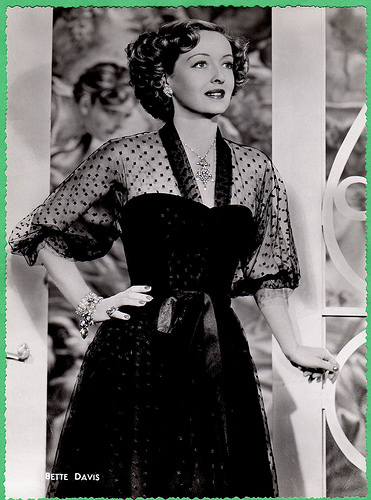
Bette Davis. Belgian collectors card by Chocolaterie Clovis, Pepinster. Collection: Amit Benyovits.

Victor McLaglen . French postcard by Ed. Chantal, Paris, no. 602. Photo: RKO.
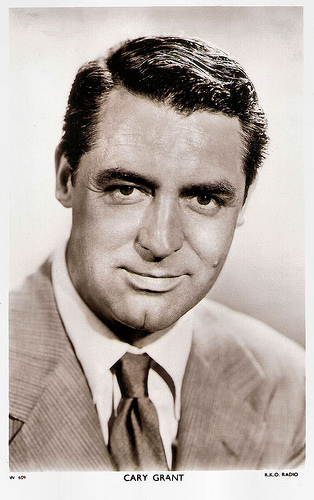
Cary Grant. British postcard in the Picturegoer Series, London, no. W 609. Photo: R.K.O. Radio.
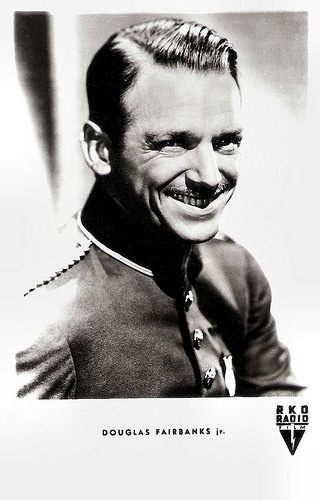
Douglas Fairbanks Jr. German postcard by Netter's Star Verlag, Berlin. Photo: RKO Radio Film. Publicity still for Gunga Din (George Stevens, 1939).
The brief but notable tenure of production chief Sandro Berman
Lacking the financial resources of industry leaders MGM, Paramount, and Fox, RKO turned out many pictures during the era that made up for it with high style in an Art Deco mode, exemplified by such Astaire–Rogers musicals as The Gay Divorcee (Mark Sandrich, 1934), their first pairing as leads, and Top Hat (Mark Sandrich, 1935). One of the figures most responsible for that style was another Selznick recruit: Van Nest Polglase, chief of RKO's highly regarded design department for almost a decade.
In, 1935, RKO premiered the first feature film shot entirely in advanced three-strip Technicolor, Becky Sharp (Rouben Mamoulian, 1935). Though judged by critics a failure as drama, Becky Sharp was widely lauded for its visual brilliance and technical expertise. In 1935, Cary Grant joined the studio's roster. Grant was a trendsetter, one of the first leading men of the sound era to work extensively as a freelancer, under nonexclusive studio deals, while his star was still on the rise. Ann Sothern starred in seven RKO films between 1935 and 1937, paired five times with Gene Raymond.
Walt Disney’s Snow White and the Seven Dwarfs (1937) was the highest grossing production in the period between The Birth of a Nation (David Wark Griffith, 1915) and Gone with the Wind (Victor Fleming, 1939). While the Disney association was beneficial, RKO's own product was widely seen as declining in quality. Then, Pandro Berman accepted the position of production chief on a noninterim basis. His brief tenure resulted in some of the most notable films in studio history, including the adventure film Gunga Din (George Stevens, 1939), with Cary Grant and Victor McLaglen ; Love Affair (Leo McCarey, 1939), starring Irene Dunne and Charles Boyer ; and The Hunchback of Notre Dame (William Dieterle, 1939). Charles Laughton, who played Quasimodo in the latter, returned periodically to the studio, headlining six more RKO features. For Maureen O'Hara , who made her American screen debut in the film, it was the first of ten pictures she would make for RKO through 1952.
After co-starring with Ginger Rogers for the eighth time in The Story of Vernon and Irene Castle (H.C. Potter, 1939), Fred Astaire departed the studio. The Wheeler and Woolsey comedy series ended in 1937 when Woolsey became ill and died the following year. B-Western star George O'Brien made eighteen RKO pictures, sixteen between 1938 and 1940. With The Saint in New York (Ben Holmes, 1938), RKO successfully launched a B-detective series featuring the character Simon Templar that would run through 1943. The studio soon had another new B-comedy star in Lupe Vélez: The Girl from Mexico (Leslie Goodwins, 1939) was followed by seven frantic instalments of the Mexican Spitfire series, all featuring Leon Errol, between 1940 and 1943.
Berman departed RKO in December 1939 after policy clashes with studio president George J. Schaefer. Schaefer was keen on signing up independent producers whose films RKO would distribute. In 1941, the studio landed one of the most prestigious independents in Hollywood, Samuel Goldwyn's productions. The first two Goldwyn pictures released by the studio were highly successful: The Little Foxes (William Wyler, 1941) starring Bette Davis, garnered four Oscar nominations, while Ball of Fire (Howard Hawks, 1941) brought Barbara Stanwyck a hit under the RKO banner.
David O. Selznick loaned out his leading contracted director for two RKO pictures in 1941: Alfred Hitchcock's comedy Mr. and Mrs. Smith (1941) with Carole Lombard, was a modest success and the thriller Suspicion (1941) with Joan Fontaine and Cary Grant, a more substantial one, with an Oscar-winning turn by Joan Fontaine.
That May, having granted twenty-five-year-old star and director Orson Welles virtually complete creative control over the film, RKO released Citizen Kane (1941). While it opened to strong reviews and would go on to be hailed as one of the greatest movies ever made, it lost money at the time and brought down the wrath of the Hearst newspaper chain on RKO. The next year saw the commercial failure of Welles's The Magnificent Ambersons (Orson Welles, 1942)and the expensive embarrassment of his aborted documentary It's All True. The three Welles productions combined to drain $2 million from the RKO coffers, major money for a corporation that had reported an overall deficit of $1 million in 1940 and a nominal profit of a bit more than $500,000 in 1941.
Many of RKO's other artistically ambitious pictures were also dying at the box office and it was losing its last exclusive deal with a major star as well. Ginger Rogers, after winning an Oscar in 1941 for her performance in the previous year's Kitty Foyle (Sam Wood, 1940), held out for a freelance contract like Grant's. Schaefer resigned and departed a weakened and troubled studio, but RKO was about to turn the corner. Propelled by the box-office boom of World War II and guided by new management, RKO would make a strong comeback over the next half-decade.
With Schaefer gone, Charles Koerner did the job and brought the studio much-needed stability until his death in February 1946. In June 1944, RKO created a television production subsidiary, RKO Television Corporation, to provide content for the new medium. RKO became the first major studio to produce for television with Talk Fast, Mister, a one-hour drama filmed at RKO-Pathé studios in New York and broadcast by the DuMont network's New York station, WABD, on 18 December 1944. Koerner sought to increase its output of handsomely budgeted, star-driven features. However, the studio's only remaining major stars were Cary Grant, whose services were shared with Columbia Pictures, and Maureen O'Hara , shared with Twentieth Century-Fox.
So RKO arranged with the other studios to loan out their biggest names or signed one of the growing number of freelance performers to short-term, ‘pay or play’ deals. John Wayne appeared in the comedy A Lady Takes a Chance (William A. Seiter, 1943) while on loan from Republic Pictures. He was soon working regularly with RKO, making nine more films for the studio. Gary Cooper appeared in RKO releases produced by Goldwyn and, later, the start-up International Pictures, and Claudette Colbert starred in a number of RKO co-productions.
Ingrid Bergman , on loan out from Selznick, starred opposite Bing Crosby in The Bells of St. Mary's (Leo McCarey,1945). The top box-office film of the year, it turned a $3.7 million profit for RKO, the most in the company's history. Bergman returned in the co-productions Notorious (Alfred Hitchcock, 1946) and Stromboli (Roberto Rossellini, 1950), and in the independently produced Joan of Arc (Victor Fleming, 1948).
RKO and Orson Welles had an arm's-length reunion via The Stranger (Orson Welles, 1946), an independent production he starred in as well as directed. In December 1946, the studio released Frank Capra's It's a Wonderful Life (1946). While it would ultimately be recognised as one of the greatest films of Hollywood's Golden Age, at the time it lost more than half a million dollars for RKO. John Ford's The Fugitive (1947) and Fort Apache (1948), which appeared right before studio ownership changed hands again, were followed by She Wore a Yellow Ribbon (1949) and Wagon Master (1950); all four were co-productions between RKO and Argosy, the company run by Ford and RKO alumnus Merian C. Cooper.
Of the directors under long-term contract to RKO in the 1940s, the best known was Edward Dmytryk, who first came to notice with the remarkably profitable Hitler's Children (1943). Shot on a $205,000 budget, placing it in the bottom quartile of Big Five studio productions, it was one of the ten biggest Hollywood hits of the year. Another low-cost war-themed film directed by Dmytryk, Behind the Rising Sun (1943), released a few months later, was similarly profitable.
Much more than the other Big Five studios, RKO relied on B pictures to fill up its schedule. RKO had a history of making better profits with its run-of-the-mill and low-cost product than with its A movies. The studio's low-budget films offered training opportunities for new directors, as well, among them Mark Robson, Robert Wise, and Anthony Mann.
Robson and Wise received their first directing assignments with producer Val Lewton, whose specialised B-horror unit also included the more experienced director Jacques Tourneur. The Lewton unit's moody, atmospheric work — represented by films such as Cat People (Jacques Tourneur, 1942) with Simone Simon , I Walked with a Zombie (Jacques Tourneur, 1943), and The Body Snatcher (Robert Wise, 1945) — is now highly regarded. Johnny Weissmuller starred in six Tarzan pictures for RKO between 1943 and 1948 before being replaced by Lex Barker .
Film noir, to which lower budgets lent themselves, became something of a house style at the studio, indeed, the RKO B-Film Noir Stranger on the Third Floor (Boris Ingster, 1940) with Peter Lorre , is widely seen as initiating Noir's classic period. The studio's 1940s list of contract players was filled with Noir regulars: Robert Mitchum (who graduated to major star status) and Robert Ryan each made no fewer than ten film noirs for RKO. Gloria Grahame, Jane Greer, and Lawrence Tierney were also notable studio players in the field. Freelancer George Raft starred in two Noir hits: Johnny Angel (Edwin L. Marin, 1945) and Nocturne (1946). Tourneur, Mitchum, and Greer joined to make the A-budgeted Out of the Past (Edwin L. Marin, 1947), now considered one of the greatest of all Film Noirs. Nicholas Ray began his directing career with the Noir They Live by Night (1948), the first of a number of well-received films he made for RKO.
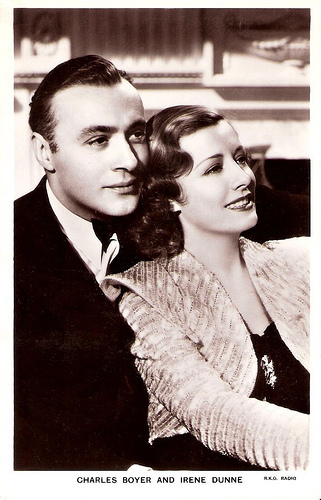
Charles Boyer and Irene Dunne. British postcard in the Film Partners Series, London, no. P 268. Photo: R.K.O. Radio. Publicity photo for Love Affair (1939, Leo McCarey).
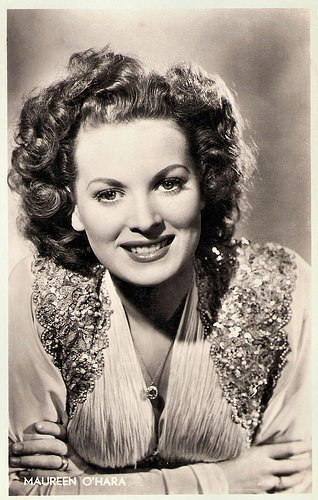
Maureen O'Hara . Dutch postcard by J.S.A. Photo: M.P.E.
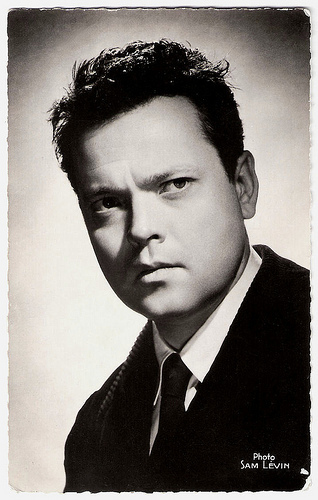
Orson Welles . French postcard by Editions du Globe, no. 143. Photo: Sam Lévin.
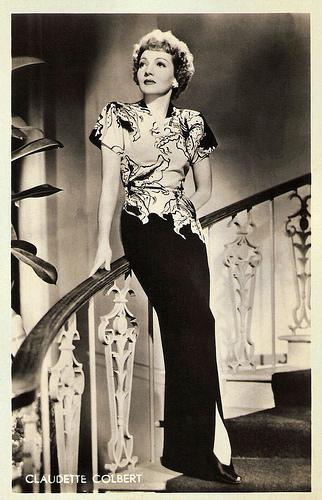
Claudette Colbert. Dutch postcard by S. & v. H., A. Photo: M.P.E.A.
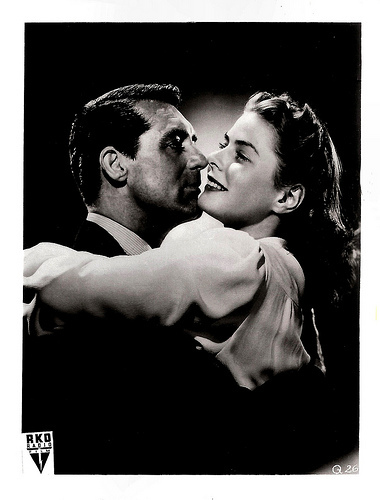
Cary Grant and Ingrid Bergman . German collectors card. Photo: RKO Radio Film. Publicity still for Notorious (Alfred Hitchcock, 1946).
The capricious and fatal management style of Howard Hughes
RKO, and Hollywood as a whole, had its most profitable year ever in 1946. A Goldwyn production released by RKO, The Best Years of Our Lives (William Wyler, 1946), was the most successful Hollywood film of the decade. But the legal status of the industry's reigning business model was increasingly being called into doubt: the U.S. Supreme Court ruled in Bigelow v. RKO that the company was liable for damages under antitrust statutes for having denied an independent movie house access to first run films—a common practice among all of the Big Five.
After Koerner's death, producer and Oscar-winning screenwriter Dore Schary took over his role. RKO appeared in good shape to build on its recent successes, but the year brought a number of unpleasant harbingers for all of Hollywood. The post-war attendance boom peaked sooner than expected and television emerged as a competitor for audience interest. Across the board, profits fell — a 27 percent drop for the Hollywood studios from 1946 to 1947.
The phenomenon that would become known as McCarthyism was building strength, and in October, the House Un-American Activities Committee (HUAC) began hearings into Communism in the motion picture industry. Two of RKO's top talents, director Edward Dmytryk and producer Adrian Scott, refused to cooperate. As a consequence, they were fired by RKO per the terms of the Waldorf Statement, the major studios' pledge to "eliminate any subversives". Scott, Dmytryk, and eight others who also defied HUAC — dubbed the Hollywood Ten — were blacklisted across the industry. Ironically, the studio's major success of the year was Crossfire (Edward Dmytryk, 1947), a Scott–Dmytryk film.
For her performance in The Farmer's Daughter (H.C. Potter, 1947), a coproduction with Selznick's Vanguard Films, Loretta Young won the Best Actress Oscar the following March. It would turn out to be the last major Academy Award for an RKO picture. In May 1948, eccentric aviation tycoon and occasional movie producer Howard Hughes gained control of the company. During Hughes's tenure, RKO suffered its worst years since the early 1930s, as his capricious management style took a heavy toll. Production chief Schary quit almost immediately due to his new boss's interference and within weeks of taking over, Hughes had dismissed three-fourths of the work force. Production was virtually shut down for six months as the conservative Hughes shelved or cancelled several of the ‘message pictures’ that Schary had backed.
Once shooting picked up again, Hughes quickly became notorious for meddling in minute production matters, particularly the presentation of actresses he favoured. The production-distribution end of the RKO business, now deep in the red, would never make a profit again. Offscreen, Robert Mitchum 's arrest and conviction for marijuana possession — he would serve two months in jail — was widely assumed to mean career death for RKO's most promising young star, but Hughes surprised the industry by announcing that his contract was not endangered.
Of much broader significance, Hughes decided to get the jump on his Big Five competitors by being the first to settle the federal government's antitrust suit against the major studios, which had won a crucial Supreme Court ruling in United States v. Paramount Pictures, Inc. Under the consent decree he signed, Hughes agreed to dissolve the old parent company, Radio-Keith-Orpheum Corp., and split RKO's production-distribution business and its exhibition chain into two entirely separate corporations — RKO Pictures Corp. and RKO Theatres Corp. — with the obligation to promptly sell off one or the other. While Hughes delayed the divorcement procedure until December 1950 and didn't actually sell his stock in the theatre company for another three years, his decision to acquiesce was one of the crucial steps in the collapse of classical Hollywood's studio system.
While Hughes's time at RKO was marked by dwindling production and a slew of expensive flops, the studio continued to turn out some well-received films under production chiefs Sid Rogell and Sam Bischoff, though both became fed up with Hughes's meddling and quit after less than two years. There were B Noirs such as The Window (Ted Tetzlaff, 1949), which turned into a hit, and The Set-Up (Robert Wise, 1949), starring Robert Ryan, which won the Critic's Prize at the Cannes Film Festival. The Thing from Another World (Christian Nyby, Howard Hawks, 1951), a science-fiction drama coproduced with Howard Hawks's Winchester Pictures, is a classic of the genre.
In 1952, RKO put out two films directed by Fritz Lang, Rancho Notorious and Clash by Night. The company also began a close working relationship with Ida Lupino. She starred in two suspense films with Robert Ryan — Nicholas Ray's On Dangerous Ground (1952) and Beware, My Lovely (Harry Horner, 1952), a coproduction between RKO and Ida Lupino's company, The Filmakers. Lupino was Hollywood's only female director during the period; of the five pictures The Filmakers made with RKO, Lupino directed three, including her now celebrated The Hitch-Hiker (Ida Lupino, 1953).
Exposing many filmgoers to Asian cinema for the first time, RKO distributed Akira Kurosawa's epochal Rashomon (1950) in the United States. The only smash hits released by RKO in the 1950s came out during this period, but neither was an in-house production: Goldwyn's Hans Christian Andersen (Charles Vidor, 1952) with Danny Kaye, was followed by Walt Disney's Peter Pan (Clyde Geronimi a.o., 1953). Convinced that the studio was sinking, Walt Disney ended his arrangement with RKO and set up his own distribution firm, Buena Vista Pictures. Howard Hughes had to leave and the new owners of RKO became General Tire.
By 1956, RKO's classic films were playing widely on television, allowing many to see such masterpieces as Citizen Kane (Orson Welles, 1941) for the first time. The $15.2 million RKO made on the deal convinced the other major studios that their libraries held profit potential — a turning point in the way Hollywood did business with television. The new owners of RKO, General Tire, made an initial effort to revive the studio, hiring veteran producer William Dozier to head production. In the first half of 1956, the production facilities were as busy as they had been in a half-decade. RKO Teleradio Pictures released Fritz Lang's final two American films, While the City Sleeps (1956) and Beyond a Reasonable Doubt (1956), but years of mismanagement had driven away many directors, producers, and stars.
The studio was also saddled with the last of the inflated B-movies such as Pearl of the South Pacific (Allan Dwan, 1955) and The Conqueror (Dick Powell, 1956) that enchanted Hughes. The latter, starring John Wayne, was the biggest hit produced at the studio during the decade, but its $4.5 million in North American rentals did not come close to covering its $6 million cost. After a year and a half without a notable success, General Tire shut down production at RKO for good at the end of January 1957. The Hollywood facilities were sold later that year for $6.15 million to Desilu Productions, owned by Desi Arnaz and Lucille Ball.
After numerous corporate reorganisations, the firm continued under the name RKO General, Inc., owning and operating radio and television stations, theatres, and related enterprises. Most of the films released by RKO Pictures between 1929 and 1957 have an opening ident displaying the studio's famous trademark, the spinning globe and radio tower, nicknamed the 'Transmitter'. It was inspired by a two-hundred-foot tower built in Colorado for a giant electrical amplifier, or Tesla coil, created by inventor Nikola Tesla. The studio's closing ident, a triangle enclosing a thunderbolt, was also a well-known trademark.
Finally, we cite Wikipedia in turn citing scholar Richard B. Jewell: "The supreme irony of RKO's existence is that the studio earned a position of lasting importance in cinema history largely because of its extraordinarily unstable history. Since it was the weakling of Hollywood's 'majors,' RKO welcomed a diverse group of individualistic creators and provided them...with an extraordinary degree of freedom to express their artistic idiosyncrasies.... [I]t never became predictable and it never became a factory.”
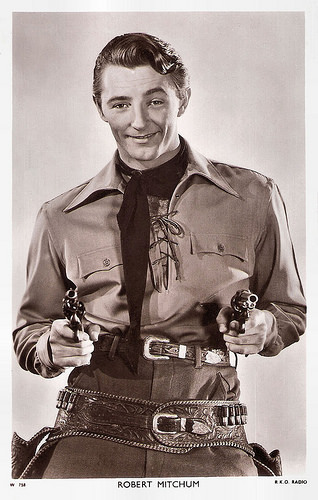
Robert Mitchum . British postcard in the Picturegoer Series, London, no. W 758. Photo: R.K.O. Radio.

Lex Barker . German postcard by Rüdel-Verlag, Hamburg-Bergedorf, no. 449. Photo: Alex Kahle / RKO Radio Film. Publicity still for Tarzan's Magic Fountain (Lee Sholem, 1949).
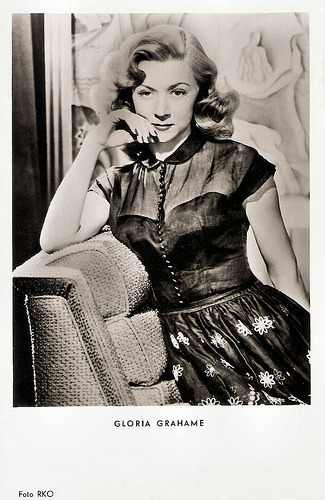
Gloria Grahame. German postcard by Kunst und Bild, Berlin, no. A 791. Photo: RKO. Publicity still for Sudden Fear (David Miller, 1952).
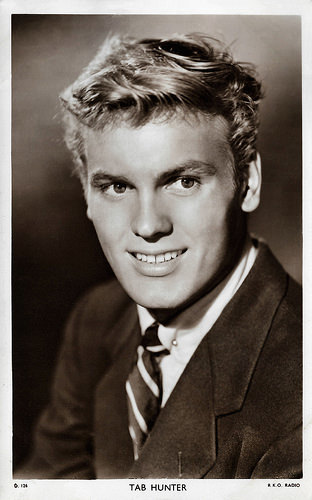
Tab Hunter . British postcard in the Picturegoer series, London, no. D 126. Photo: R.K.O. Radio.

Guy Madison . British postcard in the Picturegoer Series, London, no. W 815. Photo: R.K.O. Radio.
Sources: Encyclopaedia Britannica, Film Reference, Wikipedia and IMDb.

Bebe Daniels and John Boles. German postcard by Ross Verlag, no. 4812/1, 1929-1930. Photo: Radio Pictures (RKO). Publicity still for Rio Rita (Luther Reed, 1929).

Bebe Daniels and John Boles. German postcard by Ross Verlag, no. 51592, 1930-1931. Photo: Radio Pictures (RKO). Publicity still for Rio Rita (Luther Reed, 1929).

Dolores del Rio . German postcard by Ross Verlag, no. 6495/3, 1931-1932. Photo: Radio Pictures (RKO).

Bert Wheeler and Robert Woolsey. British postcard in the Filmshots series by Film Weekly. Photo: Radio. Publicity still for So This Is Africa (Edward F. Cline, 1933).

Katharine Hepburn. British Real Photograph postcard, no. 40.A. Photo: Radio Pictures.
The masterful tenure of David O'Selznick
In 1928, RKO Radio Pictures Inc. was formed after the Keith-Albee-Orpheum (KAO) theatre chain and Joseph P. Kennedy's Film Booking Offices of America (FBO) studio were brought together under the control of the Radio Corporation of America (RCA). RCA chief David Sarnoff engineered the merger to create a market for the company's sound-on-film technology, RCA Photophone.
RKO (also written as R.K.O.) began production at the small facility FBO shared with Pathé in New York City while the main FBO studio in Hollywood was technologically refitted. The new company's two initial releases were musicals: Syncopation (Bert Glennon, 1929), which had been produced by FBO, and Street Girl (Wesley Ruggles, 1930), billed as RKO's first ‘official’ production and its first to be shot in Hollywood.
A few non-singing pictures followed, but the studio's first major hit was again a musical. RKO spent heavily on the lavish Rio Rita (Luther Reed, 1930), starring Bebe Daniels and the comedy team of Wheeler & Woolsey and including a number of Technicolor sequences. Opening in September to rave reviews, it was named one of the ten best pictures of the year by Film Daily.
RKO released a limited slate of twelve features in its first year; in 1930, that figure more than doubled to twenty-nine. Encouraged by Rio Rita's success, RKO produced several costly musicals incorporating Technicolor sequences, among them Dixiana (1930) with Bebe Daniels , and Hit the Deck (1930) with Jack Oakie, both again scripted and directed by Luther Reed.
Following the example of the other major studios, RKO had planned to create its own musical revue, Radio Revels. Promoted as the studio's most extravagant production to date, it was to be photographed entirely in Technicolor. The project was abandoned, however, as the public's taste for musicals temporarily subsided. From a total of more than sixty Hollywood musicals in 1929 and over eighty the following year, the number dropped to eleven in 1931.
Even as the U.S. economy foundered, RKO had gone on a spending spree, buying up theatre after theatre to add to its exhibition chain. In October 1930, the company purchased a 50 percent stake in the New York Van Beuren studio, which specialised in cartoons and live shorts. RKO's production schedule soon surpassed forty features a year, released under the names Radio Pictures and, for a short time after the 1931 merger, RKO Pathé. The Western Cimarron (Wesley Ruggles,1931), based on the novel by Edna Ferber and starring Richard Dix, would become the only RKO production to win the Academy Award for Best Picture. Nonetheless, having cost a profligate $1.4 million to make, it was a money-loser on original domestic release.
The most popular RKO star of this pre-Code era was Irene Dunne, who made her debut as the lead in the musical Leathernecking (Edward F. Cline, 1930) and was a headliner at the studio for the entire decade. Other major performers included Joel McCrea, Ricardo Cortez, Dolores del Rio , and Mary Astor. Richard Dix, Oscar-nominated for his lead performance in Cimarron, would serve as RKO's standby B-movie star until the early 1940s.The comedy team of Bert Wheeler and Robert Woolsey, often wrangling over ingenue Dorothy Lee, was a bankable mainstay for years.
RKO's product was largely regarded as mediocre, so in October 1931 the studio hired twenty-nine-year-old David O. Selznick as production chief. In addition to implementing rigorous cost-control measures, Selznick championed the unit production system, which gave the producers of individual films much greater independence than they had under the prevailing central producer system. Wikipedia cites Selznick: "Under the factory system of production you rob the director of his individualism and this being a creative industry that is harmful to the quality of the product made."
To make films under the new system, Selznick recruited prize behind-the-camera personnel, such as director George Cukor and producer/director Merian C. Cooper, and gave 26-years-old producer Pandro S. Berman increasingly important projects. Selznick discovered and signed a young actress who would quickly become one of the studio's biggest stars, Katharine Hepburn. John Barrymore was also enlisted for a few memorable performances.
From September 1932 on, print advertising for the company's features displayed the revised name RKO Radio Pictures. Selznick spent a mere fifteen months as RKO production chief, resigning over a dispute with new corporate president Merlin Aylesworth concerning creative control. One of his last acts at RKO was to approve a screen test for a thirty-three-year-old, balding Broadway song-and-dance man named Fred Astaire.
Selznick's tenure was masterful: In 1931, before he arrived, the studio had produced forty-two features for $16 million in total budgets. In 1932, under Selznick, forty-one features were made for $10.2 million, with clear improvement in quality and popularity. He backed several major successes, including A Bill of Divorcement (George Cukor, 1932), Katharine Hepburn's debut, and the monumental monster adventure King Kong (Merian C. Cooper, Ernest B. Schoedsack, 1933).
Still, the shaky finances and excesses that marked the company's pre-Selznick days had not left RKO in shape to withstand the Depression. The studio sank into receivership in early 1933, from which it did not emerge until 1940. Cooper took over as production head after Selznick's departure and oversaw two hits starring Hepburn: Morning Glory (Lowell Sherman, 1933), for which she won her first Oscar, and Little Women (George Cukor, 1933), one of the studio’s biggest box-office successes of the decade.
Ginger Rogers had already made several minor films for RKO when Cooper signed her to a seven-year contract and cast her in the big-budget musical Flying Down to Rio (Thornton Freeland, 1933). Rogers was paired with Astaire, making his film debut. Billed fourth and fifth respectively, the picture turned them into stars. Hermes Pan, assistant to the film's dance director, would become one of Hollywood's leading choreographers through his subsequent work with Astaire.
Along with Columbia Pictures, RKO became one of the primary homes of the screwball comedy. William A. Seiter directed the studio's first significant contribution to the genre, The Richest Girl in the World (1934). The drama Of Human Bondage (John Cromwell, 1934), was Bette Davis's first great success. George Stevens's Alice Adams (1935) and John Ford's The Informer (1935) were each nominated for the 1935 Best Picture Oscar—the Best Director statuette won by Ford was the only one ever given for an RKO production. The Informer's star, Victor McLaglen , also took home an Academy Award; he would appear in a dozen films for the studio over a span of two decades.

Fred Astaire. French postcard by Editions et Publications Cinematographiques, no. 89.

Bette Davis. Belgian collectors card by Chocolaterie Clovis, Pepinster. Collection: Amit Benyovits.

Victor McLaglen . French postcard by Ed. Chantal, Paris, no. 602. Photo: RKO.

Cary Grant. British postcard in the Picturegoer Series, London, no. W 609. Photo: R.K.O. Radio.

Douglas Fairbanks Jr. German postcard by Netter's Star Verlag, Berlin. Photo: RKO Radio Film. Publicity still for Gunga Din (George Stevens, 1939).
The brief but notable tenure of production chief Sandro Berman
Lacking the financial resources of industry leaders MGM, Paramount, and Fox, RKO turned out many pictures during the era that made up for it with high style in an Art Deco mode, exemplified by such Astaire–Rogers musicals as The Gay Divorcee (Mark Sandrich, 1934), their first pairing as leads, and Top Hat (Mark Sandrich, 1935). One of the figures most responsible for that style was another Selznick recruit: Van Nest Polglase, chief of RKO's highly regarded design department for almost a decade.
In, 1935, RKO premiered the first feature film shot entirely in advanced three-strip Technicolor, Becky Sharp (Rouben Mamoulian, 1935). Though judged by critics a failure as drama, Becky Sharp was widely lauded for its visual brilliance and technical expertise. In 1935, Cary Grant joined the studio's roster. Grant was a trendsetter, one of the first leading men of the sound era to work extensively as a freelancer, under nonexclusive studio deals, while his star was still on the rise. Ann Sothern starred in seven RKO films between 1935 and 1937, paired five times with Gene Raymond.
Walt Disney’s Snow White and the Seven Dwarfs (1937) was the highest grossing production in the period between The Birth of a Nation (David Wark Griffith, 1915) and Gone with the Wind (Victor Fleming, 1939). While the Disney association was beneficial, RKO's own product was widely seen as declining in quality. Then, Pandro Berman accepted the position of production chief on a noninterim basis. His brief tenure resulted in some of the most notable films in studio history, including the adventure film Gunga Din (George Stevens, 1939), with Cary Grant and Victor McLaglen ; Love Affair (Leo McCarey, 1939), starring Irene Dunne and Charles Boyer ; and The Hunchback of Notre Dame (William Dieterle, 1939). Charles Laughton, who played Quasimodo in the latter, returned periodically to the studio, headlining six more RKO features. For Maureen O'Hara , who made her American screen debut in the film, it was the first of ten pictures she would make for RKO through 1952.
After co-starring with Ginger Rogers for the eighth time in The Story of Vernon and Irene Castle (H.C. Potter, 1939), Fred Astaire departed the studio. The Wheeler and Woolsey comedy series ended in 1937 when Woolsey became ill and died the following year. B-Western star George O'Brien made eighteen RKO pictures, sixteen between 1938 and 1940. With The Saint in New York (Ben Holmes, 1938), RKO successfully launched a B-detective series featuring the character Simon Templar that would run through 1943. The studio soon had another new B-comedy star in Lupe Vélez: The Girl from Mexico (Leslie Goodwins, 1939) was followed by seven frantic instalments of the Mexican Spitfire series, all featuring Leon Errol, between 1940 and 1943.
Berman departed RKO in December 1939 after policy clashes with studio president George J. Schaefer. Schaefer was keen on signing up independent producers whose films RKO would distribute. In 1941, the studio landed one of the most prestigious independents in Hollywood, Samuel Goldwyn's productions. The first two Goldwyn pictures released by the studio were highly successful: The Little Foxes (William Wyler, 1941) starring Bette Davis, garnered four Oscar nominations, while Ball of Fire (Howard Hawks, 1941) brought Barbara Stanwyck a hit under the RKO banner.
David O. Selznick loaned out his leading contracted director for two RKO pictures in 1941: Alfred Hitchcock's comedy Mr. and Mrs. Smith (1941) with Carole Lombard, was a modest success and the thriller Suspicion (1941) with Joan Fontaine and Cary Grant, a more substantial one, with an Oscar-winning turn by Joan Fontaine.
That May, having granted twenty-five-year-old star and director Orson Welles virtually complete creative control over the film, RKO released Citizen Kane (1941). While it opened to strong reviews and would go on to be hailed as one of the greatest movies ever made, it lost money at the time and brought down the wrath of the Hearst newspaper chain on RKO. The next year saw the commercial failure of Welles's The Magnificent Ambersons (Orson Welles, 1942)and the expensive embarrassment of his aborted documentary It's All True. The three Welles productions combined to drain $2 million from the RKO coffers, major money for a corporation that had reported an overall deficit of $1 million in 1940 and a nominal profit of a bit more than $500,000 in 1941.
Many of RKO's other artistically ambitious pictures were also dying at the box office and it was losing its last exclusive deal with a major star as well. Ginger Rogers, after winning an Oscar in 1941 for her performance in the previous year's Kitty Foyle (Sam Wood, 1940), held out for a freelance contract like Grant's. Schaefer resigned and departed a weakened and troubled studio, but RKO was about to turn the corner. Propelled by the box-office boom of World War II and guided by new management, RKO would make a strong comeback over the next half-decade.
With Schaefer gone, Charles Koerner did the job and brought the studio much-needed stability until his death in February 1946. In June 1944, RKO created a television production subsidiary, RKO Television Corporation, to provide content for the new medium. RKO became the first major studio to produce for television with Talk Fast, Mister, a one-hour drama filmed at RKO-Pathé studios in New York and broadcast by the DuMont network's New York station, WABD, on 18 December 1944. Koerner sought to increase its output of handsomely budgeted, star-driven features. However, the studio's only remaining major stars were Cary Grant, whose services were shared with Columbia Pictures, and Maureen O'Hara , shared with Twentieth Century-Fox.
So RKO arranged with the other studios to loan out their biggest names or signed one of the growing number of freelance performers to short-term, ‘pay or play’ deals. John Wayne appeared in the comedy A Lady Takes a Chance (William A. Seiter, 1943) while on loan from Republic Pictures. He was soon working regularly with RKO, making nine more films for the studio. Gary Cooper appeared in RKO releases produced by Goldwyn and, later, the start-up International Pictures, and Claudette Colbert starred in a number of RKO co-productions.
Ingrid Bergman , on loan out from Selznick, starred opposite Bing Crosby in The Bells of St. Mary's (Leo McCarey,1945). The top box-office film of the year, it turned a $3.7 million profit for RKO, the most in the company's history. Bergman returned in the co-productions Notorious (Alfred Hitchcock, 1946) and Stromboli (Roberto Rossellini, 1950), and in the independently produced Joan of Arc (Victor Fleming, 1948).
RKO and Orson Welles had an arm's-length reunion via The Stranger (Orson Welles, 1946), an independent production he starred in as well as directed. In December 1946, the studio released Frank Capra's It's a Wonderful Life (1946). While it would ultimately be recognised as one of the greatest films of Hollywood's Golden Age, at the time it lost more than half a million dollars for RKO. John Ford's The Fugitive (1947) and Fort Apache (1948), which appeared right before studio ownership changed hands again, were followed by She Wore a Yellow Ribbon (1949) and Wagon Master (1950); all four were co-productions between RKO and Argosy, the company run by Ford and RKO alumnus Merian C. Cooper.
Of the directors under long-term contract to RKO in the 1940s, the best known was Edward Dmytryk, who first came to notice with the remarkably profitable Hitler's Children (1943). Shot on a $205,000 budget, placing it in the bottom quartile of Big Five studio productions, it was one of the ten biggest Hollywood hits of the year. Another low-cost war-themed film directed by Dmytryk, Behind the Rising Sun (1943), released a few months later, was similarly profitable.
Much more than the other Big Five studios, RKO relied on B pictures to fill up its schedule. RKO had a history of making better profits with its run-of-the-mill and low-cost product than with its A movies. The studio's low-budget films offered training opportunities for new directors, as well, among them Mark Robson, Robert Wise, and Anthony Mann.
Robson and Wise received their first directing assignments with producer Val Lewton, whose specialised B-horror unit also included the more experienced director Jacques Tourneur. The Lewton unit's moody, atmospheric work — represented by films such as Cat People (Jacques Tourneur, 1942) with Simone Simon , I Walked with a Zombie (Jacques Tourneur, 1943), and The Body Snatcher (Robert Wise, 1945) — is now highly regarded. Johnny Weissmuller starred in six Tarzan pictures for RKO between 1943 and 1948 before being replaced by Lex Barker .
Film noir, to which lower budgets lent themselves, became something of a house style at the studio, indeed, the RKO B-Film Noir Stranger on the Third Floor (Boris Ingster, 1940) with Peter Lorre , is widely seen as initiating Noir's classic period. The studio's 1940s list of contract players was filled with Noir regulars: Robert Mitchum (who graduated to major star status) and Robert Ryan each made no fewer than ten film noirs for RKO. Gloria Grahame, Jane Greer, and Lawrence Tierney were also notable studio players in the field. Freelancer George Raft starred in two Noir hits: Johnny Angel (Edwin L. Marin, 1945) and Nocturne (1946). Tourneur, Mitchum, and Greer joined to make the A-budgeted Out of the Past (Edwin L. Marin, 1947), now considered one of the greatest of all Film Noirs. Nicholas Ray began his directing career with the Noir They Live by Night (1948), the first of a number of well-received films he made for RKO.

Charles Boyer and Irene Dunne. British postcard in the Film Partners Series, London, no. P 268. Photo: R.K.O. Radio. Publicity photo for Love Affair (1939, Leo McCarey).

Maureen O'Hara . Dutch postcard by J.S.A. Photo: M.P.E.

Orson Welles . French postcard by Editions du Globe, no. 143. Photo: Sam Lévin.

Claudette Colbert. Dutch postcard by S. & v. H., A. Photo: M.P.E.A.

Cary Grant and Ingrid Bergman . German collectors card. Photo: RKO Radio Film. Publicity still for Notorious (Alfred Hitchcock, 1946).
The capricious and fatal management style of Howard Hughes
RKO, and Hollywood as a whole, had its most profitable year ever in 1946. A Goldwyn production released by RKO, The Best Years of Our Lives (William Wyler, 1946), was the most successful Hollywood film of the decade. But the legal status of the industry's reigning business model was increasingly being called into doubt: the U.S. Supreme Court ruled in Bigelow v. RKO that the company was liable for damages under antitrust statutes for having denied an independent movie house access to first run films—a common practice among all of the Big Five.
After Koerner's death, producer and Oscar-winning screenwriter Dore Schary took over his role. RKO appeared in good shape to build on its recent successes, but the year brought a number of unpleasant harbingers for all of Hollywood. The post-war attendance boom peaked sooner than expected and television emerged as a competitor for audience interest. Across the board, profits fell — a 27 percent drop for the Hollywood studios from 1946 to 1947.
The phenomenon that would become known as McCarthyism was building strength, and in October, the House Un-American Activities Committee (HUAC) began hearings into Communism in the motion picture industry. Two of RKO's top talents, director Edward Dmytryk and producer Adrian Scott, refused to cooperate. As a consequence, they were fired by RKO per the terms of the Waldorf Statement, the major studios' pledge to "eliminate any subversives". Scott, Dmytryk, and eight others who also defied HUAC — dubbed the Hollywood Ten — were blacklisted across the industry. Ironically, the studio's major success of the year was Crossfire (Edward Dmytryk, 1947), a Scott–Dmytryk film.
For her performance in The Farmer's Daughter (H.C. Potter, 1947), a coproduction with Selznick's Vanguard Films, Loretta Young won the Best Actress Oscar the following March. It would turn out to be the last major Academy Award for an RKO picture. In May 1948, eccentric aviation tycoon and occasional movie producer Howard Hughes gained control of the company. During Hughes's tenure, RKO suffered its worst years since the early 1930s, as his capricious management style took a heavy toll. Production chief Schary quit almost immediately due to his new boss's interference and within weeks of taking over, Hughes had dismissed three-fourths of the work force. Production was virtually shut down for six months as the conservative Hughes shelved or cancelled several of the ‘message pictures’ that Schary had backed.
Once shooting picked up again, Hughes quickly became notorious for meddling in minute production matters, particularly the presentation of actresses he favoured. The production-distribution end of the RKO business, now deep in the red, would never make a profit again. Offscreen, Robert Mitchum 's arrest and conviction for marijuana possession — he would serve two months in jail — was widely assumed to mean career death for RKO's most promising young star, but Hughes surprised the industry by announcing that his contract was not endangered.
Of much broader significance, Hughes decided to get the jump on his Big Five competitors by being the first to settle the federal government's antitrust suit against the major studios, which had won a crucial Supreme Court ruling in United States v. Paramount Pictures, Inc. Under the consent decree he signed, Hughes agreed to dissolve the old parent company, Radio-Keith-Orpheum Corp., and split RKO's production-distribution business and its exhibition chain into two entirely separate corporations — RKO Pictures Corp. and RKO Theatres Corp. — with the obligation to promptly sell off one or the other. While Hughes delayed the divorcement procedure until December 1950 and didn't actually sell his stock in the theatre company for another three years, his decision to acquiesce was one of the crucial steps in the collapse of classical Hollywood's studio system.
While Hughes's time at RKO was marked by dwindling production and a slew of expensive flops, the studio continued to turn out some well-received films under production chiefs Sid Rogell and Sam Bischoff, though both became fed up with Hughes's meddling and quit after less than two years. There were B Noirs such as The Window (Ted Tetzlaff, 1949), which turned into a hit, and The Set-Up (Robert Wise, 1949), starring Robert Ryan, which won the Critic's Prize at the Cannes Film Festival. The Thing from Another World (Christian Nyby, Howard Hawks, 1951), a science-fiction drama coproduced with Howard Hawks's Winchester Pictures, is a classic of the genre.
In 1952, RKO put out two films directed by Fritz Lang, Rancho Notorious and Clash by Night. The company also began a close working relationship with Ida Lupino. She starred in two suspense films with Robert Ryan — Nicholas Ray's On Dangerous Ground (1952) and Beware, My Lovely (Harry Horner, 1952), a coproduction between RKO and Ida Lupino's company, The Filmakers. Lupino was Hollywood's only female director during the period; of the five pictures The Filmakers made with RKO, Lupino directed three, including her now celebrated The Hitch-Hiker (Ida Lupino, 1953).
Exposing many filmgoers to Asian cinema for the first time, RKO distributed Akira Kurosawa's epochal Rashomon (1950) in the United States. The only smash hits released by RKO in the 1950s came out during this period, but neither was an in-house production: Goldwyn's Hans Christian Andersen (Charles Vidor, 1952) with Danny Kaye, was followed by Walt Disney's Peter Pan (Clyde Geronimi a.o., 1953). Convinced that the studio was sinking, Walt Disney ended his arrangement with RKO and set up his own distribution firm, Buena Vista Pictures. Howard Hughes had to leave and the new owners of RKO became General Tire.
By 1956, RKO's classic films were playing widely on television, allowing many to see such masterpieces as Citizen Kane (Orson Welles, 1941) for the first time. The $15.2 million RKO made on the deal convinced the other major studios that their libraries held profit potential — a turning point in the way Hollywood did business with television. The new owners of RKO, General Tire, made an initial effort to revive the studio, hiring veteran producer William Dozier to head production. In the first half of 1956, the production facilities were as busy as they had been in a half-decade. RKO Teleradio Pictures released Fritz Lang's final two American films, While the City Sleeps (1956) and Beyond a Reasonable Doubt (1956), but years of mismanagement had driven away many directors, producers, and stars.
The studio was also saddled with the last of the inflated B-movies such as Pearl of the South Pacific (Allan Dwan, 1955) and The Conqueror (Dick Powell, 1956) that enchanted Hughes. The latter, starring John Wayne, was the biggest hit produced at the studio during the decade, but its $4.5 million in North American rentals did not come close to covering its $6 million cost. After a year and a half without a notable success, General Tire shut down production at RKO for good at the end of January 1957. The Hollywood facilities were sold later that year for $6.15 million to Desilu Productions, owned by Desi Arnaz and Lucille Ball.
After numerous corporate reorganisations, the firm continued under the name RKO General, Inc., owning and operating radio and television stations, theatres, and related enterprises. Most of the films released by RKO Pictures between 1929 and 1957 have an opening ident displaying the studio's famous trademark, the spinning globe and radio tower, nicknamed the 'Transmitter'. It was inspired by a two-hundred-foot tower built in Colorado for a giant electrical amplifier, or Tesla coil, created by inventor Nikola Tesla. The studio's closing ident, a triangle enclosing a thunderbolt, was also a well-known trademark.
Finally, we cite Wikipedia in turn citing scholar Richard B. Jewell: "The supreme irony of RKO's existence is that the studio earned a position of lasting importance in cinema history largely because of its extraordinarily unstable history. Since it was the weakling of Hollywood's 'majors,' RKO welcomed a diverse group of individualistic creators and provided them...with an extraordinary degree of freedom to express their artistic idiosyncrasies.... [I]t never became predictable and it never became a factory.”

Robert Mitchum . British postcard in the Picturegoer Series, London, no. W 758. Photo: R.K.O. Radio.

Lex Barker . German postcard by Rüdel-Verlag, Hamburg-Bergedorf, no. 449. Photo: Alex Kahle / RKO Radio Film. Publicity still for Tarzan's Magic Fountain (Lee Sholem, 1949).

Gloria Grahame. German postcard by Kunst und Bild, Berlin, no. A 791. Photo: RKO. Publicity still for Sudden Fear (David Miller, 1952).

Tab Hunter . British postcard in the Picturegoer series, London, no. D 126. Photo: R.K.O. Radio.

Guy Madison . British postcard in the Picturegoer Series, London, no. W 815. Photo: R.K.O. Radio.
Sources: Encyclopaedia Britannica, Film Reference, Wikipedia and IMDb.
Published on November 23, 2018 22:00
November 22, 2018
Billie Burke
American actress Billie Burke (1884–1970) is now best known as Glinda, the Good Witch of the North in the classic musical The Wizard of Oz (Victor Fleming, 1939). But she had an impressive career both on stage in Britain and the US, and in the cinema during the silent and also the sound era. Burke was Oscar nominated for her supporting role in Merrily We Live and is also remembered for her appearances in the Topper film series. Her high-pitched, wavering, aristocratic voice was her trademark, which made her a frequent choice to play ditzy, fluffy and feather-brained upper-class matrons. Billie Burke was the wife of legendary Broadway producer Florenz Ziegfeld, Jr.

British postcard by J. Beagles & Co., London, no. 1024. Photo: Johnston & Hoffmann. (The photo studio of Johnston and Hoffmann was an important studio in Calcutta, India, at the turn of last century. Possibly Burke was photographed in the studio on a stage tour to India, or Johnston & Hoffmann also had a British studio.)

British postcard by Rapid Photo Co, London, no. 2216. Photo: Bassano.

British postcard. Photo: Sarony, New York. Billie Burke in the serial Gloria's Romance (Walter Edwin, Campbell Gollan, 1916), produced by George Kleine.

British postcard. Photo: Sarony, New York. Billie Burke in the serial Gloria's Romance (Walter Edwin, Campbell Gollan, 1916), produced by George Kleine.
The stage as a way to personally reach out to an audience
Billie Burke was born Mary William Ethelbert Appleton Burke in 1885 in Washington, D.C. Her father was the internationally famous English clown, Billy Burke, who had come to the U.S. with P. T. Barnum's circus, and her mother was and Blanche née Beatty. As a child she toured the United States and Europe with the Barnum & Bailey Circus. Her family ultimately settled in London, where she saw plays in the city's West End, and decided she wanted to be a stage actress.
At age 18, she made made her first stage appearance in the Edwardian musical comedy The School Girl (1903) with Edna May and Marie Studholme, at the Prince of Wales Theatre in London and ran for 333 performances there. Her performances were very well received and her career was off and running. Other London shows included the comic opera The Duchess of Dantzic (1903) and the musical comedy The Blue Moon (1904), set in India during the days of the British Raj, and concerns the love of a singing girl for a young British army officer.
New York City was becoming the stage capital of the world, and Burke her luck on Broadway. In 1907 she starred there opposite John Drew in My Wife. She was 22 and the red-haired beauty became the toast of Broadway. Burke played the lead in numerous plays such as Mrs. Dot, Suzanne, The Runaway, The "Mind-the-Paint" Girl, and The Land of Promise. In 1914 she married theatrical impresario Florenz 'Flo' Ziegfeld, Jr., of Ziegfeld Follies fame. Two years later, their only child, Patricia Ziegfeld Stephenson, was born. The couple stayed together until his death in 1932.
It was only a matter of time before Hollywood came calling and in 1915 she signed a contract. She made her film debut in the lead role in Peggy (Charles Giblyn, Thomas H. Ince, 1916) opposite William Desmond. The $40,000 she was paid for eight weeks work was the largest salary ever paid up to that point to an actor for a single film. The film comedy was a hit, and later that year, she appeared in the 15-part serial Gloria's Romance (Walter Edwin, Campbell Gollan, 1916), which was also another popular and critically acclaimed. This time she received $300,000.
Of her next 14 films, she would make 13 in New York. Billie Burke starred primarily in provocative society dramas and comedies, similar in theme to The "Mind-the-Paint" Girl, her most successful American play. The star's girlish charm rivalled her acting ability, and as she dressed to the hilt in fashionable gowns, furs and jewelry, her clothes sense also won the devotion of female audiences. Among the films in which she appeared during this period were Arms and the Girl (Joseph Kaufman, 1917) with Thomas Meighan, The Mysterious Miss Terry (J. Searle Dawley, 1917), Let's Get a Divorce (Charles Giblyn, 1918), Good Gracious, Annabelle (George Melford, 1919) with Herbert Rawlinson, Away Goes Prudence (John S. Robertson, 1920) and The Frisky Mrs. Johnson (Edward Dillon, 1920).
In between films, she would return to the stage which was her first love, and where she had speaking parts. Billie considered herself more than an actress - she felt she was an artist, too. She believed that the stage was a way to personally reach out to an audience, something that could not be done in pictures. The actress's beauty and taste made her a major trendsetter throughout the 1910s.
In 1921, Billie Burke appeared as Elizabeth Banks in her last silent film, The Education of Elizabeth (Edward Dillon, 1921). After the film was released, she retired. With investments in the stock market and married to the Great Ziegfeld, there was no need to work anymore ...

British postcard by The Rapid Photo Printing Co. Ltd., London, no. 1289. Printed in Belgium.

British postcard by The Philco Publishing Co., London, Series 2125 C.

British postcard in the National series by Millar & Lang Ltd. Art Publishers, Glasgow and London, mailed in 1906. Photo: Lafayette.

British postcard by Milton, Woolstone Bros, London E.C. in The Milton Character Sketches series, no. 306, 1. Caption: A fair Samaritan.
Playing a scatterbrained high-society wife
On 'Black October' in 1929, Florenz Ziegfeld's and Billie Burke's stock investments were wiped out in the Wall Street Crash, which precipitated the Great Depression. Ziegfeld was a broken man and Billie had no choice but to return to the screen to support her family.
Movies had become even bigger than ten years earlier, especially since the introduction of sound. Her first role of substance was as Margaret Fairlfield in A Bill of Divorcement (1932). She played Katharine Hepburn's mother in the film, which was Hepburn's debut. As an artist, she loved the fact that she had dialogues. Tragedy struck once again when her husband died during the shooting of the film. Burke resumed acting shortly after his funeral.
One of her career highlights came with David O. Selznick's classic comedy Dinner at Eight (George Cukor, 1933), co-starring Marie Dressler, Wallace Beery, John Barrymore and Jean Harlow. Billie turned in an outstanding performance as Mrs. Millicent Jordan, the scatterbrained society wife of a man (Lionel Barrymore) whose shipping company is in financial trouble and who was trying to get someone to loan his company money to help stave off disaster.
Her character loved to give dinner parties because a dinner affair at the Jordans had a reputation among New York blue-blood society as the highlight of the season. With all the drama and intrigue going on around her, her main concern is that she is one man short of having a full seating arrangement. The film was a hit and once again Billie was back on top. She had found the character that she would play the rest of her career: the hapless, feather-brained lady with the unmistakably high voice who would be more interested in little details than what was at hand.
MGM filmed a sanitised biopic of Florenz Ziegfeld, The Great Ziegfeld (Robert Z. Leonard, 1936), which won Academy Awards for Best Picture and Best Actress (Luise Rainer as Ziegfeld's common-law wife, Anna Held). William Powell played Flo Ziegfeld and Myrna Loy played Burke, which infuriated Billie Burke because she was under contract to the studio and could have played herself. MGM considered her too old to cast in the part of her younger self.
In 1937, Billie Burke had one of her most fondly remembered roles in the comedy Topper (Norman Z. MacLeod, 1937), about a fun-loving couple (Cary Grant and Constance Cummings), finding that they died and are now ghosts, decide to shake up the stuffy lifestyle of a friend of theirs (Roland Young as Mr. Cosmo Topper). The film would ultimately spin off two sequels, Topper Takes a Trip (Norman Z. McLeod, 1938) and Topper Returns (Roy Del Ruth, 1941) for producer Hal Roach. Billie Burke played the twittering and daffy Mrs. Clara Topper with her usual fluffy performance, and all three films were box-office hits.
In 1938, Billie received her first and only Academy Award nomination for her portrayal of Emily Kilbourne in Merrily We Live (Norman Z. MacLeod, 1938). This was probably the best performance of her screen career. She was destined to be immortalised forever as Glinda, the Good Witch of the North in the classic The Wizard of Oz (Victor Fleming, 1939), starring Judy Garland. She had previously worked with Garland in the film Everybody Sing (Edwin L. Marin, 1938), in which she played Judy's histrionically hysterical actress-mother.
The 1940s saw Billie busier than ever - she made 25 films between 1940 and 1949, including The Man Who Came to Dinner (William Keighley, 1942) with Bette Davis. On CBS Radio, The Billie Burke Show was heard on Saturday mornings from 1943 until September 1946. Portraying herself as a featherbrained Good Samaritan who lived "in the little white house on Sunnyview Lane," she always offered a helping hand to those in her neighbourhood. In the cinema, she started another series with Father of the Bride (Vincente Minnelli, 1950) featuring Spencer Tracy and Elizabeth Taylor , and the follow-up Father's Little Dividend (Vincente Minnelli, 1951). She next went to television with the TV series Doc Corkle (1952), but the series was cancelled after three weeks.
Her ageing became noticeable now. Burke wrote two autobiographies, both with Cameron Van Shippe, With a Feather on My Nose (Appleton, 1949) and With Powder on My Nose (Coward McCann, 1959). She was 75 when she made her final screen appearance as Cordelia Fosgate in John Ford's Western Sergeant Rutledge (1960) with Jeffrey Hunter and Woody Strode. Billie Burke retired for good and lived in Los Angeles, California, where she died at age 85 of natural causes in 1970. She was interred at Kensico Cemetery in Valhalla, New York, USA.

British postcard in the Philco series by The Philco Publising Co., London, no. 3159 B.

French postcard. Photo: Paramount.

British postcard. Billie Burke in the serial Gloria's Romance (Walter Edwin, Campbell Gollan, 1916), produced by George Kleine.

British postcard in the 'Picture' Portrait Gallery, London.
Sources: (IMDb), (IMDb), Wikipedia and .

British postcard by J. Beagles & Co., London, no. 1024. Photo: Johnston & Hoffmann. (The photo studio of Johnston and Hoffmann was an important studio in Calcutta, India, at the turn of last century. Possibly Burke was photographed in the studio on a stage tour to India, or Johnston & Hoffmann also had a British studio.)

British postcard by Rapid Photo Co, London, no. 2216. Photo: Bassano.

British postcard. Photo: Sarony, New York. Billie Burke in the serial Gloria's Romance (Walter Edwin, Campbell Gollan, 1916), produced by George Kleine.

British postcard. Photo: Sarony, New York. Billie Burke in the serial Gloria's Romance (Walter Edwin, Campbell Gollan, 1916), produced by George Kleine.
The stage as a way to personally reach out to an audience
Billie Burke was born Mary William Ethelbert Appleton Burke in 1885 in Washington, D.C. Her father was the internationally famous English clown, Billy Burke, who had come to the U.S. with P. T. Barnum's circus, and her mother was and Blanche née Beatty. As a child she toured the United States and Europe with the Barnum & Bailey Circus. Her family ultimately settled in London, where she saw plays in the city's West End, and decided she wanted to be a stage actress.
At age 18, she made made her first stage appearance in the Edwardian musical comedy The School Girl (1903) with Edna May and Marie Studholme, at the Prince of Wales Theatre in London and ran for 333 performances there. Her performances were very well received and her career was off and running. Other London shows included the comic opera The Duchess of Dantzic (1903) and the musical comedy The Blue Moon (1904), set in India during the days of the British Raj, and concerns the love of a singing girl for a young British army officer.
New York City was becoming the stage capital of the world, and Burke her luck on Broadway. In 1907 she starred there opposite John Drew in My Wife. She was 22 and the red-haired beauty became the toast of Broadway. Burke played the lead in numerous plays such as Mrs. Dot, Suzanne, The Runaway, The "Mind-the-Paint" Girl, and The Land of Promise. In 1914 she married theatrical impresario Florenz 'Flo' Ziegfeld, Jr., of Ziegfeld Follies fame. Two years later, their only child, Patricia Ziegfeld Stephenson, was born. The couple stayed together until his death in 1932.
It was only a matter of time before Hollywood came calling and in 1915 she signed a contract. She made her film debut in the lead role in Peggy (Charles Giblyn, Thomas H. Ince, 1916) opposite William Desmond. The $40,000 she was paid for eight weeks work was the largest salary ever paid up to that point to an actor for a single film. The film comedy was a hit, and later that year, she appeared in the 15-part serial Gloria's Romance (Walter Edwin, Campbell Gollan, 1916), which was also another popular and critically acclaimed. This time she received $300,000.
Of her next 14 films, she would make 13 in New York. Billie Burke starred primarily in provocative society dramas and comedies, similar in theme to The "Mind-the-Paint" Girl, her most successful American play. The star's girlish charm rivalled her acting ability, and as she dressed to the hilt in fashionable gowns, furs and jewelry, her clothes sense also won the devotion of female audiences. Among the films in which she appeared during this period were Arms and the Girl (Joseph Kaufman, 1917) with Thomas Meighan, The Mysterious Miss Terry (J. Searle Dawley, 1917), Let's Get a Divorce (Charles Giblyn, 1918), Good Gracious, Annabelle (George Melford, 1919) with Herbert Rawlinson, Away Goes Prudence (John S. Robertson, 1920) and The Frisky Mrs. Johnson (Edward Dillon, 1920).
In between films, she would return to the stage which was her first love, and where she had speaking parts. Billie considered herself more than an actress - she felt she was an artist, too. She believed that the stage was a way to personally reach out to an audience, something that could not be done in pictures. The actress's beauty and taste made her a major trendsetter throughout the 1910s.
In 1921, Billie Burke appeared as Elizabeth Banks in her last silent film, The Education of Elizabeth (Edward Dillon, 1921). After the film was released, she retired. With investments in the stock market and married to the Great Ziegfeld, there was no need to work anymore ...

British postcard by The Rapid Photo Printing Co. Ltd., London, no. 1289. Printed in Belgium.

British postcard by The Philco Publishing Co., London, Series 2125 C.

British postcard in the National series by Millar & Lang Ltd. Art Publishers, Glasgow and London, mailed in 1906. Photo: Lafayette.

British postcard by Milton, Woolstone Bros, London E.C. in The Milton Character Sketches series, no. 306, 1. Caption: A fair Samaritan.
Playing a scatterbrained high-society wife
On 'Black October' in 1929, Florenz Ziegfeld's and Billie Burke's stock investments were wiped out in the Wall Street Crash, which precipitated the Great Depression. Ziegfeld was a broken man and Billie had no choice but to return to the screen to support her family.
Movies had become even bigger than ten years earlier, especially since the introduction of sound. Her first role of substance was as Margaret Fairlfield in A Bill of Divorcement (1932). She played Katharine Hepburn's mother in the film, which was Hepburn's debut. As an artist, she loved the fact that she had dialogues. Tragedy struck once again when her husband died during the shooting of the film. Burke resumed acting shortly after his funeral.
One of her career highlights came with David O. Selznick's classic comedy Dinner at Eight (George Cukor, 1933), co-starring Marie Dressler, Wallace Beery, John Barrymore and Jean Harlow. Billie turned in an outstanding performance as Mrs. Millicent Jordan, the scatterbrained society wife of a man (Lionel Barrymore) whose shipping company is in financial trouble and who was trying to get someone to loan his company money to help stave off disaster.
Her character loved to give dinner parties because a dinner affair at the Jordans had a reputation among New York blue-blood society as the highlight of the season. With all the drama and intrigue going on around her, her main concern is that she is one man short of having a full seating arrangement. The film was a hit and once again Billie was back on top. She had found the character that she would play the rest of her career: the hapless, feather-brained lady with the unmistakably high voice who would be more interested in little details than what was at hand.
MGM filmed a sanitised biopic of Florenz Ziegfeld, The Great Ziegfeld (Robert Z. Leonard, 1936), which won Academy Awards for Best Picture and Best Actress (Luise Rainer as Ziegfeld's common-law wife, Anna Held). William Powell played Flo Ziegfeld and Myrna Loy played Burke, which infuriated Billie Burke because she was under contract to the studio and could have played herself. MGM considered her too old to cast in the part of her younger self.
In 1937, Billie Burke had one of her most fondly remembered roles in the comedy Topper (Norman Z. MacLeod, 1937), about a fun-loving couple (Cary Grant and Constance Cummings), finding that they died and are now ghosts, decide to shake up the stuffy lifestyle of a friend of theirs (Roland Young as Mr. Cosmo Topper). The film would ultimately spin off two sequels, Topper Takes a Trip (Norman Z. McLeod, 1938) and Topper Returns (Roy Del Ruth, 1941) for producer Hal Roach. Billie Burke played the twittering and daffy Mrs. Clara Topper with her usual fluffy performance, and all three films were box-office hits.
In 1938, Billie received her first and only Academy Award nomination for her portrayal of Emily Kilbourne in Merrily We Live (Norman Z. MacLeod, 1938). This was probably the best performance of her screen career. She was destined to be immortalised forever as Glinda, the Good Witch of the North in the classic The Wizard of Oz (Victor Fleming, 1939), starring Judy Garland. She had previously worked with Garland in the film Everybody Sing (Edwin L. Marin, 1938), in which she played Judy's histrionically hysterical actress-mother.
The 1940s saw Billie busier than ever - she made 25 films between 1940 and 1949, including The Man Who Came to Dinner (William Keighley, 1942) with Bette Davis. On CBS Radio, The Billie Burke Show was heard on Saturday mornings from 1943 until September 1946. Portraying herself as a featherbrained Good Samaritan who lived "in the little white house on Sunnyview Lane," she always offered a helping hand to those in her neighbourhood. In the cinema, she started another series with Father of the Bride (Vincente Minnelli, 1950) featuring Spencer Tracy and Elizabeth Taylor , and the follow-up Father's Little Dividend (Vincente Minnelli, 1951). She next went to television with the TV series Doc Corkle (1952), but the series was cancelled after three weeks.
Her ageing became noticeable now. Burke wrote two autobiographies, both with Cameron Van Shippe, With a Feather on My Nose (Appleton, 1949) and With Powder on My Nose (Coward McCann, 1959). She was 75 when she made her final screen appearance as Cordelia Fosgate in John Ford's Western Sergeant Rutledge (1960) with Jeffrey Hunter and Woody Strode. Billie Burke retired for good and lived in Los Angeles, California, where she died at age 85 of natural causes in 1970. She was interred at Kensico Cemetery in Valhalla, New York, USA.

British postcard in the Philco series by The Philco Publising Co., London, no. 3159 B.

French postcard. Photo: Paramount.

British postcard. Billie Burke in the serial Gloria's Romance (Walter Edwin, Campbell Gollan, 1916), produced by George Kleine.

British postcard in the 'Picture' Portrait Gallery, London.
Sources: (IMDb), (IMDb), Wikipedia and .
Published on November 22, 2018 22:00
November 21, 2018
The Sign of the Cross (1932)
In Cecil B. De Mille's lavish historical epic The Sign of the Cross (1932), a Roman soldier becomes torn between his love for a Christian woman and his loyalty to Emperor Nero. The outstanding cast is one of the film's strongest points. Fredric March is stalwart as the Roman official who falls in love with a sweet Christian girl, played by Elissa Landi. But they are upstaged by the villains, Charles Laughton and Claudette Colbert playing Emperor Nero and his wife Empress Empress Poppaea. The Sign of the Cross (1932) is the third and last in DeMille's biblical trilogy with The Ten Commandments (1923) and The King of Kings (1927).

German postcard by Ross Verlag, no. 176/1. Photo: Paramount. Fredric March in The Sign of the Cross (Cecil B. deMille, 1932).

Dutch-German postcard by Ross Verlag, no. 176/4. Photo: Paramount. Claudette Colbert in Sign of the Cross (Cecil B. DeMille, 1932). On the back: Boekhandel Leonard Tijssen, Leeuwarden.

German postcard by Ross Verlag, no. 176/6. Photo: Paramount. Elissa Landi and Fredric March in The Sign of the Cross (Cecil B. DeMille, 1932).

German postcard by Ross Verlag, no. 176/7. Photo: Paramount. Fredric March in The Sign of the Cross (Cecil B. DeMille, 1932). The title is indicated in French, German English and Dutch.

German postcard by Ross Verlag, no. 176/8. Photo: Paramount. Fredrich March and Claudette Colbert in The Sign of the Cross (Cecil B. DeMille, 1932).

German postcard by Ross Verlag, no. 176/10. Photo: Paramount. Elissa Landi and Fredric March in The Sign of the Cross (Cecil B. DeMille, 1932).

German postcard by Ross Verlag, no. 176/12. Photo: Paramount. Elissa Landi in The Sign of the Cross (Cecil B. DeMille, 1932), based on the original 1895 play by Wilson Barrett.
A famous milk bath
In 1932 – at the height of the depression, Paramount was in financial straits and Hollywood's output was mostly limited to small-scale dramas and bedroom comedies. However, Cecil B. DeMille decided to make an epic. Against all odds, he carryied the torch for grandeur and spectacle and produced and directed one of his best films, The Sign of the Cross (1931), a vivid retelling of the struggles of the first Christians.
The Roman Empire - First Century A. D. After burning Rome, Emperor Nero Claudius Caesar ( Charles Laughton ) decides to blame the Christians, and issues the edict that they are all to be caught and sent to the arena. The mad Emperor and his his vile Empress engage in every sort of vice and degradation. Wanton cruelty becomes a spectator sport and virtue and innocence are denigrated. Two old Christians are caught, and about to be hauled off, when Prefect Marcus Superbus (Fredric March), the highest military official in Rome, comes upon them. When he sees their stepdaughter Mercia ( Elissa Landi ), he instantly falls in love with her and frees them.
Marcus pursues Mercia, which gets him into trouble with the Emperor for being easy on the Christians and with Empress Poppaea (Claudette Colbert), who loves him and is jealous. When Landi's Mercia's friends are marched off to the arena to die, she wants to join them. Marcus sacrifices his career by demanding that the emperor spares her life. Nero agrees, but only if she renounces her faith... So, which will eventually triumph - the might of Imperial Rome, or the gentle ones who follow The sign of the cross?
Steffi-P at IMDb: "The acting in Sign of the Cross is a bit of a mixed bag, although it is of a higher standard than many of the DeMille talkies. Charles Laughton is hammily brilliant, laying down a blueprint for Emperor Nero which Peter Ustinov would follow to a well-deserved Oscar-nomination in Quo Vadis (1951). However Laughton's part is fairly small, and the screenplay makes Claudette Colbert the real villain. Colbert is fantastic, playing the Empress as an ancient world vamp, giving by far the best performance of the bunch. It's almost a shame that It Happened One Night re-invented her as a major romantic lead, because she really was at her best when she played villains."
Martin Kukuczka at IMDb adds: "Except for the cruel arena sequence, which is still entertaining in some way, any viewer will be surprised at one scene: Poppaea's famous milk bath. That's a moment that everyone should consider while watching the film. Her sexual bath is one of the best made moments that cinema has ever seen. It is totally filled with desire and sexuality. And all thanks to the great performance by Ms Colbert. No surprise Cecil B DeMille cast her to play Cleopatra two years later, in 1934."
As with many other pre-Code films that were reissued after the Motion Picture Production Code was strictly enforced in 1934, The Sign of the Cross (1932) has a history of censorship. In the original version, Marcus is unsuccessful in his desire to seduce Mercia. He then urges Ancaria (Joyzelle Joyner) to perform the erotic 'Dance of the Naked Moon' that will "warm her into life". This 'lesbian dance' was cut from the negative for a 1938 reissue, but was restored by MCA/Universal for its 1993 video release. Some gladiatorial combat footage was also cut for the 1938 reissue, as were arena sequences involving naked women being attacked by crocodiles and a gorilla. These were also restored in 1993.

British postcard in the series Film Shots by Film Weekly. Photo: Paramount. Charles Laughton and Claudette Colbert in The Sign of the Cross (Cecil B. DeMille, 1932).

British postcard in the series Film Shots by Film Weekly. Photo: Paramount. publicity still for The Sign of the Cross (Cecil B. DeMille, 1932).

French postcard by Cinémagazine-Edition, no. 2061. Photo: Elissa Landi in The Sign of the Cross (Cecil B. DeMille, 1932).

French postcard by Editions Cinémagazine, no. 2062. Photo: Paramount. Fredric March in The Sign of the Cross (Cecil B. DeMille, 1932).

French postcard by Editions Cinémagazine, no. 2063. Photo: Paramount. Fredric March and Elissa Landi in The Sign of the Cross (Cecil B. DeMille, 1932).
Sources: Steffi-P (IMDb), Martin Kukuczka (IMDb), Wikipedia and IMDb.

German postcard by Ross Verlag, no. 176/1. Photo: Paramount. Fredric March in The Sign of the Cross (Cecil B. deMille, 1932).

Dutch-German postcard by Ross Verlag, no. 176/4. Photo: Paramount. Claudette Colbert in Sign of the Cross (Cecil B. DeMille, 1932). On the back: Boekhandel Leonard Tijssen, Leeuwarden.

German postcard by Ross Verlag, no. 176/6. Photo: Paramount. Elissa Landi and Fredric March in The Sign of the Cross (Cecil B. DeMille, 1932).

German postcard by Ross Verlag, no. 176/7. Photo: Paramount. Fredric March in The Sign of the Cross (Cecil B. DeMille, 1932). The title is indicated in French, German English and Dutch.

German postcard by Ross Verlag, no. 176/8. Photo: Paramount. Fredrich March and Claudette Colbert in The Sign of the Cross (Cecil B. DeMille, 1932).

German postcard by Ross Verlag, no. 176/10. Photo: Paramount. Elissa Landi and Fredric March in The Sign of the Cross (Cecil B. DeMille, 1932).

German postcard by Ross Verlag, no. 176/12. Photo: Paramount. Elissa Landi in The Sign of the Cross (Cecil B. DeMille, 1932), based on the original 1895 play by Wilson Barrett.
A famous milk bath
In 1932 – at the height of the depression, Paramount was in financial straits and Hollywood's output was mostly limited to small-scale dramas and bedroom comedies. However, Cecil B. DeMille decided to make an epic. Against all odds, he carryied the torch for grandeur and spectacle and produced and directed one of his best films, The Sign of the Cross (1931), a vivid retelling of the struggles of the first Christians.
The Roman Empire - First Century A. D. After burning Rome, Emperor Nero Claudius Caesar ( Charles Laughton ) decides to blame the Christians, and issues the edict that they are all to be caught and sent to the arena. The mad Emperor and his his vile Empress engage in every sort of vice and degradation. Wanton cruelty becomes a spectator sport and virtue and innocence are denigrated. Two old Christians are caught, and about to be hauled off, when Prefect Marcus Superbus (Fredric March), the highest military official in Rome, comes upon them. When he sees their stepdaughter Mercia ( Elissa Landi ), he instantly falls in love with her and frees them.
Marcus pursues Mercia, which gets him into trouble with the Emperor for being easy on the Christians and with Empress Poppaea (Claudette Colbert), who loves him and is jealous. When Landi's Mercia's friends are marched off to the arena to die, she wants to join them. Marcus sacrifices his career by demanding that the emperor spares her life. Nero agrees, but only if she renounces her faith... So, which will eventually triumph - the might of Imperial Rome, or the gentle ones who follow The sign of the cross?
Steffi-P at IMDb: "The acting in Sign of the Cross is a bit of a mixed bag, although it is of a higher standard than many of the DeMille talkies. Charles Laughton is hammily brilliant, laying down a blueprint for Emperor Nero which Peter Ustinov would follow to a well-deserved Oscar-nomination in Quo Vadis (1951). However Laughton's part is fairly small, and the screenplay makes Claudette Colbert the real villain. Colbert is fantastic, playing the Empress as an ancient world vamp, giving by far the best performance of the bunch. It's almost a shame that It Happened One Night re-invented her as a major romantic lead, because she really was at her best when she played villains."
Martin Kukuczka at IMDb adds: "Except for the cruel arena sequence, which is still entertaining in some way, any viewer will be surprised at one scene: Poppaea's famous milk bath. That's a moment that everyone should consider while watching the film. Her sexual bath is one of the best made moments that cinema has ever seen. It is totally filled with desire and sexuality. And all thanks to the great performance by Ms Colbert. No surprise Cecil B DeMille cast her to play Cleopatra two years later, in 1934."
As with many other pre-Code films that were reissued after the Motion Picture Production Code was strictly enforced in 1934, The Sign of the Cross (1932) has a history of censorship. In the original version, Marcus is unsuccessful in his desire to seduce Mercia. He then urges Ancaria (Joyzelle Joyner) to perform the erotic 'Dance of the Naked Moon' that will "warm her into life". This 'lesbian dance' was cut from the negative for a 1938 reissue, but was restored by MCA/Universal for its 1993 video release. Some gladiatorial combat footage was also cut for the 1938 reissue, as were arena sequences involving naked women being attacked by crocodiles and a gorilla. These were also restored in 1993.

British postcard in the series Film Shots by Film Weekly. Photo: Paramount. Charles Laughton and Claudette Colbert in The Sign of the Cross (Cecil B. DeMille, 1932).

British postcard in the series Film Shots by Film Weekly. Photo: Paramount. publicity still for The Sign of the Cross (Cecil B. DeMille, 1932).

French postcard by Cinémagazine-Edition, no. 2061. Photo: Elissa Landi in The Sign of the Cross (Cecil B. DeMille, 1932).

French postcard by Editions Cinémagazine, no. 2062. Photo: Paramount. Fredric March in The Sign of the Cross (Cecil B. DeMille, 1932).

French postcard by Editions Cinémagazine, no. 2063. Photo: Paramount. Fredric March and Elissa Landi in The Sign of the Cross (Cecil B. DeMille, 1932).
Sources: Steffi-P (IMDb), Martin Kukuczka (IMDb), Wikipedia and IMDb.
Published on November 21, 2018 22:00
Paul van Yperen's Blog
- Paul van Yperen's profile
- 13 followers
Paul van Yperen isn't a Goodreads Author
(yet),
but they
do have a blog,
so here are some recent posts imported from
their feed.



